
Touropia Travel
Discover the World

12 Best Places to Visit in Galicia, Spain
By Spencer Leasca · Last updated on May 4, 2024
Located in the northwestern corner of Spain, Galicia is an enchanting region of captivating landscapes, rich cultural heritage, and warm-hearted locals.
A destination that embraces contrasts, its rugged coastline is met by the rolling hills of its interior. It is where emerald-green forests and pristine golden beaches coexist harmoniously with charming villages and historic lighthouses.
It also embraces an unbreakable connection to one of the world’s most renowned spiritual journeys – the Camino de Santiago pilgrimage, adding an air of spirituality and cultural significance.
For those who veer onto the road less traveled, Galicia offers a unique and unforgettable travel experience.
So, journey to this magical corner of Spain and discover the magic of a place that’ll forever hold a special piece of your heart.
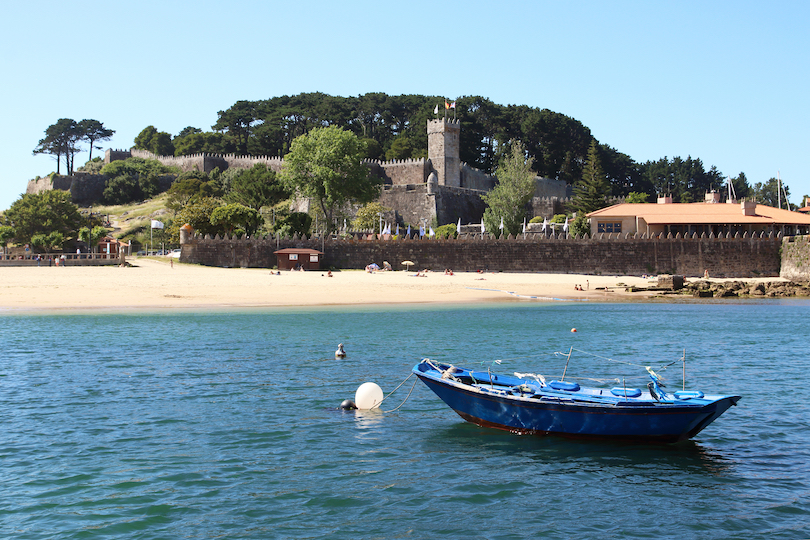
Baiona is a charming coastal town that takes you back in time.
Defined by its old town of quaint narrow streets and charming squares that showcase traditional Galician architecture, it is also known for its stunning beaches. One of their most popular, Playa de Ladeira, is an oasis of golden sand and calm waters, perfect for relaxation and water activities.
Elsewhere, the town’s most iconic landmark is the imperious Monterreal Fortress, a medieval 16th-century fortress crowned on a hilltop overlooking the sea. You will be impressed by its formidable walls and the stunning panoramic views of the Atlantic Ocean it presents.
If you head to Baiona’s harbor, you can also see a replica of the Pinta, one of Christopher Columbus’ ships, offering a glimpse into the town’s maritime history. Stepping aboard this full-scale replica gives you a real sense of what it must have been like for Columbus and his voyages exploring the New World.
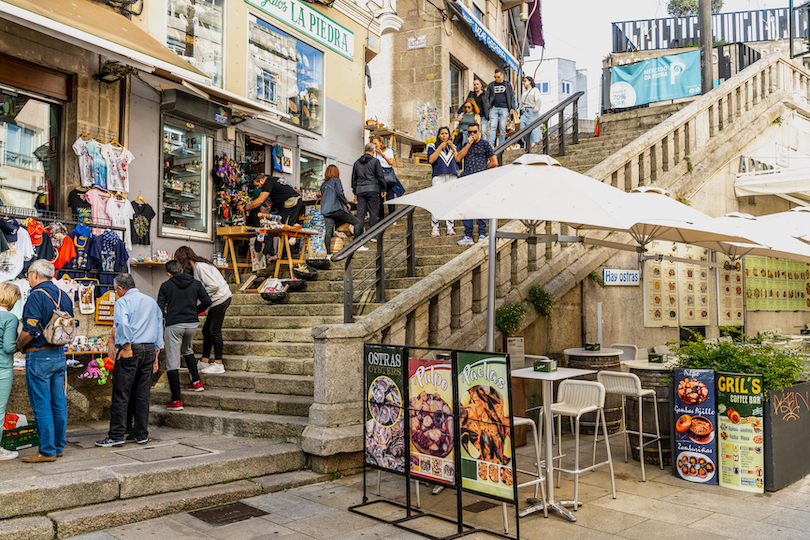
Spain has earned itself a reputation for having some of the best nightlife in Europe, and Vigo is a terrific place in Galicia to enjoy it.
Located in the province of Pontevedra, the bustling city has several exceptional nightclubs, bars and entertainment venues where you can carouse through the night.
It’s not all partying here, though. The city has some exceptional beaches, including Samil, one of the city’s most prominent and Candio, a great spot for surfing. It also has a fantastic dining scene, with many restaurants serving traditional Galician dishes such as octopus, mussels, and scallops.
Oyster Street in Vigo’s old town is famous for its fresh oysters and other seafood delicacies. We have enjoyed a couple of good meals at restaurants here.
Vigo has its fair share of notable landmarks, including the impressive 17th-century Castro Fortress. It also boasts world-class cultural attractions like the Museum of Contemporary Art (MARCO) and the Pinacoteca Francisco Fernández del Riego. Both exhibit a collection of works by Galician artists.
10. Cambados
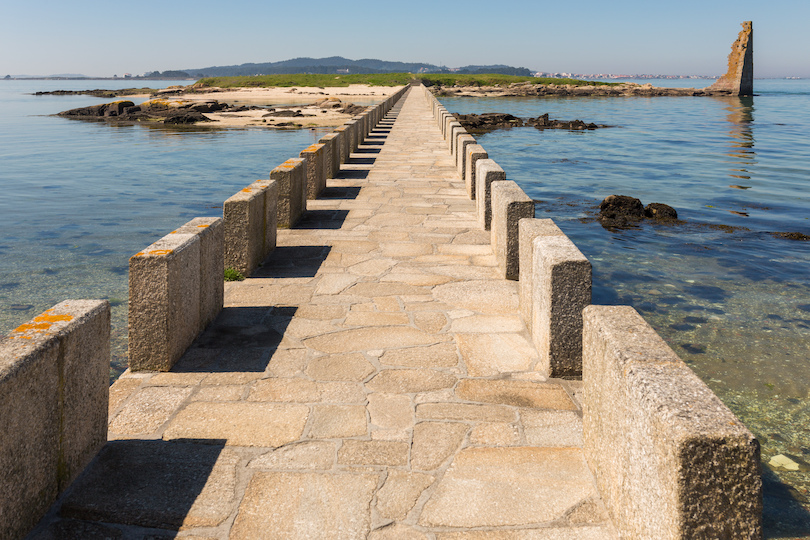
If you love wine and delicious seafood, you’ll want to visit Cambados in the Pontevedra province.
The town is part of the Rías Baixas Denomination of Origin, which produces some of the best white wines in Spain. Visitors can tour local wineries and taste some of their varietals.
You can order many of these wines in the town’s local restaurants and a delicious range of seafood dishes, including fresh fish, octopus, and mussels. If you are a foodie, try and time your visit with the Seafood Festival, which takes place every year in July.
Many of these restaurants reside in its historical center, full of beautiful, narrow streets and houses showcasing traditional Galician architecture. Tourists can explore it on foot and visit several historic landmarks, including the Ruins of Santa Mariña Dozo and the Church of San Benito.
If you are interested in history, you can visit the Fefiñans Palace. The palace was built in the 17th century and is one of the best examples of Galician Baroque architecture.
9. Sil Canyon
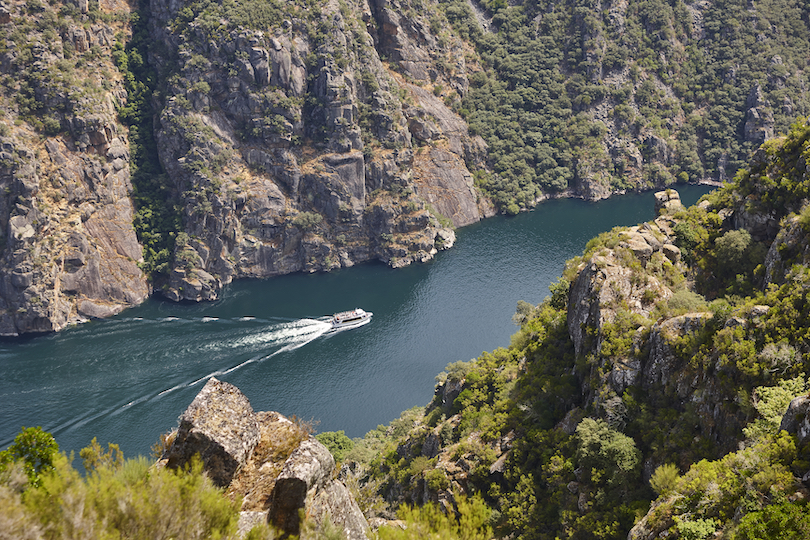
Sil Canyon is a breathtakingly beautiful canyon surrounded by stunning natural scenery.
A natural wonder, one of its main attractions is the river, which has carved out the canyon over millions of years. One of the most spectacular things to do in Galicia is to take a boat ride down and enjoy the stunning views of the canyon walls that soar on either side.
Alternatively, you can hike along several trails that present it from a different perspective and the surrounding countryside.
If you are interested in history, you can visit some of the local monasteries and churches in the area. One of the most famous is the Mosteiro de Santa Cristina de Ribas de Sil, which dates back to the 12th century.
Sil Canyon is also known for its vineyards and wine production, with several tours to cellar doors available.
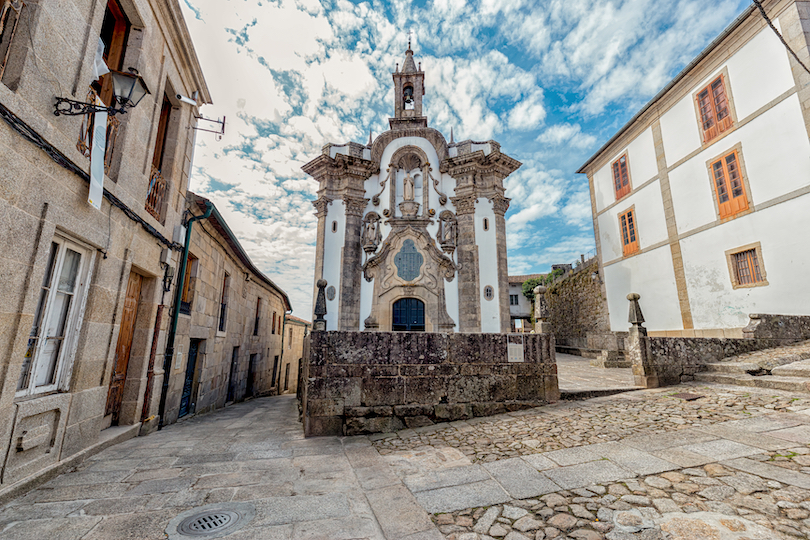
Situated on the banks of the Miño River, right on the border with Portugal, Tui is a charming Galicia town where history and tradition intertwine.
Known for its captivating medieval ambiance, the heart of Tui is its old town. You can spend hours wandering around a quaint labyrinth of narrow cobblestone streets, historic buildings, and picturesque squares.
Within it are charming boutique shops and delightful cafes offering delicious local specialties.
The grandeur of Tui Cathedral, with its Gothic and Romanesque architecture, dominates the skyline and serves as a symbol of the town’s rich past. If you explore the cathedral, you can better understand Tui’s history at the Diocesan Museum, which resides inside it. You will see religious art and artefacts there, providing insights into the region’s spiritual and artistic legacy.
7. Cabo Finisterre
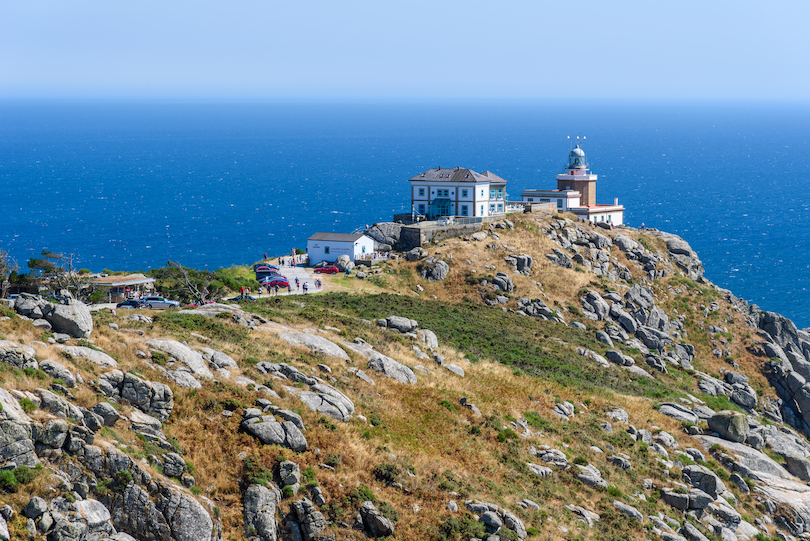
In Roman times, Cabo Finisterre was regarded as the end of the known world.
A place of mystique and natural beauty, it holds historical and cultural significance as the westernmost point of the Iberian Peninsula.
Visiting Cabo Finisterre is an awe-inspiring experience. The rugged cliffs that embrace the Atlantic Ocean create a dramatic backdrop, where waves crash against the rocks with relentless power. The panoramic views from the lighthouse at the cape’s summit are breathtaking, especially as the sun starts to sets over the vast horizon.
The surrounding area also features secluded beaches and hidden coves that you should take the opportunity to explore. At the same time, the nearby fishing village of Finisterre offers a glimpse into the local maritime culture, with its bustling port and several excellent fresh seafood restaurants.
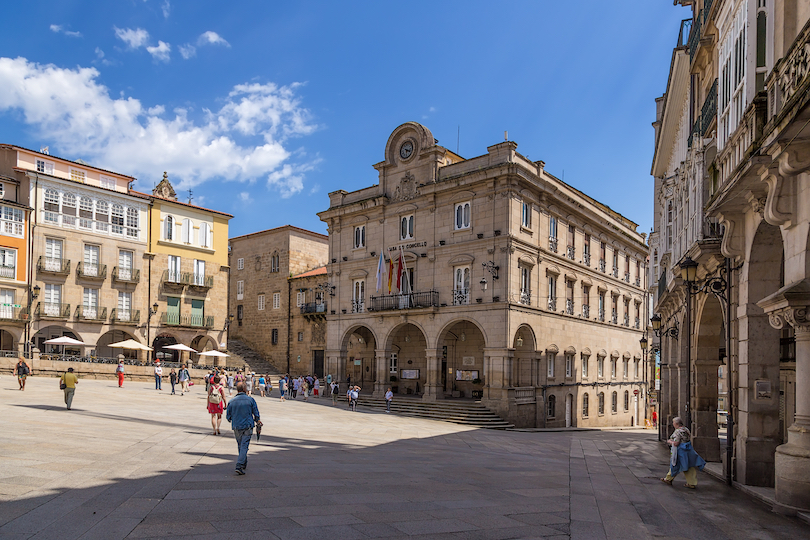
Situated along the Miño River’s banks, Ourense is a bustling city known for its hot springs and impressive architecture.
The Burgas is a collection of hot springs people have enjoyed for centuries, with thermal waters providing a rejuvenating experience. Tourists can relax in public pools or indulge in luxurious spa treatments. Either way, it is the perfect remedy for aching bodies after a long day of sightseeing.
As well as the hot springs, Ourense’s historic center also features several unique architectural treasures. One of the most impressive is Ourense Cathedral – a Romanesque gem dedicated to Saint Martin and notable for its intricate carvings and impressive façade.
Elsewhere, the Museum of Ourense houses an impressive collection of archaeological artefacts, religious art, and contemporary works. The city also has several attractive squares and a beautiful green space, Alameda Park, which showcases stunning city views.
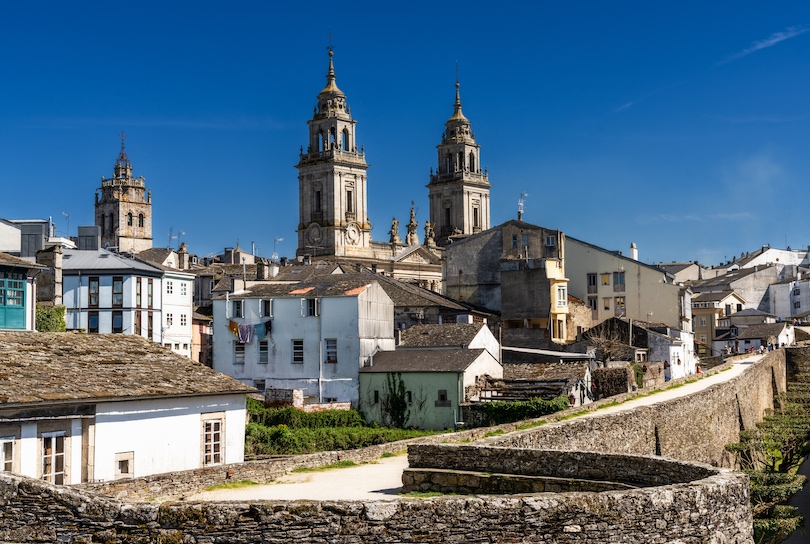
Lugo is a historic city best known for the incredibly well-preserved Roman walls that encircle its city center.
The impressive fortifications were built in the 3rd century, stretching over two kilometers. They are unique for being the world’s only fully intact Roman walls.
Walking along the top of the walls provides panoramic views of the city and a unique insight into the town’s ancient history.
You can also explore the charming old town within the walls, comprising narrow streets, medieval buildings, and beautiful squares. Be sure to check out the Cathedral of Lugo, which features Romanesque and Gothic elements in its exquisite architecture.
Lugo is also famous for the quality of its Galician cuisine. Traditional dishes such as pulpo a la gallega (Galician-style octopus) and empanadas (savory pies) are local specialties we have eaten in this fascinating place.
4. Cies Islands
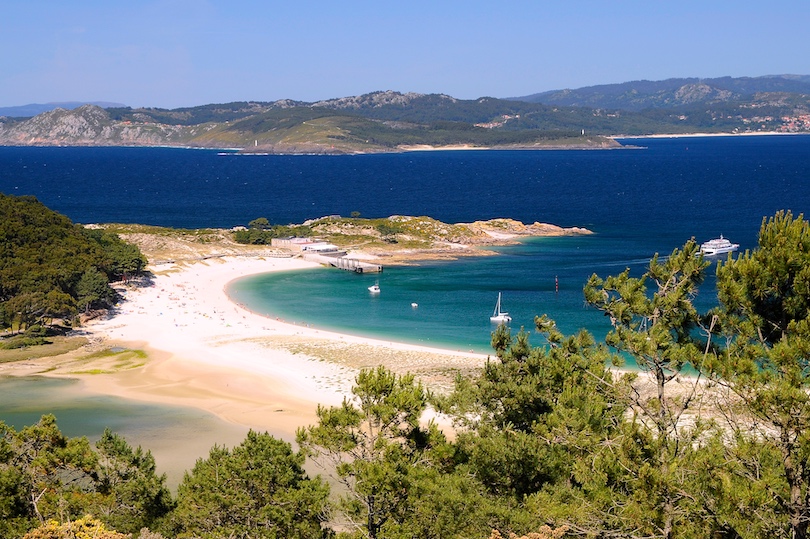
If you fancy a change of scenery from the mainland, the Cies Islands is a terrific place to go. Located off the coast of Galicia, these islands consist of immaculate white sandy beaches, crystal-clear waters, and unspoiled landscapes.
Comprising three main islands – Monteagudo, do Faro, and San Martiñ – they are a protected nature reserve, which is why they are so pristine.
Visitors can enjoy swimming and sunbathing at Rodas Beach, regarded as one of the best in Europe. Its turquoise waters are also popular with snorkelers and kayakers looking to explore the vibrant marine life.
Several hiking trails crisscross the islands, leading visitors through lush forests that offer stunning viewpoints. If you scale to the top of Monteagudo, that effort would be rewarded with sensational panoramic views. There you will see the shimmering waters of the Atlantic Ocean and the neighboring islands from the highest point of Cies Island.
3. A Coruña
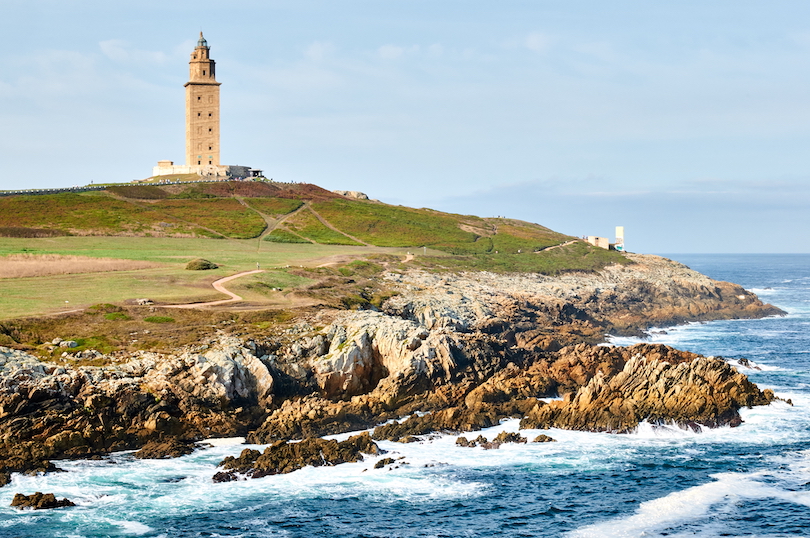
Situated on a picturesque peninsula, A Coruña is somewhere you should make a point of visiting. Boasting a stunning coastline and magnificent architecture, its long stretches of sandy beaches, including Orzán and Riazor, provide the perfect backdrop for relaxation and water sports.
Its lively waterfront promenade, the Paseo Marítimo, is a fantastic place to stroll and people-watch. At the same time, its historic center showcases a rich architectural heritage, with narrow streets filled with charming shops, cafes and buildings. They include María Pita Square, Concello da Coruña (town hall), and the 16th-century Castillo de San Antón, which impress with their design and craftsmanship.
However, top billing has to go to the city’s iconic landmark, the Tower of Hercules. An ancient Roman lighthouse, it stands tall as a UNESCO World Heritage site, and climbing to its top rewards visitors with spectacular views.
2. Santiago de Compostela
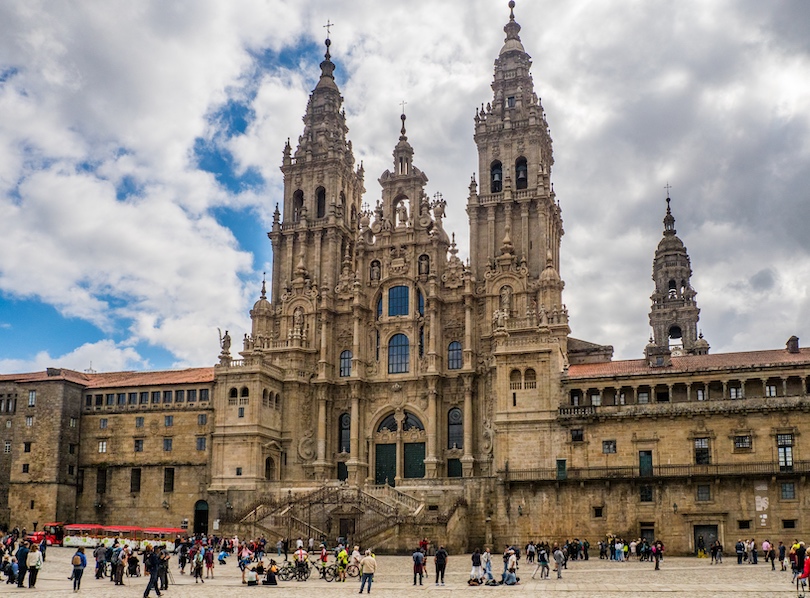
The capital of Galicia, Santiago de Compostela is a city steeped in history, spirituality, and architectural splendor. Renowned as the final destination of the Camino de Santiago pilgrimage, it attracts travelers from all four corners of the world.
The city’s centerpiece is undoubtedly the magnificent Santiago de Compostela Cathedral, a Romanesque, Gothic, and Baroque architecture masterpiece. Its grandeur is matched by the Plaza del Obradoiro, a square surrounded by impressive buildings that provide a captivating backdrop.
When exploring the winding streets of the old town, you’ll find charming squares, picturesque alleys, and historic buildings adorned with intricate facades. The atmosphere is vibrant and lively, with bustling markets, lively cafes, and street performers.
Santiago de Compostela is also a city of culture and art, with numerous museums, galleries, and cultural events that showcase its rich heritage. The Galician Center for Contemporary Art and the Museum of the Galician People are notable institutions to visit if you get a chance.
1. Playa de las Catedrales
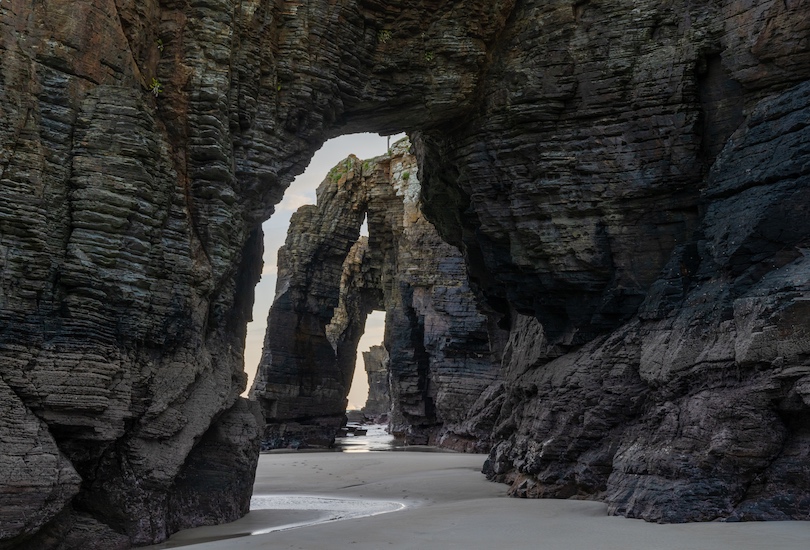
Playa de las Catedrales is a stunning coastal formation renowned for its majestic rock formations. Also known as the Beach of the Cathedrals, the natural wonder resembles a cathedral’s grand arches and vaults.
When we visited the beach, we were captivated by its intricate network of sea-carved cliffs and caves, which reveal themselves during low tide. These natural sculptures change with the tides and light, offering a different perspective whenever you look at them.
You could easily spend a few hours wandering along the sandy shore and passing through its fascinating rock formations, arches, and tunnels. The landscape is surreal and enchanting, especially with the sounds the ocean breeze makes. If you do go there, just be mindful of the changing tides.
Map of Places to Visit in Galicia, Spain
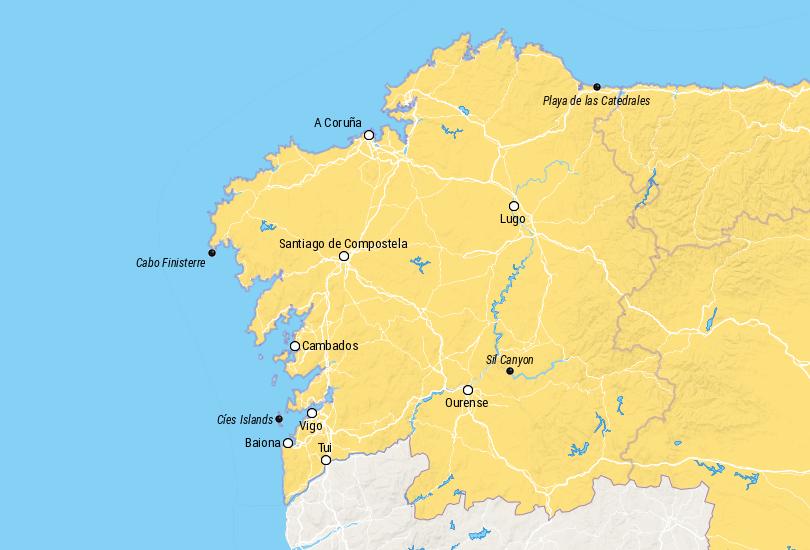
Share this post:
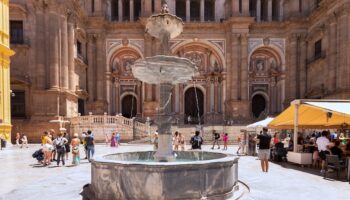
23 Best Things to do in Malaga, Spain
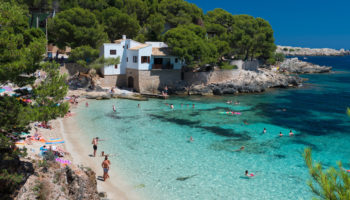
Where to Stay in Mallorca: 12 Top Destinations
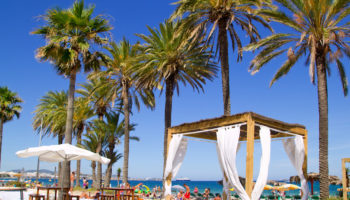
10 Best Places to Visit in Ibiza
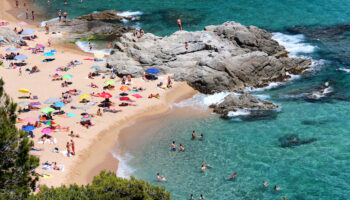
20 Best Beaches in Spain to Visit This Summer
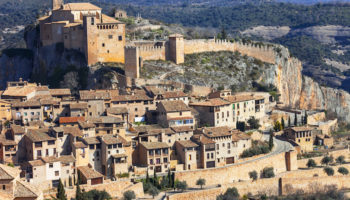
14 Most Enchanting Small Towns in Spain
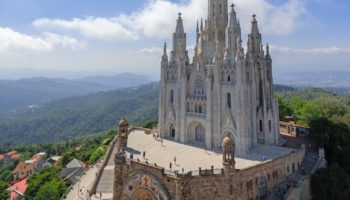
14 Most Amazing Churches in Spain
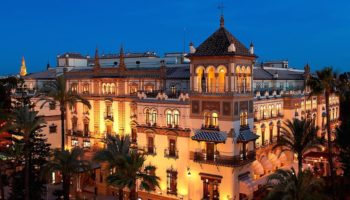
11 Most Amazing Hotels in Spain
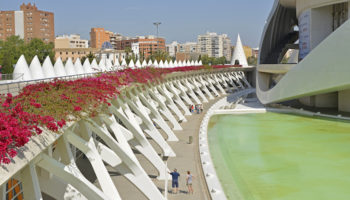
Where to Stay in Valencia: 7 Best Neighborhoods
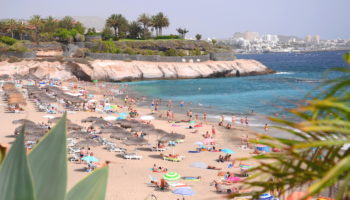
14 Best Places to Visit in Tenerife
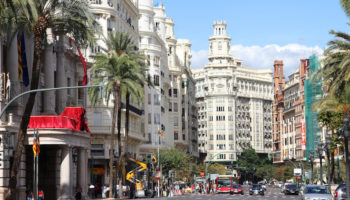
17 Best Cities to Visit in Spain
Reader interactions, leave a reply cancel reply.
Your email address will not be published. Required fields are marked *
This site uses Akismet to reduce spam. Learn how your comment data is processed .

30 best things to do in Galicia and places to visit
- Sofía Pozuelo
- UPDATED: 13/12/2023
In this post, you’ll become familiar with the best things to do in Galicia. In this region of Spain, you will find many beautiful cliffs, incredible lighthouses, amazing beaches and the best seafood on the planet. Also, centuries ago, many believed the world ended here! A good dose of nature, culture, history and gastronomy awaits you in Galicia.
Below you will find some of the most beautiful cities in Galicia, charming towns, beaches that will leave you speechless, archaeological remains and nature in its purest form. Enjoy!
Table of contents
Where to stay in galicia.

Before showing you the things to do in Galicia, I want to give you some advice on accommodation, since it is one of the most important steps when organizing a trip. You have to think about whether you are going to spend every night in the same hotel or whether you want to divide your stay between two or more bases.
It will depend on the duration of the trip, your preferences and whether you are going to focus on a specific area or want to visit the entire region. If you need help, I recommend you read my guide on where to stay in Galicia .
Boutique hotels in Galicia
If you want to stay in a charming hotel in Galicia, here are some recommendations:
Casa Lourido is one of my favorite hotels in Galicia. It is located on the outskirts of a coastal town called Sada, about 20 km from A Coruña. It is a family hotel in which everything is taken care of in detail. The rooms are spacious and furnished with all the essentials. The courtyard full of plants and flowers is just lovely.

Another very good looking hotel in Galicia is Cabañas Fisterra . It is in one of my favorite corners of Galicia, Fisterra, and the view from the private terrace is spectacular. The rooms are also very charming and include a kitchen and a Jacuzzi. They also offer various activities and massages as well. It is the perfect place to stay if you are visiting Costa da Morte.

I also recommend Hotel Quinta de San Amaro . It is located in Meaño Valley, in Pontevedra’s countryside. This hotel is a perfect place to relax and unwind and visit Rías Baixas. It has a garden and swimming pool with a very beautiful view. This hotel also offers a free visit to Albariño winery, which includes a tasting. Pets are allowed.
Things to do in Galicia
Ready to get to know the best places to visit in Galicia? Let’s begin!
🚗 Do you need to rent a car for your trip to Galicia? I recommend checking out Discover Cars , a highly-rated car rental search platform. I have used it several times and it has always been great!
1. Cies Islands, one of the best places to visit in Galicia

The Cies Islands are an archipelago in the province of Pontevedra. It is one of the most popular places in Galicia and a destination that any tourist who visits Galicia should visit. The three islands are Monteagudo, do Faro and San Martín. They stand out for their fine sand beaches and crystal clear waters. One of the most beautiful places in the Cies Islands is Playa de Rodas.
If you’re interested in visiting the islands, you must request an authorization on this website. However, if you book your ferry to the Cies Islands here , they’ll take care of transfers and provide you with the authorization. Less things to worry about!
2. Cathedrals Beach (Lugo), it’ll leave you speechless

This beach is one of the most popular and impressive beaches in Galicia for good reason. It is an authentic natural monument. Cathedrals Beach is located in the Ribadeo region, in the province of Lugo. What makes this beach so incredible is its incredible arched rock formations. You don’t want to miss the Isla Pancha Lighthouse, located near this beach.
Keep in mind that in order to visit Cathedrals Beach, you have to make an entrance reservation. You can make a reservation on this website . If you want to visit this place in a different way, have a look at this boat ride along Cathedrals Beach .
3. Combarro (Pontevedra), a charming town you worth visiting

This town is not only one of the most beautiful places to visit in Galicia but also one of the most charming towns in Spain according to many. Combarro is a very picturesque fishing village where you can see numerous granaries (traditional buildings on columns designed to preserve food) and cruceiros (stone crosses). If you want to know a bit more about the history of this Galician town, do not forget to stroll through its historic center.
4. Visiting Santiago de Compostela, one of the best things to do in Galicia

A trip to Galicia isn’t complete without including a visit to Santiago de Compostela, one of the most beautiful cities in Spain . One of the best places in the city is Santiago de Compostela Cathedral, where the famous “Camino de Santiago” ends. I suggest you to take this guided tour of the cathedral . You should also visit San Martiño Pinario Monastery, Alameda Park and the Abastos Market.
I also recommend joining this free tour of the historic center . You will learn very interesting historical and cultural facts. If you want to spend the night in the city, don’t miss my post on where to stay in Santiago de Compostela .
5. Fisterra (A Coruña), ready to get to know the end of the world?

Fisterra is located in Costa da Morte (Death Coast). The Romans thought it was the westernmost point on earth, hence its name. You will see many pilgrims walking from Santiago de Compostela to Cape Finisterre. I recommend going for a walk through the historic center and visiting the Cape Finisterre Lighthouse.
As for beaches, you definitely don’t want to miss Mar de Fóra, a spectacular beach. I recommend going for sunset!
6. Do Sil Canyon – Ribeira Sacra, a natural wonder in Galicia

Ribeira Sacra is located in the southern area of Lugo, north of Ourense province. Its a place where the banks of the Cabe, Sil and Miño rivers meet. I recommend visiting Do Sil canyon. If you are going to visit this part of Galicia, I recommend taking a look at the Ribeira Sacra tourism website where you’ll be able to find information about the place. If you prefer joining an organized tour, take a look at all the guided tours available in the Ribeira Sacra .
7. Santa Comba Beach (A Coruña)
It is not very known by tourists; however, it is one of the most beautiful beaches in Galicia. Santa Comba Beach is located about 12 km away from Ferrol. Its turquoise water and surrounding nature makes this beach one of the best beaches in Galicia. There is a church on one of the cliffs near the beach.
8. A Coruña, don’t miss Hercules Tower

A Coruña is a city in Galicia that should be on your itinerary if you’re going to visit the northwestern part of Spain. After taking a walk through the historic center, I recommend visiting the Tower of Hercules, one of the best places to visit in Galicia. Rosa Dos Ventos is located near the tower. You don’t want to miss it!
Other places to visit in A Coruña are Plaza Maria Pita, the San Pedro viewpoint, Port of A Coruña and the San Anton castle. I recommend taking a look at all the guided tours in A Coruña .
9. Roman wall of Lugo

One of the most interesting places to visit in Galicia is the Roman Wall of Lugo. The wall, more than 2 km long, surrounds Lugo’s historic center. It has a total of 85 towers, of which 71 are preserved today, and 10 gates. Don’t miss “Puerta de Santiago”. The best way to get to know the wall is by walking in the area.
Another interesting place to see in Lugo is the Cathedral of Lugo. If you want to get to know the city better, I recommend taking a free tour of Lugo .
10. Costa da Morte, a must see place in Galicia

Although I’ve already mentioned Fisterra, Costa da Morte has plenty of places to visit. Some of the places that you cannot miss on your visit to this part of Galicia are Cascada del Ezaro, Cabo Vilan-Camariñas, Carnota Beach, Laxe Beach and Touriñan Lighthouse. I recommend road-tripping through this part of Galicia.
🏥 Remember it is very important to purchase travel insurance for Spain if you don’t have medical coverage in this country. I always use and recommend the company Heymondo, where I can offer you a 5% discount on your travel insurance .
11. Cambados (Pontevedra), a charming town in Galicia

Cambados is a charming town in Pontevedra worth visiting. Apart from being the capital of Albariño, it has many beautiful corners worth visiting such as, Santa Mariña Dozo ruins, Fefiñáns Square, A Pastora viewpoint and San Sadorniño tower. Don’t forget to visit Lanzada Beach as well as Siradella viewpoint, located 20 kilometers from Cambados. The view is incredible.
12. Tui (Pontevedra), don’t forget to visit the cathedral

Tui is one of the most beautiful towns in Galicia. It has 17,000 inhabitants and is located in the province of Pontevedra, near the Portuguese-Spanish border. One of the most popular cathedrals in Galicia is located in Tui, the Cathedral of Santa Maria de Tui. It is romanesque and gothic in style.
After visiting the town, you can take a walk through Mount Aloya, located in the outskirts of the city.
13. Santa Trega Mountain (Pontevedra), one of the best viewpoints in Galicia

Santa Trega mountain is located in La Guardia which is southeast of Pontevedra. One of the most beautiful places to visit in this area is Castro de Santa Trega which is an archaeological site once part of a Castrexo-Roman town inhabited between 4th century BC and 1st century AD. Don’t forget to enjoy the incredible view from Santa Trega Mountain viewpoint. I recommend visiting the viewpoint locates in Facho Peak and San Francisco Peak.
14. Ourense, don’t forget to visit the hot springs

The city of Ourense is also worth visiting during your trip to Galicia. You can walk through its beautiful historic center and enjoy its amazing restaurants. One of the best activities in Ourense is visiting the hot springs. Some of the most popular ones are As Burgas, in the center of the old town, and Outariz hot spring.
Don’t forget to visit the Cathedral of Ourense, the medieval bridge of Ourense, Plaza del Hierro, San Lazaro Park and San Francisco Convent.
15. Visiting Souto da Retorta, one of the best things to do in Galicia

Souto de Retorta, also known as the Chavin eucalyptus, is a eucalyptus forest located in the province of Lugo. Avo, which is one of tallest eucalyptus specimens on the continent can be found in Souto da Retorta. Avo was planted in 1880 and measure 67 meters high. There is a 2 km marked route to make the walk easier. It takes about an hour to hike the trail.
16. Castro de Baroña, beautiful place to visit in A Coruña

You can visit many famous forts throughout Galicia. These forts are fortified towns where the inhabitants of Galicia took refuge during the wars. One of the most spectacular forts is Castro de Baroña which was built on rocks next to a beach. It was occupied between the 1st centuries BC and 1 AD. A total of 20 houses of circular or oval shape were preserved.
17. Mondoñedo (Lugo), one of the most beautiful towns in Galicia

Mondoñedo, located in the province of Lugo, is one of the best places to visit in Galicia. It was once the capital of one of the 7 provinces from the Old Kingdom of Galicia. Mondañedo Cathedral is one of the best places top visit in town and one that you should visit. The cathedral is of roman-gothic style. You must visit the historic center of town and taste some of the tasty food. Rei Cintolo Cave, located near Mondoñedo, is also a place worth visiting.
18. Loiba Bench, one of the best viewpoints in Galicia

Loiba Bench is known as one of the most beautiful benches in the world. It is located in Coitelo Viewpoint, on the Loiba cliff (Ortigueira). You can enjoy wonderful views of the entire area, which extends from Cabo Estaca de Bares to Cabo Ortegal.
19. San Andres de Teixido, a well known place among pilgrims

San Andrés de Teixido is a village located east of Cedeira region, in A Coruña. The sanctuary of San Andrés de Teixido is located in this village. The sanctuary is a famous pilgrimage site. I recommend visiting this sanctuary as it has historic importance. The sanctuary is also beautiful.
There is a legend in this place that says “vai de morto quen non foi de vivo” (they who did not visit alive will visit when they are dead), so if you don’t go now, don’t worry. You will visit this town regardless!
20. Os Ancares, a unique place to visit in Galicia

If you want to get lost in nature, I recommend visiting Sierra de Os Ancares, located east of Lugo. You can hike several trails that cross valleys and peaks of up to 2,000 meters. Some of the most beautiful places in Os Ancares are Doiras castle, the Palloza Museo Casa do Sesto, the village of Piornedo, O Cebreiro and Balboa castle.
21. Cape Ortegal, one of the most beautiful lighthouses in Galicia

If you are interested in visiting some nice cliffs, you don’t want to miss Cabo Ortegal which is located in the province of A Coruña. There are two visiting points: Punta dos Aguillóns, where Cape Ortegal Lighthouse is located, and Punta do Limo. The sea of Cantabria and the Atlantic Ocean meet in Punta dos Aguillón. Near Cape Ortegal, I recommend visiting Ortigueira and Cariño. Da Miranda viewpoint is also worth visiting.
22. Muros (A Coruña), a charming town in Galicia

Muros is one of the best places to visit in A Coruña, Galicia. It’s a fishing town located in A Coruña, north of Rias Baixas. Aside from being able to enjoy its rich gastronomy, you’ll be able to walk along its old streets and its amazing boardwalk along the coast. I recommend visiting Area Mayor Beach (Louro) and Carnota Beach.
23. Visiting Corrubedo Dunes, one of the top things to do in Galicia

Corrubedo Natural Park is a must-visit place in Galicia, especially if you’ve never visited sand dunes in the past. The dune of Corrubedo is 1 km long, 250 meters wide and 20 meters high. The national park is home to Corrubedo beach, Vixán lagoon (fresh water) and Carregal lagoon (salt water).
Around 3,000 aquatic birds live in this natural space. There is a network of paths and walkways in the park. There is also an interpretation center of Galicia’s litoral ecosystem.
24. Vixia de Herbeira Cliff, an incredible landscape in Galicia

Vixia de Herbeira cliffs are amongst the most beautiful cliffs in Galicia. They are located in A Capelda mountain range, near Cariño (A Coruña). The cliffs are about 615 meters above sea level. They are amongst the highest cliffs in Europe which provide an amazing view. I highly recommend visiting Vixia de Herbeira Cliff.
25. Allariz (Ourense), don’t forget to visit this bridge

We continue with this compilation of places to visit in Galicia with Allariz, located near Arnoia River. The old part of town and the nature in it have made this little town one of the most beautiful towns in Galicia. The most interesting places to visit in Allariz are Church of Santiago de Allariz, Church of Santa María de Vilanova and the Convent of Santa Clara.
One of the most picturesque places in Allariz is the Romanesque Bridge of Vilanova, which was once the entrance to Allariz.
26. Fragas de Eume, a perfect place for nature lovers

If you like nature, you must visit Fragas do Eume (A Coruña). It is one of the best preserved riverside Atlantic forests in Europe. It has a total of 9,000 hectares where you’ll be able to walk and visit. You will be able to see poplars, oaks, alders, ash trees, around 28 species of ferns and about 200 species of lichens. Insane!
Inside the reserve, you can visit Caaveiro Monastery, a place worth visiting. It is, without a doubt, one of the most incredible landscapes in Galicia.
27. Ezaro Waterfall (A Coruña), a unique place in Galicia

Although I have named this popular waterfall in the Costa da Morte section, I think it deserves its own section. Ezaro Waterfall, located in A Coruña, has become one of the most visited places in Galicia for being one of the few river mouths in the form of a waterfall in Europe. It has a 80-meter drop.
One of the best ways to visit this place is taking a kayak tour around the waterfall .
28. Pedra Negras, one of the best beaches in Galicia

If you want to take a walk along a beautiful wooden walkway that will take your breath away, you have to visit San Vicente do Mar, located in Pontevedra. Pedras Negras route will only take about 30 minutes to complete. You will discover some of the most beautiful beaches in Galicia during the hike. The hike is from Porto Deportivo San Vicente do Mar to Con Negro area.
29. Betanzos, Galicia (Spain)

If you wish to visit more charming villages, I recommend visiting Betanzos, located in A Coruña, approximately 25 minutes away from the province’s capital. The old part of town, which was the capital of one of the 7 provinces that made up the Kingdom of Galicia, was declared a Historic-Artistic Site.
Don’t miss Pasatempo Park, Santa María del Azogue church and Pazo de Mariñán. If you visit during lunch or dinner time, let me remind you that potato-omelette tapas are very popular and tasty in this part of Spain.
30. Ribadavia (Ourense), a town with plenty of history

The last place on the this list of the best places to visit in Galicia is Ribadavia. It is one of the most beautiful towns in Ourense. I recommend visiting Castelo de Ribadavia (residence of the Counts of Ribadavia until the seventeenth century), the Ethnological Museum of Ribadavia, the Ribadavia Jewish medieval quarter and Plaza Mayor.
💳 To get cash in the local currency of your destination or pay by card, I recommend getting the N26 card . With the free version you can withdraw cash from ATMs with a very low commission and pay in another currency with the best exchange rate and no commissions.
Map of places to visit in Galicia
In the following map of Galicia you can find the 30 must-see places in Galicia. It will be easier for you to plan your visit and know what to do in Galicia.
Are you traveling to more places in this beautiful country? Do not miss my Spain travel guide .
I hope this post about the best things to do in Galicia has been very useful and has helped you plan your visit to the northwestern part of Spain. If you have any questions or concerns, I encourage you to leave a comment, contact mr though social media or by email. Until next time, travelers!
- PLAN A TRIP STEP BY STEP
↠ Book free tours and guided visits on Civitatis or GetYourGuide . I always use these platforms to check what organized activities there are at my destination.
↠ To pay with card in foreign currency or withdraw money from ATMs, I always use this card (there are free and paid plans). It works the best!
↠ Traveling with travel insurance to a destination where you don’t have healthcare coverage is a must. Get your insurance 5% cheaper with this link .
↠ If you want to have cellphone data at your destination from the moment you land and don’t want to waste time, there is nothing like this eSIM . Use the code “comeamaviaja” for a 5% discount.
↠ Check out Booking’s offers , a platform I always use, as I always find very good options thanks to its search engine with filters.
↠ For destinations where I need to rent a car, I always check Discover Cars and Auto Europe search engines. I recommend them!
↠ If you still need to buy flights for your trip, there is no better search engine than Skyscanner (although I always recommend booking the flight on the company’s website).
RELATED POSTS

2 Responses
I was organising my upcoming trip for North of Spain and it was honestly hard to find good recommendations. But I found amazing ones for Asturias and Galicia in here. A great mix between towns, historical attractions and nature. Kudos!
Thank you so much for your comment! I am very glad that I was able to help you! Enjoy your trip to Northern Spain!! 🙂
Leave a Reply Cancel reply
Your email address will not be published. Required fields are marked *
Save my name, email, and website in this browser for the next time I comment.

- Travel Tips
- Top 10 beautiful places you must see in Galicia, Spain (with photos)
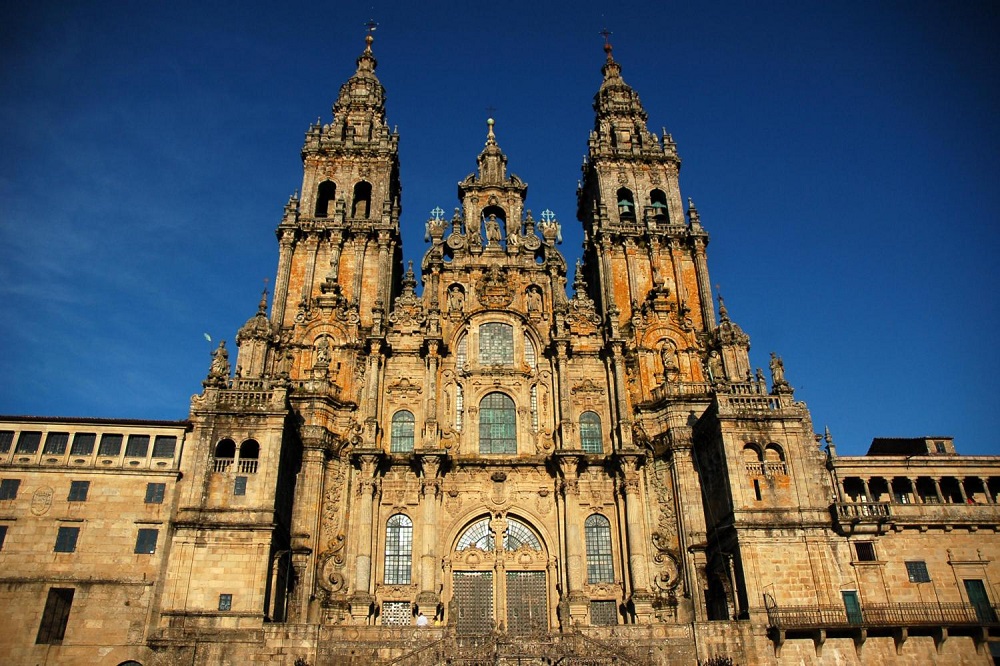
Galicia is an autonomous region that lies in the Northwest of Spain, above Portugal. It is an ideal destination for spending your vacation. It has lush green, historic cities, stunning coasts, and beautiful beaches .
Here is our list of the top 10 beautiful places you must see in Galicia.
1- The Santiago de Compostela Cathedral:
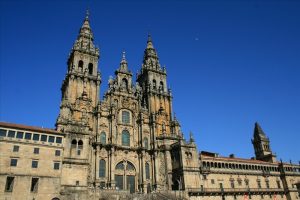
The Santiago de Compostela Cathedral is a world-renowned pilgrimage and World Heritage site in Galicia. Moreover, it is the principal Catholic center in the world-famous for the St. James Way. Besides, this cathedral is a mix of an original Romanesque, later Gothic, and baroque style. Since the Early Middle Ages, it receives more pilgrims, and it marks the traditional end of the pilgrimage route.
The spot is a magnificent landmark, not only in Galicia but also throughout Spain. You can climb the rooftops of the Santiago Cathedral. And enjoy the picturesque and breathtaking views!
2- Cape Finisterre:
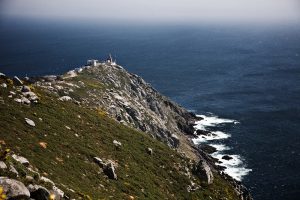
Cape Finisterre situated Peninsula on the west coast of Galicia, Spain. It is only about 90km west of Santiago de Compostela.
This rock is the final destination for many pilgrims of the Way of St. James. Besides, the geographical location and beautiful sunset of Cape Finisterre is just a thrill. For both its beauty and legendary.
The Romans believed that the cape is the end of the world. Besides, there are many rocks in this spot associated with the legends like the holy stones, the stained wine stones, and the stone chair. Additionally, there is a lighthouse, which is one of the best lookouts in the region where you can see the ocean, the coast, and everything else.
3- Tower of Hercules:
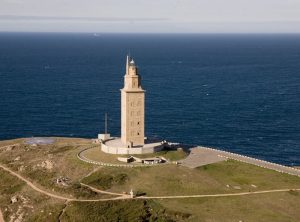
The Tower of Hercules is a lighthouse that looks over the Atlantic Ocean to a Coruña’s harbor, northwest Galicia.
This beautiful lighthouse awarded the Roman World Heritage site. Built-in the 2nd century and reconstructed in 1791. It has 55 meters high and overlooks the North Atlantic coast of Spain. It aims to help navigation along the rugged Galician coast, a strategic point on the sea route linking the Mediterranean to northeast Europe.
You can climb to the top of this imposing tower. To discover breathtaking views of the deep blue, powerful Atlantic waves. At night, the tower’s lights scan the ocean’s surface and shine out into the sea.
4- Cíes Islands:
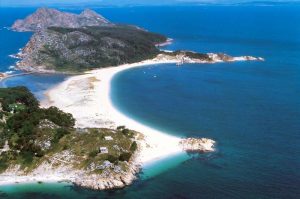
Cíes Islands are a small paradise lie in the Rías Baixas estuary of Vigo on the coast of Pontevedra in Galicia. It is an ideal destination for holidays. Besides, it is known for beautiful white sandy beaches, crystal, clear waters, and hiking trails for all levels.
These magnificent islands declared a natural park in 1980. There are three different islands. First, is Monteagudo Island is separated by a narrow channel from Cabo Home. Second is Faro Island that sits in the middle. Last is San Martiño, known as the South Island.
The first two islands are connected by a long spit of sand, forming a boomerang shape called Rodas beach. It has a natural lagoon just behind it. Besides, these islands are not limited to Rodas beach. They also have one of the best bird observatories in southern Galicia and a magnificent camping area.
5- Monte Santa Trega:
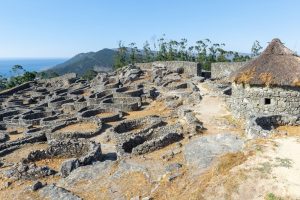
Santa Trega mountain is a must-see attraction in Galicia. It has a natural scenic overlook with picturesque and superb views of the Miño River Estuary, Portugal, the O Rosal valley, and the Atlantic Ocean.
The mountain offers different viewing points that allow admiring the environment in detail. Two mountaintops are noticeable at the top of the peak. The first is called O Facho, with 328 meters in height. Additionally, it offers a broad panoramic above the O Rosal valley. The second provides magnificent panoramic views with a 341 meters height called San Francisco peak.
Moreover, the forest hides an archaeological site called the Castro of Santa Trega. Situated on the hillsides of Mount Santa Trega and overlooking the mouth of the river Miño. In 1931, it was declared a National Historic and Artistic Monument and was considered a Place of Cultural Interest.
6- Forests Eume:
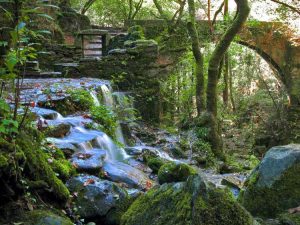
Forests Eume is a puzzling forest where the light comes always veiled. It is one of the best-preserved riverbank Atlantic forests in Europe. These forests stretch along the river that bears the same name. Besides, its shape as a triangle whose borders would Pontes, Pontedeume, and Monfero.
This natural forest follows the course of the river Eume. Besides, it is one of the best examples of a warm rainforest. With a different array of trees like oak, poplar, ash, and alder. As well as, more than 20 species of lichen and 200 ferns.
This mysterious forest hides 10-centuries of the history of an old monastery of Saint John of Caaveiro. As well as one of the best things you can do is hiking through the very dense forest. And enjoy all the shades of green you can imagine.
7- Abanca-Riazor Stadium:
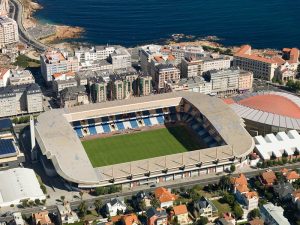
If you are a lover of football, you should visit the Riazor stadium. It was reconstructed, in the early 1940s because it became small for the club and opened in 1944.
Riazor stadium has seats for 34,600 spectators. It hosted main sporting events, including the Spanish Cup final in 1947. And the World Cup final in 1982. As well as it had a running track, and therefore regularly hosted athletics events.
The stadium is both structurally impressive and replete with history, making it a must-see for visitors in Galicia.
8- Muralla Romana:
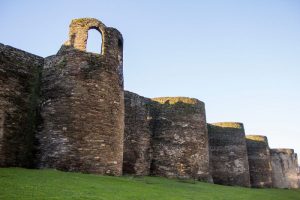
The walls of Lugo are an outstanding example of Roman military fortifications in the World. It was declared a UNESCO World Heritage Site. Additionally, they were built in the 3rd century and enclosing the town itself to protect the Roman city of Lucus.
This fascinating architectural structure extends 2 kilometers, with ten doors and 85 towers. The wall surrounds the historical and cultural heritage of the city. It is worth visiting the interior of these defensive walls.
9- Cathedrals Beach:
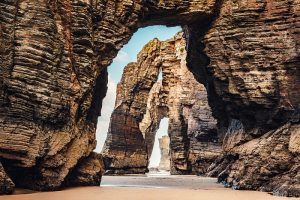
It would be a shame to talk about the must-see attractions in Galicia and not mention Cathedrals Beach.
This incredible beach is one of the most popular destinations of Lugo. It is located 10 km west of Ribadeo, in the northern shore of Galicia.
This rock was formed by the natural erosion of the cliffs that creates the arches and caves. However, you can see this outstanding rock only at low tide.
10- Serra da Capelada:
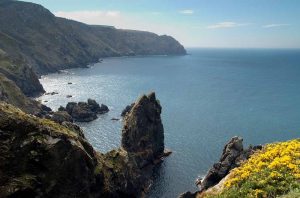
Serra da Capelada has some of the tallest cliffs in Europe. The highest one is Vixía Herbeira has 620 meters above sea level. The cliff provides spectacular views with a picturesque panorama of the giant Atlantic Ocean. And the rough coastline on either side of Santo André.
Related posts:
Recent posts.
- Get ready for Granada International Festival of Music and Dance
- All you need to know about Patum Festival in Berga , Spain
- The Jerez Horse Festival: Get ready for an amazing experience
- Córdoba Patio Festival: Discover the Magic!
- Top 9 best monuments to discover in Avila, Spain
Popular posts
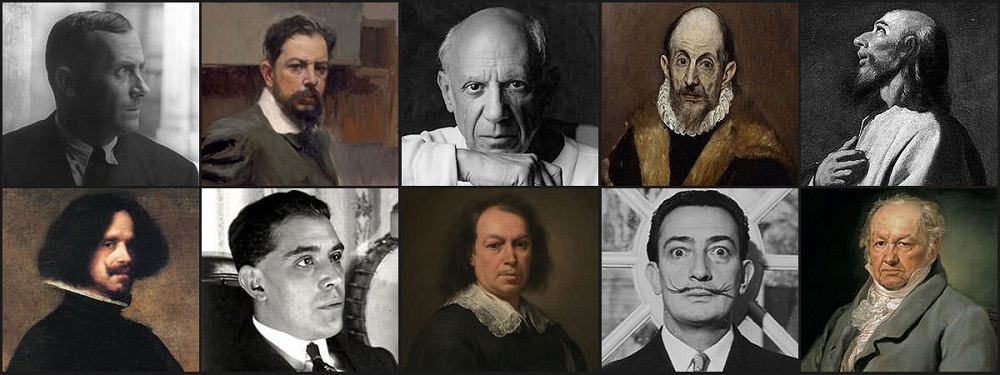
- February 2024
- January 2024
- December 2023
- November 2023
- October 2023
- September 2023
- February 2023
- January 2023
- December 2022
- November 2022
- October 2022
- September 2022
- February 2021
- January 2021
- December 2020
- October 2020
- September 2020
- August 2020
- February 2020
- January 2020
- December 2019
- November 2019
- October 2019
- October 2018
- September 2018
- November 2017
- October 2017
Pin It on Pinterest
Join my Adventure: There's Room in My Backpack
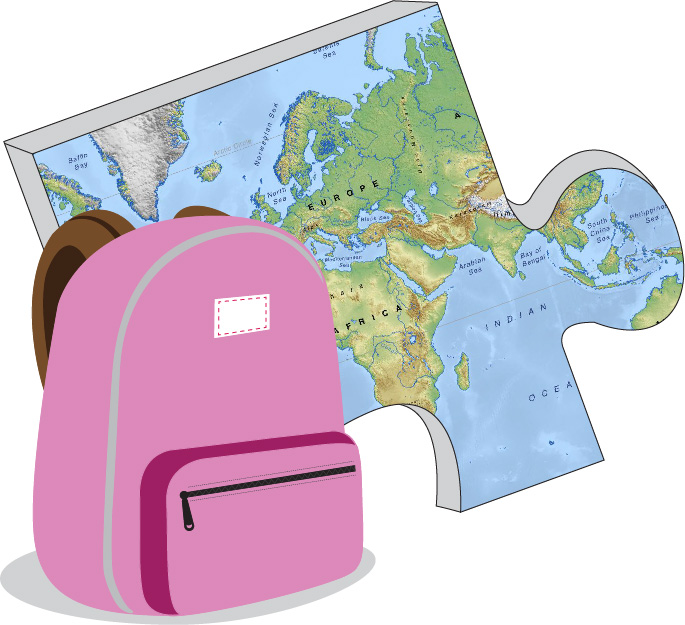
Packing up the Pieces

15 Incredible Things to Do in Galicia Spain
Galicia may be one of the most underrated regions in Spain. This lush region in Spain is rich in culture with a tribal Celtic past, was included as part of the Roman Empire, and today houses the ending point of Europe’s grandest pilgrimage, the Camino de Santiago.
Galicia is part of Green Spain and is blessed with enchanted forests, incredible biospheres, and a dramatic and wild coastline. There are unique estuaries, in both the low and high regions. With a fascinating history and untouched landscapes, there are many incredible things to do in Galicia Spain.
All pilgrims waking the life-changing Camino de Santiago will walk through Galicia upon their arrival to Santiago de Compostela. Whether you’re walking or simply savoring the beauty, Galicia is a must-visit destination in Spain.
These are some of my favorite places in Galicia Spain. Included in this guide are tips about visiting Galicia, the best things to do in Galicia, a sample Galicia Itinerary, and highlights of this extremely underrated region.
This is my ultimate guide for what to see in Galicia Spain.
Table of Contents
- Where is Galicia Spain?
- The Absolute Best Things to Do in Galicia Spain
- More Places to See in Galicia
- Quick Galicia Itinerary for First-Time Visitors
- Is Galicia Worth Visiting?
- Conclusion | Incredible Things to Do in Galicia Spain
Where is the Autonomous Community of Galicia?

Green. Spiritual. Enchanting. These three words resonate with me when I let my mind wander to one of my favorite places in Spain, Galicia.
When visiting Galicia Spain, it almost feels like stepping into another country. Long gone are the typical stereotypes of Flamenco and Moorish architecture. Galicia can feel almost mysterious and at a glance, have stronger ties to Ireland than Spain .
The autonomous community of Galicia is located in the Northernmost corner of Spain.
North of Galicia, find the Cantabrian Sea that eventually flows to the Celtic Sea and its distant northern neighbor Ireland. South of Galicia is Portugal , with the Minho River acting as a natural border. Galicia also borders the Spanish autonomous communities of Asturias, Bierzo, and Castile and León to the east. The entire west coast of Galicia is spoiled to be on the Atlantic Ocean. That’s almost 1,000 miles of coastline just on Galicia’s west side!
The Galicia region is classified into four provinces , Lugo, Ourense, A Coruña, and Pontevedra. Digging deeper, Galicia has several recognized natural areas including the picturesque Rías Baixas to the Ribeira Sacra.
What is Galicia Famous For?

Besides its natural gems, Galicia is famous for its unique cultural aspects.
There is the Galician Gaita, a traditional instrument that is similar to the bagpipes of Scotland and Ireland. More so, Galicia has its language, Galego which can be described as a Latin language somewhere between Portuguese and Spanish.
When visiting Galicia there is no shortage of sacred sites from the Celtic culture. In fact, it was believed that the original Camino route was an ancient pathway that followed the Milky Way and was used as a sacred fertility journey. Many Castro ruins can be visited throughout Galicia.
Perhaps what Galicia is most famous for is being the ending point of the Camino de Santiago pilgrimage route of Saint James. Thousands of pilgrims arrive each month to stand in front of one of the most impressive cathedrals in Spain , the Cathedral de Santiago de Compostela. Pilgrims can choose from many starting points and walk hundreds or thousands of miles across Spain and beyond.
Spanish tourists know that Galicia is blessed with some of the best beaches in Spain, even if the water is cold.
These are some of the most unmissable and my favorite places to see Galicia Spain.
1 | Explore Santiago de Compostela

Santiago de Compostela is Galicia’s lively capital city. The Old Town in Santiago is a recognized UNESCO World Heritage Site and has a plethora of religious historical sites. By far the most famous site in Santiago is the Cathedral de Santiago de Compostela, which is said to hold the relics of Saint James.
For this reason, Santiago de Compostela is the end of the famous Camino de Santiago pilgrimage route.
Whether you’re a pilgrim or not, there are plenty of things to do in Santiago de Compostela . As one of Spain’s most beautiful cities, it’s easy to enjoy the many attractions that the city offers.
Visit the Cathedral de Santiago de Compostela and maybe attend a mass to see if the giant Botafumeiro swings from the ceiling. A guided tour allows for a chance to see the Portica de Gloria entranceway, just make sure to add the extra admission ticket.
Spend some time in Praza do Obradoiro to celebrate with pilgrims who have just completed their personal Camino de Santiago journey. Energetically, there is no place in the entire world like this plaza.
Foodies can delve deep into the rich cuisine of Galicia. For tapas and casual pickings, wander the street of Rúa do Franco. Don’t miss fresh seafood tapas and sampling pulpo (octopus). Mercado de Abastos is another culinary delight to experience in Santiago de Compostela. Numerous restaurants offer a daily menu and you can even find restaurants boasting a Michelin-star.
Santiago de Compostela boasts plenty of green spaces and parks. Find numerous museums and sites to explore. One of the best things to do in Santiago de Compostela is simply wander the streets and explore the hidden plazas. There are also numerous viewpoints in Santiago de Compostela that showoff its alluring beauty.
With so much to see and do, Santiago de Compostela warrants at least a few days. There are also numerous day trips from Santiago de Compostela , making it an ideal place to sleep and base.
2 | Walk the Camino de Santiago

Any pilgrim walking the Camino de Santiago will get the ultimate gift to slow down and experience the magic of Galicia.
There are numerous Camino de Santiago routes to choose from to receive the Compostela, the official certificate of completion. To obtain the official Compostela in Santiago de Compostela you must walk at least the final 100 kilometers on any of the Camino routes. The last 100 KM also requires a collection of two daily stamps in your Credencial, or pilgrim passport.
The good news is that among all the routes, the final 100 kilometers are all located in enchanting Galicia. I think walking the Camino is the best way to see all that Galicia offers.
By far the most popular Camino route is the Camino Frances. Pilgrims typically start the journey in Saint-Jean-Pied-de-Port France and walk over the Pyrenees Mountains to continue through Spain’s most iconic Camino towns . The Camino Frances passes through La Rioja wine region , the vast Meseta, and historical cities like Burgos, León , and Astorga. This Camino route typically takes 5 weeks and is a journey of a lifetime.
Additionally, there are numerous Camino de Santiago routes like the Camino Portuguese with the popular starting point being Porto or the Camino de Norte passing through Basque Country and twisting along Spain’s coast to Galicia.
No matter what Camino route you choose, make sure to pack light and only what you need. One of the best Camino de Santiago tips is to walk your own journey and path. Follow the yellow arrows and take a detour or rest day when called to do so.
I love sleeping in Albergues , or pilgrim hostels to truly understand the camaraderie along the Way.
So slow down, breathe in the fresh air, and savor being present every moment walking the Camino de Santiago. I can guarantee you won’t forget the mindful steps through Galicia.

10 Epic Camino Frances Detours That Are Totally Worth It

Why Getaria is the Perfect Day Trip from San Sebastian

Life Lessons from Walking the Camino | Judgement
3 | walk the most galician camino de santiago route.
Those who really want to see the best of Galicia will love walking the Camino de Invierno route . The Camino de Invierno is said to be the most Galician Camino de Santiago route since it is the only Camino route that passes through all four provinces of Galicia (Ourense, Lugo, Pontevedra, A Coruña).
The Camino de Invierno is also called the Winter Way, as traditionally its origin was to help pilgrims avoid the higher mountains entering Galicia via the French Way. The Camino de Invierno can be a divergent route from the Camino Frances or makes for a fantastic standalone Camino route.

The Camino de Invierno starts in Ponferrada and is typically walked between 10 – 14 days. There are different ways to break up the walking stages of the Winter Way .
Highlights of the Camino de Invierno include Las Médulas , the unique landscapes that remain from ancient Roman gold mining. The Winter Way also provides the opportunity to walk past hilltop castles, lovely villages, incredible river valleys, and jaw-dropping scenic landscapes.
On the way into Santiago, hike up Pico Sacro , a peculiar mountain that has ties to the burial story of Saint James.
4 | Visit the Stunning Death Coast
The Death Coast , or Costa da Morte, is the hauntingly beautiful coastline roughly between the villages of Malpica and to the south of Finisterre. This jagged Atlantic Ocean stretch of coast is notorious for having strong currents and crashing waves consequently making it one of the most dangerous shorelines in the world.
The iconic Costa da Morte is filled with charming fishing villages, white sandy beaches, sacred churches, and numerous lighthouses (Faros). One of my favorite Costa da Morte villages is Muxia which has a spectacular walking trail to Os Muiños Beach .

A few of the most stunning beaches of the Costa da Morte are Laxe Beach and Carnota Beach.
Another lovely town of the Costa da Morte is Finisterre. During the Roman times, Finisterre was believed to be the “End of the World” with the literal translation being Finis (end) Terrea (Earth). Many pilgrims walk from Santiago de Compostela via the Camino Finisterre Muxia to stand out at the “End of the World” and reflect on their journey.
While there is a grand lighthouse at the Cape Finisterre, the westernmost point of Spain is actually at Cape Touriñan.
If looking for a unique culinary experience, sample the delicacy of Percebes, which are goose barnacles harvested from the rocks of the Costa da Morte.
Muxía and Finisterre are the two most popular towns to sleep in to explore the Death Coast. Although close to each other, each village has a different vibe. If short on time, joining an organized tour of the Costa da Morte is the best way to see all the highlights along the Death Coast.
Another fabulous way to experience the Costa da Morte is to walk the Camino dos Faros or the Lighthouse Way. The trail is not an official Camino route, but a spectacular coastal hiking trail in Galicia. The Ruta dos Faros typically starts in Milpica and ends at Cape Finisterre and covers around 125 miles all while showcasing Galicia’s best seaside villages, epic beaches, and iconic landscapes of the Costa da Morte.
5 | See the Ezaro Waterfall

Not far from the village of Cee is the Cascada de Ezaro. The Ezaro Waterfall flows from the Xallas River or Rio Xallas. This popular Galician Waterfall is one of the few rivers in Europe that flows into the ocean in the form of a waterfall.
The Ezaro waterfall has been around for centuries and the legends and myths of this region flow as strong as its water source of the Xallas River. The Xallas River provides electricity for the region via a handful of hydroelectric dams altering the state of the current waterfall.
Today, visitors can walk along a boardwalk to stand near the base of the falls. During the summer months, there is a nightly lighthouse that illuminates the Cascada de Ezaro. It’s free to visit the Ezaro Waterfall.
After visiting the Cascada de Ezaro drive or hike up the road to catch a glimpse from the Mirador de Ezaro. This lookout boasts views out to Cape Finisterre. Afterward, take a quick swim at Ezaro Beach or catch a drink at a seaside cafe.
6 | Hike the Sacred Monte Pindo

One of the best lesser-known things to do in Galicia is hike up the Sacred Monte Pindo . This incredible hike is still pretty unknown to most visitors in Galicia, yet is filled with myths and legends.
Monte Pindo is often referred to as the Mount Olympus of Spain. Many Celtic stories say that Monte Pindo was home to the Gods and Giants. This sacred mountain was also part of ancient Camino paths, so find old crosses etched into the stones. There are whispers that the Pagan Queen Lupa is buried and hidden with a treasure in a stone grave on the mountainside.
The summit of Monte Pindo is called Moa. The name comes from the bizarre erosion indents that look like human molars. The summit of Moa is at an elevation of 2,057 ft (627 m).
There are numerous routes to hike Monte Pindo, but the out-and-back trail from O Pindo is by far the best. This is a challenging route that is not very trekked with lots of stone paths. The views from the top will leave you with one of the best views of the famous Carnota Beach.
7 | Enjoy Cathedrals Beach
Hands down, Cathedrals Beach is the most famous beach in all of Galicia. Praia das Catedrais is only a short distance from the port city of Ribadeo.
With its stunning stone archway, Cathedrals Beach has become an extremely popular place to visit in Galicia. During the busy summer months and some holidays, you’ll need to make a reservation to stroll the sandy beaches of Cathedral Beach. Make sure to follow the tide charts as it can only be visited at low tide.
Cathedral Beach and Ribadeo make for a popular day tour from Santiago de Compostela .
8 | Spend Time in Underrated Pontevedra

Pontevedra is a bustling university town in Galicia with a spectacular historical quarter filled with plazas bursting with life. The city of Pontevedra is underrated and is home to iconic sites like the church of Santuario da Virxe Peregrina. This Camino de Santiago church is unique and is shaped like the iconic seashell that pilgrims carry with them on the journey.
Pontevedra has such great energy so it’s worth a few days to explore. There are tons of busy tapas bars that get so busy that patrons spill into the medieval streets and plazas. Stroll past the Ruínas de San Domingos, visit a museum, or maybe catch street performers playing typical Galician instruments.
Sleeping in Pontevedra makes for an ideal base to explore the Rías Baixas estuaries. Pontevedra is blessed to have a historical Parador Hotel perfect for seeing the lower estuaries. The Rías Baixas have stretches of remarkable coastline, protected landscapes, tiny islands, and a spectacular wine region.
Even if you can’t visit Pontevedra, check out this boat tour of the Rías Baixas with wine tasting and mussels from Santiago de Compostela.
With more time, a few miles out of Pontevedra is a variant Camino route, the Camino Variante Espiritual . This unforgettable route is one of the most popular detours on the Camino Portuguese with spectacular hiking trails, monasteries, and idyllic villages.
A highlight of this multiday hiking path is experiencing a boat ride through the Ría de Arousa to see the mussel farms, small islands, and the stone crosses. This 3-day walking trip is an unforgettable experience to have from Pontevedra.
9 | Visit the Most Galician Town in Galicia (Combarro)

One of the most picturesque towns in Galicia has to be Combarro. This fantastic seaside village is close to Pontevedra and is part of the Rías Baixas. Found along the Ría de Pontevedra, Combarro is a truly unforgettable Galician village.
Combarros is small but filled with delightful cobblestone streets and cute plazas. Along the seaside are no shortage of restaurants serving up some of the freshest seafood.
What makes Combarro so Galician? The village is home to two very distinct historical items, hórreos and cruceiros.
Hórreos are old granaries that are now protected as a significant historical landmark. Combarro is famous for having the most concentrated number of hórreos of any town in Galicia. Around 30 hórreos are standing in Combarro Spain. What’s unique about the horreos of Combarro is that many of them are located right on the shoreline.
Cruceiros are double-sided stone crosses found throughout Galicia and northern Portugal. Combarros is home to seven cruceiros, many of which are located in the small plazas throughout the village.
With its picturesque streets, delicious seafood, historical structures, and charming old quarter, Combarro is an awesome place to visit in Galicia.
10 | Discover Albariño Wine in Cambados

The seaside village of Cambados is the capital of the Albariño wine region with nearly 35 vineyards found in the subregion of Val do Salnés. These vineyards are part of the Ruta del Vino Rías Baixas and Cambados has a handful of wineries, wine shops, and even a wine museum within the town limits.
It’s also possible to visit one of many countryside bodegas near Cambados or join an organized wine tour.
Galicia is famous for Albariño Wine. This grape varietal is found in both Portugal and Spain but thrives in the Rías Baixas. The grape is unique in that it can thrive close to the sea. Albariño can be described as a crisp white wine that has high acidity but drinks quite smooth. It’s one of my favorites.
Besides sipping on wine, there are many things to do in Cambados Spain. The historical city has a port, impressive Renaissance-style palaces, an old fishing village, and lots of lively tapas bars serving up Albariño wine.
11 | Explore the Cies Islands

The Cies Islands are part of the Maritime-Terrestrial National Park of the Atlantic Islands of Galicia. The Archipelago of the Cies Islands consists of three islands found in the Ría de Vigo which are Monteagudo, Faro, and San Martiño.
The Cies Islands are incredible so much so that the Romans often referred to them as “the Islands of the Gods.” Expect to find wild landscapes, untouched beaches, and one of the most epic highlights of Galicia.
The Cies Islands are extremely regulated. There are only a certain amount of permits allotted each day, so reserving a space is essential . There are no hotels or places to stay on the Cies Islands, but limited camping is allowed with prior booking.
Today the Cies Islands offer idyllic hiking trails, lighthouses with lookout points, and Roda Beach with white sand and turquoise waters.
➜ Psst… Can’t get a reservation for the Cíes Islands? Visit Illa de Arousa which requires not permit and can be reached without a ferry! The island is home to a natural park and 22 miles of pristine coastline.
12 | Walk the Scenic Path of Monte Boi in Baiona

Monte Boi is found in the medieval village of Baiona on the Vigo Estuary (Ría de Vigo). This little peninsula houses the Monterreal Castle. Walking the peninsula path around Monte Boi is one of the best things to do in Baiona .
The Paseo de Monte Boi is only 2 Km long and loops around the Monterreal Castle.
The Castle of Monterreal was built during the 12th Century and has always played a role in patrolling marine activities. In 1966, the Parador Hotel opened the Baiona Parador in the former castle.
The scenic path of Monte Boi passes by sandy beaches, through an old gate, and showcases remnants of the old fortress. As the trail twists around the Monterreal Castle appreciate the standing towers and some ruins left behind near the sea and along the path.
One of the best things about the casual walk is the incredible views of the three small Estela Islands and the distant glimpses of the Cíes Islands. During the summer months, ferries take visitors from Baiona to the Cíes Islands.
While the most popular place to see in Baiona is Monte Boi, the seaside town also offers a handful of attractions from the medieval old quarter, a seaside promenade, the Virgin of the Rock observation deck, and the replica of the Carabela A Pinta .
13 | Appreciate Tui on the Minho River

Another fantastic thing to do in Galicia is visit the historical city of Tui.
Tui is a fantastic medieval village with cobblestone streets and a deep history with the Camino de Santiago. Many pilgrims start their Camino Portuguese from Tui and sleep here the night before departing on their journey.
One of the most iconic landmarks is the Tui Cathedral which was built during the 12th century and features an intricate facade. From the exterior, the Tui Cathedral looks more like a fortress, than an ornate church. What’s special about the Tui Cathedral is the closer, which is believed to be the oldest in all of Galicia.
This hilltop village in Spain boasts incredible views of the Minho River (Miño). On the other side of the Minho River, Valença Portugal, is equally worth a visit. Those with a sense of adventure can walk across the border and visit both.
14 | Explore Celtic Ruins at Castro de Santa Trega

One of the more unique things to do in Galicia is to visit Celtic ruins. For one of the most preserved Celtic archaeological sites, head to the hilltop Castro de Santa Trega that sits above A Guarda village (near the border of Portugal).
The hilltop settlement on Monte Santa Trega was inhabited by the Celts since before the 1st century B.C. Some say the area was settled maybe around the 4th century B.C. At its peak and prime during the Iron Age around 5,000 people lived on the hillside of Santa Trega.
Monte Santa Trega has a few different excavated ruin sites to visit. The views from the hilltop are memorable and include breathtaking views of the Minho River, the Atlantic Ocean, and the village of A Guarda below. In addition to the ruins and views, don’t miss the small but interesting Museo Arqueolóxico Monte Santa Trega (MASAT).
A Guarda is a lovely village to explore the Castro de Santa Trega. If staying in A Guarda , don’t miss the nearby hike of Muíños do Picón e do Folón . This beautiful hiking route includes 67 stone mills, a waterfall, and incredible views of the O Rosal Valley.
15 | Spend Some Time in the Ribeira Sacra

One of the most beautiful places in Galicia is the Ribeira Sacra, or Sacred River. This area of Galicia is known for its protected wines, ancient monasteries, tiny hamlets, historical cities, and incredible river canyons.
The Ribeira Sacra is still relatively unknown to tourists and it retains a special charm and energy.
Monforte de Lemos sits in the heart of the Ribeira Sacra. This historical city is found on the Camino de Invierno and has significant museums, important Monuments of San Vicente del Pino, a preserved Jewish Quarter, and the Colegio Nuestra Señora de la Antigua, which is oftentimes referred to as the Escorial of Galicia.
The real charm of the Ribeira Sacra is found outside the city and in the stunning river valleys of the Sil River and Minho River. Along the rivers find stone wine terraces growing predominately dry red wines from the Mencia grape and the white grape of Godello.
The Ribeira Sacra is blessed with untouched hiking trails, hillside wineries, old monasteries, and plenty of observation decks boasting views of the Minho and Sil River Valleys.
More Places to Visit in Galicia Spain
You may notice that this list is missing major cities in Galicia like A Coruña, Vigo, and Lugo. I try to get off the beaten path and gravitate to lesser-known attractions in Galicia.
If looking to explore more populous areas in Galicia, head to A Coruña to see the mammoth Torre de Hércules. This UNESCO World Heritage Lighthouse is the second tallest in Spain. A Coruña is also an excellent base to explore Fragas do Eume , one of the best-preserved and native Atlantic forests in Europe.
Lugo city boasts one of the prime examples of Roman Walls in Spain and is a UNESCO World Heritage Site. It’s best to spend the night in Lugo , as it can be a long day trip from Santiago de Compostela.
Ourense is home to some of Spain’s best hot springs.
A Quick Sample Galicia Itinerary For First-Time Visitors

If you can’t tell by now, Galicia is one of the most spectacular places to visit in Spain. The best way to see the Galicia highlights and attractions is by renting a car. This detailed Galicia road trip highlights the Ríax Baixas but includes ways to incorporate the underrated Ribeira Sacra and the beautiful Death Coast.
No doubt, my favorite way to visit Galicia is by walking through it. Have I convinced you to walk a Camino yet? 😉
If you have a week, base in Santiago de Compostela and take numerous day trips. Ourense, Pontevedra, and A Coruña are all under an hour via bus or train. Lugo and the Death Coast are longer, so plan accordingly.
With a car, you see many of the best things to do in Galicia in a week. Here’s a recommended one week Galicia itinerary with a car that covers a majority of the above Galicia highlights.
- Day 1 | Enjoy Santiago de Compostela
- Day 2 | Pick up a rental car early to explore Ourense (option to visit Cañon del Sil in Ribeira Sacra )
- Day 3 | Tui & Valenca with the option to visit A Guarda (castros)
- Day 4 & 5 | Pontevedra, with visit to Combarro, Cambados, and with luck, the Cies Islands
- Day 6 & 7 | Costa da Morte
Galicia is so special that it’s easy to slow down and spend longer than a week. If you’re like me, you’ll return again and probably walk multiple Camino de Santiago routes. The magnetic pull of Galicia is hard to deny.
Note that this Galicia itinerary skips Lugo and highlights near A Coruna, so longer than a week is ideal. Additionally, I think Santiago de Compostela warrants visiting longer than simply one day.
Is Galicia Spain Worth Visiting?

Yes, Galicia is worth visiting. Galicia is one of my favorite autonomous regions in all of Spain. This underrated destination is home to stunning natural landscapes, epic hiking trails, adorable villages, and tantalizing cuisine. As a bonus, Galicia is relatively affordable, especially during the shoulder and off-season.
Galicia boasts its own language, and culture, and has deep connections to the Celts and later Roman conquest. Visiting Galicia often becomes a highlight of traveling through Spain.
One of the most popular things to do in Galicia is to walk the Camino de Santiago, the Way of Saint James.
Conclusion | What to Do in Galicia Spain & Best Places to See
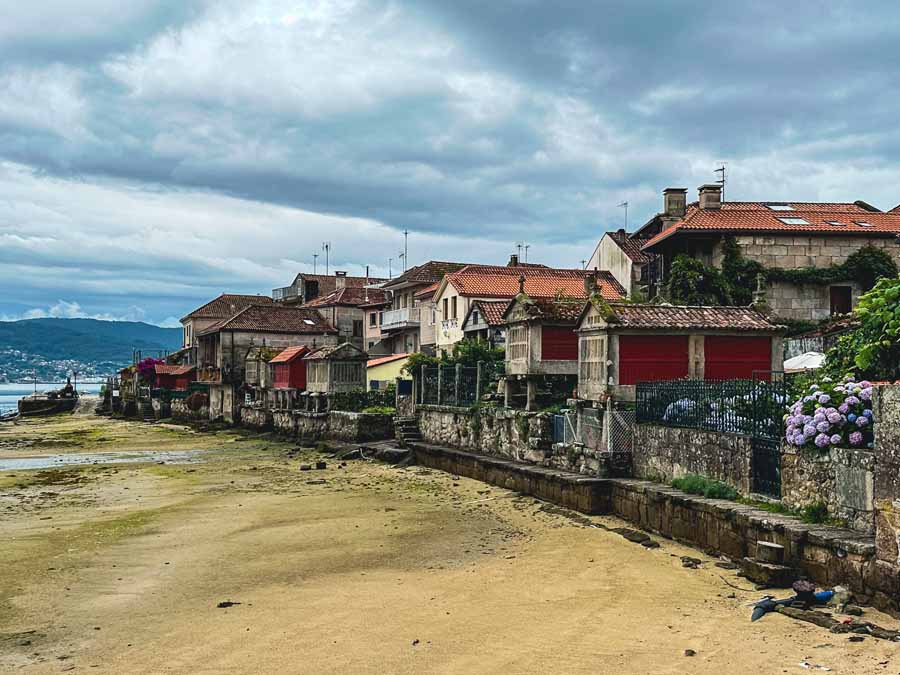
In short, these are some of the best things to do in Galicia Spain. From charming seaside villages to historical cities and natural wonders to waterfalls there are endless Galicia attractions worth visiting.
Galicia is home to stunning beaches like Cathedral Beach and the white sand beaches of the Cíes Islands. My favorite beaches in Galicia are the deserted stretches of Costa da Morte.
One of the best ways to experience Galicia is by walking one of the numerous Camino de Santiago routes. With a car, it’s easy to appreciate the abandoned Celtic Castros or visit hilltop cities.
With such a rich history and culture and pristine beauty, there are truly endless things to do in Galicia!
Pack This Post for Later! Pin It!
Disclaimer: There’s a chance this post contains affiliate links, and I receive a small (but grateful) portion of the sale. There’s no extra cost to you, and I only promote things that I use and love.
Hey, my name is Megs! I'm an adventure-seeking, wanna-be storyteller, with a wandering soul who is smitten with the diversity of this beautiful world. You can find me hiking in the mountains, eating delicious food, and seeking out the most authentic travel experiences possible. Experiences and memories are my most prized possessions. I love to slow travel and have been nomadic for over 12 years.
Similar Posts
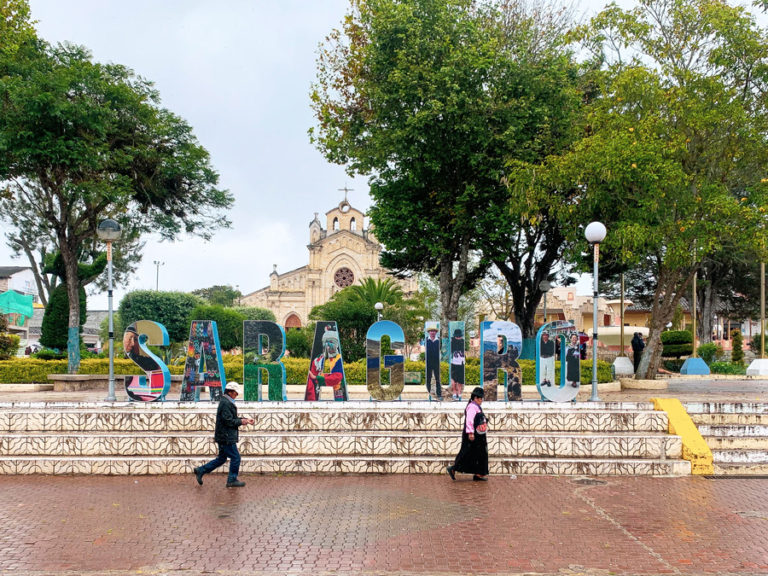
Why You Should Visit Beautiful Saraguro Ecuador

How to Spend One Day in Karlovy Vary on a Day Trip from Prague

What to See in Getxo | 10+ Noteworthy Attractions & How to Visit
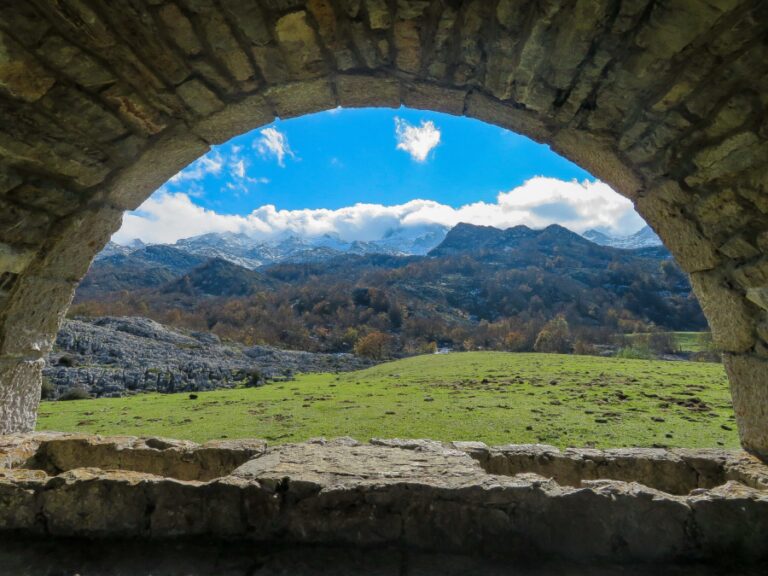
Picos de Europa National Park Ultimate Guide in 2024 & Road Trip Itinerary
Ruta dos Muíños do Folón e do Picón A Hidden Gem Hike in Galicia
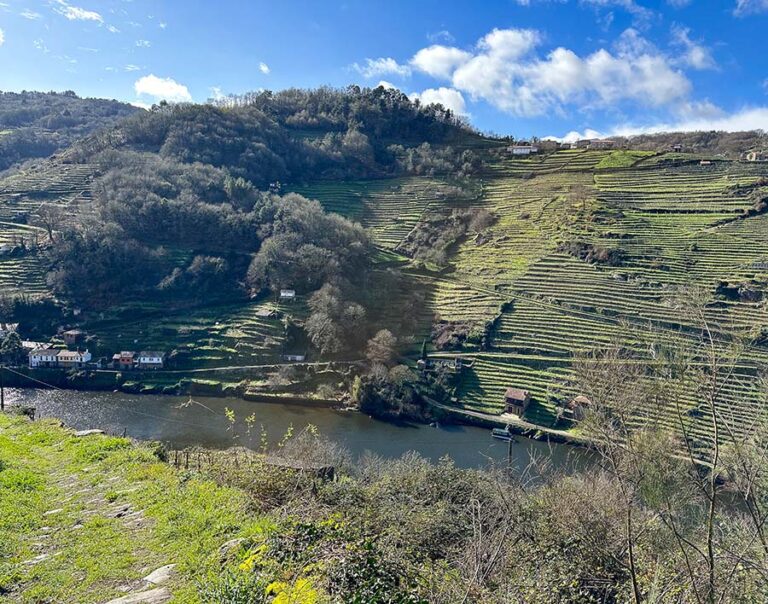
My Camino de Invierno Stages with Distances, Tips, and Why it’s Such a Special Camino Route
Leave a reply cancel reply.
Your email address will not be published. Required fields are marked *
Save my name, email, and website in this browser for the next time I comment.
Galician Bloggers Reveal The Top 12 Galicia Must See Places
Originally published on Sep 15, 2016, updated on Jul 11, 2023.
Nobody knows a place better than the people born and bred right there. That’s why we have reached out to a group of top Galician travel bloggers, who possess an unparalleled knowledge of their homeland, to share their insights on the best spots and must-see attractions in Galicia.
Galicia, the enchanting region in northwestern Spain, is known for its breathtaking landscapes, vibrant culture, and rich history. From the rugged coastline of the Ocean to the lush green hills and charming medieval towns, Galicia offers a diverse range of experiences for every traveler.
Assembling this list was no small feat. With countless hidden gems and iconic landmarks to choose from, our team of experts faced the daunting task of narrowing down the choices. Combining their passion for travel and their intimate understanding of Galicia, these travel bloggers have curated a selection of the most captivating places that will make your visit truly unforgettable.
So, whether you’re an adventure seeker looking to tackle the challenging hiking trails, a food enthusiast eager to indulge in Galicia’s world-famous seafood or a history buff fascinated by ancient Celtic ruins, this comprehensive guide will serve as your compass, steering you towards the best Galician experiences.
Prepare to immerse yourself in the magic of Galicia as we embark on a journey through its hidden treasures and well-known wonders. Let these local experts be your trusted companions as you uncover the beauty, flavor, and history that await you in this extraordinary corner of the world.
The Most Stunning Spots In Galicia
1. cathedral’s beach.

And here I am showing the world my love for Ribadeo and this jewel, Cathedral’s Beach, a few years back.
Cathedral’s Beach (Playa de las Catedrales) holds a special place in the hearts of both locals and visitors alike. Situated in A Mariña Lucense and a mere 10km away from Ribadeo, my hometown, this renowned spot is often at the top of many travelers’ must-visit lists. However, its inclusion here is not solely due to its proximity. The truth is, Cathedral’s Beach has earned its rightful spot because of the sheer magic it exudes .

Having gained popularity and experiencing a tourism boom in recent times, authorities have had to implement visitor restrictions, allowing fewer than five thousand people to explore its wonders each day. However, I have a recommendation for you – why not venture here during the Winter months?
Embracing the beach’s ethereal beauty during this quieter season allows you to truly immerse yourself in its splendor. You might even have the opportunity to claim this esteemed Galician treasure as your very own for a little while, capturing breathtaking shots if photography is as much of a passion for you as it is for me.

Just be sure to plan your visit during low tide, and you’ll be rewarded with an unforgettable experience. The beach awaits, ready to unveil its captivating rock formations and hidden wonders. Don’t miss the chance to embark on a personal journey through one of Galicia’s most extraordinary destinations.
Editor’s tip: For an immersive experience while exploring Cathedral’s Beach and the many other surrounding wonders, consider staying in a cozy countryside Galician stone home . Nestled amidst picturesque landscapes, these charming accommodations offer an authentic taste of rural Galicia.

Unwind in the warmth of a traditional cottage, waking up to breathtaking views of rolling hills. Immerse yourself in the magic of the region while having easy access to Cathedral’s Beach.
Book your stay now on Airbnb and embark on an unforgettable journey through Galicia. Or check rates and availability on Booking.com !
2. Arousa Bay
by sita-nena.com

We highly recommend visiting the beautiful and vibrant Ría de Arousa in the south of Pontevedra , Galicia. The summer season is especially delightful for experiencing Galicia’s largest estuary. The “rías” act as protected ocean areas, shielding mussel farms from harsh maritime weather conditions.

To truly immerse yourself in the essence of the Arousa estuary, we suggest embarking on a full-day tour that combines a boat trip and an Albariño wine tour.
This unique excursion encapsulates two of the Ría’s top attractions while highlighting the significance of the seafood industry, with a special emphasis on Galician mussels.
These mussels are cultured using floating raft systems, creating a picturesque underwater view of mussel lines with algae and small fish swirling around. It’s a breathtaking sight that truly exemplifies the richness of Galician seafood.

As you explore, keep an eye out for dolphins, as they too have a fondness for Galician mussels. On our tour, we were fortunate enough to witness a group of dolphins swimming alongside our ship, adding to the magic of the experience.
After a fascinating journey, it’s time to savor the freshness of Galician-style mussels, perfectly steamed and garnished with lemon wedges. The combination of these delectable mussels and a refreshing glass of Albariño white wine is a match made in heaven.
So, why not treat yourself to the abundance of Arousa Bay, savoring the delightful flavors of the sea and raising a toast to its captivating beauty and unique way of life? Bon appétit and cheers to the enchanting Ría de Arousa !
3. Cape Finisterre
by demiku.es

My favorite place in Galicia is undoubtedly Finisterre Cape, the “End of the Earth” (Finis Terrae) of the Romans. This corner on the Death Coast is a rather magical one, so much so that now many pilgrims choose not to end the Way in Santiago de Compostela but in Finisterre .

Being able to enjoy the sunset there is just a treat. Not surprisingly, the sunset at this cape is considered by many as one of the best in the world, both for its beauty and for being so legendary.
In this very place, one can envision the emotions experienced by Decimus Junius Brutus. After his triumph and conquest of Gallaecia, he eagerly ventured to this corner of Galicia, marveling at how the sun was swallowed by the sea.

The Finisterre Cape is a place that exudes enchantment and invites exploration. It is a sanctuary of natural beauty that leaves an indelible mark on the soul of those fortunate enough to experience it. It is a testament to the remarkable wonders that our world has to offer, and a reminder that the Earth’s true treasures often lie at the very edges of our known existence.
4. Siradella’s Hill Lookout
by Random Trip

I’m a huge fan of both the sea and breathtaking views, so this is one of my favorite spots in the Rías Baixas. You park your car and start walking up to the top (only takes you ten minutes), and this natural beauty overwhelms you. You’re even luckier if the sky is clear since you will have amazing views of the “A Lanzada” beach, the “Ensenada do Vao”, the “Illa de Ons” (Ons island), and “Illas Cíes” (Cíes islands).
As you arrive and park your car, a mere ten-minute walk takes you to the top of the hill, where the captivating scenery unfolds before your eyes. Prepare to be overwhelmed by the sheer magnificence of the landscape.
And if you’re fortunate enough to visit on a clear day, you’ll be treated to panoramic views that stretch across “A Lanzada” beach, the picturesque “Ensenada do Vao,” the enchanting “Illa de Ons” (Ons Island), and the renowned “Illas Cíes” (Cíes Islands).

To enhance the experience even further, I recommend bringing along some Estrella Galicia beers. Sipping on a cold brew – whether it has alcohol or is alcohol-free – while immersing yourself in the beauty of Siradella’s Hill creates a truly unforgettable and blissful moment.
So, embark on this journey, let the sea breeze guide you, and allow yourself to be captivated by the wonders that Siradella’s Hill Lookout has to offer.
Cheers to creating cherished memories in this coastal paradise!
5. Ribeira Sacra & Sil Canyons
by Un Plan Infinito

I adore Galicia and have many favorite places here. Today, I would like to delve into one hidden gem within Galicia.
Welcome to the Ribeira Sacra. Situated in inland Galicia, this area boasts breathtaking natural wonders, including the awe-inspiring Sil River Canyon, which is considered one of the world’s most remarkable landscapes.

Moreover, Ribeira Sacra showcases a valuable artistic heritage, with a cluster of medieval monasteries predominantly in the Romanesque style, serving as reminders of the region’s prominence during the Middle Ages. Notably, the beauty of San Esteban de Ribas de Sil and the monastery of Santa Cristina truly stand out, offering an enchanting journey through history.
This sense of tranquility and harmony persists in the region’s villages and medieval monasteries, some of which have been abandoned but remain worth visiting for their ancient walls that have witnessed the passage of time, shrouded in dampness, moss, and vegetation, exuding an air of mystique.

The Sil River serves as a natural border between Ourense and Lugo, presenting a spectacle of rugged landscapes, mesmerizing vineyards, majestic mountains, and the famous Los Balcones de Madrid viewpoint.
Lastly, don’t miss the opportunity to sail on the catamarans, which offer an unparalleled vantage point to appreciate the unique vistas of the canyons!

In choosing a base for exploring this remarkable region, Parada de Sil emerges as an ideal option. Located in close proximity to the Ribeira Sacra, Parada de Sil is a fantastic starting point to embark on your exploration of this captivating area.
6. Viewpoint at Redondela
by millandasairas.com

Are you familiar with the captivating beauty of the Rias Baixas? I invite you to come and immerse yourself in the stunning landscapes and indulge in the delectable gastronomical offerings this region has to offer.
Among the many intriguing places in this area, the Ria de Vigo stands out, boasting an estuary where the Cies Islands leave an indelible mark. These two paradises face each other, creating an enchanting sight. For the optimal perspective to soak in this panoramic view, the Redondela lookout is the place to be.
After extensive exploration, I am confident that this spot is the perfect vantage point to fully appreciate the multitude of treasures that this area has to offer – all captured in a single breathtaking scene.
What are your thoughts? Have I captured your attention?
7. Fragas do Eume
by Escapalandia

For many years this spot was one of the best-kept secrets of the Galician geography, only known by the residents of the area or the province. They would walk through the woods, to see its ancient monastery on the slopes of Eume Canyon or celebrate a sort of traditional yearly pilgrimage, a romeria . A great place to explore all year long, today it receives thousands of visitors during the Summer months.
His most popular Caaveiro access is well-signposted from Pontedeume. But this Atlantic forest of great value for its flora and fauna can also be visited from As Pontes de Garcia Rodriguez or Monfero. There one can enjoy the lush nature , its beautiful river, the remains of an industrial building in the old center of A Ventureira, and the art and history of its ancient inhabitants: the religious hermits who first settled in this land.
Do not leave without embracing the loneliness and some outstanding hiking, dropping by the visitor center, and having a drink in the canteen of the former monastery of Caaveiro.
In addition to exploring the remarkable attractions of the Caaveiro area, be sure to take the time to visit the charming neighboring villages that dot the Galician landscape. These villages offer a unique glimpse into the rich culture and traditions of the region. Here are three examples:
- Pontedeume (15 min away): This picturesque village is known for its historic center, with narrow medieval streets, stunning architecture, and a beautiful beach. Take a leisurely stroll along its promenade, admire the colorful houses, and perhaps indulge in some delicious seafood at one of the local restaurants.
- Betanzos (30 min away): Nestled along the river Mandeo, Betanzos is a historic town with a remarkably well-preserved medieval center. Stroll through its charming streets and admire its beautiful squares lined with ancient buildings. The town is known for its gastronomy, particularly its delicious potato omelet.
- Cedeira (1 hour away): Situated on the rugged Atlantic coast, Cedeira is a picturesque fishing village renowned for its stunning natural beauty. Surrounded by cliffs and embraced by pristine beaches, it offers breathtaking coastal walks and panoramic views. Discover the traditional charm of its colorful houses, explore its charming harbor, and savor the local seafood delicacies in the cozy waterfront restaurants.
8. San Simon Island
by Maruxaina

One of my favorite destinations in Galicia is the Rias Baixas region, particularly the islands of St. Simon and St. Anton. This small archipelago, brimming with history, often goes unnoticed due to its proximity to the popular Cies islands (pictured below).

It is the perfect place to unwind and delve into Galicia’s rich history. These islands were initially inhabited by Templar monks, and during the last century, San Simon served as a prison island during the Franco regime.
You can explore a permanent photography exhibition that showcases the captivating history of the islands, while also enjoying stunning views of the Vigo estuary . Moreover, if the tide is low, you may be treated to a unique tribute to Jules Verne: two divers searching for the treasure of Rande!
Visiting the islands of St. Simon and St. Anton offers a serene and educational experience, allowing you to appreciate the lesser-known, yet remarkable, treasures of Galicia.
9. Patos Beach
by Trucos Viajeros

One of my cherished spots in the Rias Baixas region is the alluring Patos beach. With its sunny summer vibes, pleasant winter strolls, and consistent surf conditions throughout the year, it captures the essence of coastal bliss. This beach caters to both surfers and sunbathers, inviting them to revel in its crystal-clear waters and soft white sand.
What makes Patos Beach even more special is its ideal location just across the Cíes Islands, providing the perfect backdrop for breathtaking sunset photos.
Moreover, it is conveniently located just a few kilometers away from the popular fishing village of Panxon, the beautiful Praia America beach, and the vibrant city of Vigo.

As an added bonus, Patos Beach also holds significance in literature, as it serves as one of the settings in the novel “Death on a Galician Shore” (A Praia dos Afogados) by Domingo Villar.
Whether you seek relaxation, excitement through surfing, or a picturesque sunset, Patos Beach offers it all, making it an absolute gem in the Rias Baixas region.
10. Ourense
Sunday morning stroll around #Ourense’s highlights before heading to Verin for more #Entroido2015! Una foto publicada por A World to Travel (@aworldtotravel) el 15 de Feb de 2015 a la(s) 2:27 PST
Most travelers tend to overlook the charming city of Ourense during their visit to Galicia, but I believe that is a major mistake. Situated just an hour away from the Atlantic coast, this small city offers a delightful experience for every type of traveler and makes for an ideal day trip or weekend getaway.
If relaxation is what you seek, Ourense has you covered. You can unwind in the natural hot springs situated along the banks of the Minho River, rejuvenating your body and mind. Additionally, you can visit the historic As Burgas area, where you’ll find hot fountains that have been flowing since Roman times, providing a unique opportunity to immerse yourself in ancient history.

For those who enjoy culinary delights, Ourense offers an experience known as “os viños” (wine in Galician). Take a leisurely stroll through the old town, stopping at the many bars that dot the streets. Here, you can sample traditional Galician cuisine while enjoying a complimentary tapa with your glass of wine.
Whether you crave relaxation, cultural immersion, or gastronomic adventures, Ourense has it all.
11. Santa Comba beach, Ferrol
by Viajando Imagenes & Sensaciones
Una foto publicada por Viajando. Imágenesysensaciones (@viajando_imagenesysensaciones) el 11 de Jun de 2016 a la(s) 1:12 PDT
Santa Comba, located in Galicia, is renowned for its breathtaking beauty. The crystal-clear water is only part of its allure; the surrounding landscape also captivates visitors. A notable feature on the right side of the beach is a small island adorned with a quaint church.
It is fascinating to note that this island used to be connected to the mainland, but relentless weather conditions, including strong winds and waves, sculpted it into three distinct isles.
At Santa Comba, there are opportunities for snorkeling and leisurely strolls around Prior Cape. This secluded beach remains tranquil and unspoiled, with a scarcity of visitors. Whether you desire a refreshing swim, a peaceful walk, or simply a moment to absorb the picturesque scenery, Santa Comba provides the perfect setting.
Just a short distance from the awe-inspiring Santa Comba beach, the vibrant city of Ferrol awaits. Known as a haven for surfers, Ferrol offers an incredible range of surfing opportunities in its surrounding area.

After catching some waves, surf enthusiasts can venture to Ferrol to explore its enticing attractions.
Discover the city’s fascinating naval history at the Naval Museum, soak in the coastal charm along the waterfront promenade, indulge in delectable local cuisine, and immerse yourself in Ferrol’s lively cultural scene.

12. Ourense Hotsprings
by endondesea.com
Ourense proudly holds the title of the second-largest hot spring city in Europe.
Nestled along the picturesque Miño River, you can indulge in a luxurious two-hour spa experience for a mere 5 euros in Outariz or Prexigueiro. Alternatively, if you prefer to relish the thermal environment without spending a penny, a variety of waterside options await.
The open-air hot springs allow you to select your desired temperature, ensuring maximum comfort.
After a blissful day spent in the thermal oasis, take the opportunity to explore the historic charm of Ourense’s old city.

This splendid destination is widely regarded as one of the finest in Galicia, Spain. Treat yourself to an authentic Spanish culinary experience by savoring delectable tapas and complementing them with a glass of exceptional wine.
Throughout the year, these are twelve remarkable destinations waiting to be explored, each offering its own unique charm and allure. We invite you to discover these captivating spots at any time, as their beauty and significance are not limited to specific seasons.

Want us to provide more insights into exploring this fantastic region? We’ll continue sharing tips and recommendations on the incredible sights and activities available year-round in Galicia, so stay tuned!

Explore Galicia
Explore amazing galicia in north west spain.

Galicia is a beautiful region located in the northwest corner of Spain, bordered by the Atlantic Ocean to the west and Portugal to the south.
It is a land of lush green landscapes, rugged coastline, and a rich cultural heritage. Galicia has a long and varied history, shaped by its Celtic, Roman, and medieval past.
This region is known for its unique traditions, stunning landscapes, numerous historic sites, superb gastronomy, and amazing blue flag beaches.
The Santiago de Compostela Cathedral , the last stop on the Camino de Santiago, is one of Galicia's main tourist destinations. With its exquisite stone carvings and tall towers, it is a stunning specimen of Romanesque architecture. The Tower of Hercules in A Coruna, a historic lighthouse that has been in continuous operation for more than 2,000 years, is another must-see attraction.
Some of the best destinations in Galicia include the charming town of Ribadeo, located on the coast near the border with Asturias. It is known for its beautiful beaches and picturesque historic center.
Another great destination is the Rías Baixas, a series of estuaries dotted with fishing villages and stunning beaches.
Galicia is also famous for its gastronomy, which features fresh seafood, delicious locally-produced wines, and traditional dishes like empanadas and pulpo a la gallega (Galician-style octopus). The region boasts many Michelin-starred restaurants, as well as casual seafood taverns and local markets selling fresh produce and artisanal products.
The region of Galicia is home to more Blue Flag beaches than any other in Spain. Some of the best beaches include Playa de Areas in Sanxenxo, Playa de Laxe in A Coruña, and Playa de Rodas in the Cíes Islands. These beaches are known for their crystal-clear waters, golden sands, and stunning scenery.
The Top Attractions in Galicia
The tower of hercules.

In the traditional yet modern city of La Coruna, there is the famous Tower of Hercules, an ancient lighthouse built by the Romans thousands of years ago.
The lighthouse is not only a beacon of light but a symbol of strength and power as it has stood fast over time, not even surrendering to damaging weather or earthquakes. This is an impressive feat of Roman engineering and well worth visiting.
Santiago de Compostela Cathedral

In the city of Santiago de Compostela, the cathedral stands proud and marks the final destination of the walk of pilgrims trekking the Camino de Santiago , starting in the Pyrenees, 500 miles away.
Travellers can decide of course to join the route at certain points in between, depending on how far they want to walk and how much they want to see.
The Santiago de Compostela Cathedral itself stands in an urban plaza that bustles with life and is considered one of Spain’s national treasures and well worth a visit.
The Standing Stones of Galicia

At first glance, you may be forgiven for thinking that these unusual stones were created by the primitive inhabitants of Galicia in times gone by.
In reality, they were the brainchild of local artist Manolo Paz in 1994 who paid tribute to the Celtic people who once inhabited much of Europe, including Northern Spain.
The “Menhir Spike” stones are located on the same headland as the Hercules Tower.
The Vineyards of Galicia

Wine is a fundamental part of life in this region and the wine routes are part of the region's historical and cultural identity.
The mild temperatures and rainfall in Galicia are ideal for the production of the world-renowned Albarino, white and Ribeira, Red wines.
There are many wine routes in the region where you can learn all about the variety of wines on offer .
A number of companies offer wine and gastronomy tours with tasting sessions which is an ideal way to learn and savour wines from the region.
Check out the 10 best wine tours on Tripadvisor.
Enjoy the Amazing Beaches

Galicia is blessed with a stunning coastline and beautiful beaches. Several of its beaches have been awarded the prestigious Blue Flag designation, which recognizes clean and well-maintained beaches that meet strict environmental standards.
Here are some of the best Blue Flag beaches in Galicia:
- Playa de Riazor: This urban beach in the city of A Coruna, is popular with both locals and tourists alike.
- Playa de Silgar: This beach is renowned for its beautiful sand and clear waters and is situated in the pretty coastal town of Sanxenxo
- Playa de O Vilar: Though this beach on the Cies Islands it can only be reached by boat due to its secluded location and pristine beauty, it is a must-see.
- Playa de Rodas: The Ciés Islands are home to a number of amazing gorgeous beaches. Playa de Rodas, was voted by the Guardian as the best beach in the world in 2007.
- Playa Catedrais, is a famed beach in Ribadeo that is well-known for its stunning rock formations.
- Playa Lanzada: Located in O´Grove this beach is a firm favourite with windsurfers and other water sports enthusiasts.
- Praia de Baltar is a family-friendly beach with calm waters that is accessible from Portonovo.
There are more blue flag beaches located in the region of Galicia than any other in Spain.
The Cies Islands

Just off the coast of Galicia, close to Pontevedra, is the magnificent archipelago known as the Cies Islands .
The islands, which are a protected natural park, are renowned for their immaculate beaches and crystalline waters.
A network of hiking routes connects the three major islands, Monteagudo, Do Faro, and San Martio, allowing tourists to explore the region's unique flora and fauna.
The islands are also home to a large variety of bird species, such as the European storm petrel, and the yellow-legged gull.
The Islands boast fine white sands and turquoise waters, the major beach on the islands, Rodas Beach, is often voted as one of the best beaches in the world.
Access to the Cies Islands is limited, with a daily quota of visitors allowed to enter the park, and camping and overnight stays are prohibited.
However, day trips are available which will allow you to experience the beauty of the islands for yourself.
Medieval Villages

Galicia is well known for its stunning natural surroundings, delicious seafood, and distinctive culture. It is also well known for being the location of numerous quaint medieval coastal villages, some of which have survived the passage of time largely unaltered.
These towns and villages provide a window into Galicia's rich past and cultural legacy. These charming villages offer a special vacation experience with their traditional architecture, winding streets, and stone homes.
Here is a list of some of Galicia's most picturesque and interesting coastal towns, each with its own unique personality and background.
Here are five amazing medieval villages:
1. Cambados

Located in the province of Pontevedra, Cambados is a medieval town that is famous for its spectacular white wine; Albariño. The wine is often paired with seafood, a great delicacy available in abundance in this region of Spain.
The town has many attractions for tourists including monuments, ruins, a tidal mill, a church, and a tower. As well as its many beaches it also has a lovely river, Rio Umia, bordering the edge of the town.
2. Cap Finisterre

Cape Finisterre, also known as "The End of the World," is a rocky headland located on the western coast of Galicia.
It was once considered the westernmost point of the known world and is known for its stunning natural beauty and breathtaking sunsets.
The cape is a popular pilgrimage site for both religious and non-religious visitors, who come to witness the symbolic burning of clothing and other offerings on the cliffs at sunset.
The lighthouse at Cape Finisterre is one of the oldest in Spain and offers panoramic views of the rugged coastline and the Atlantic Ocean.
3. Pontedeume
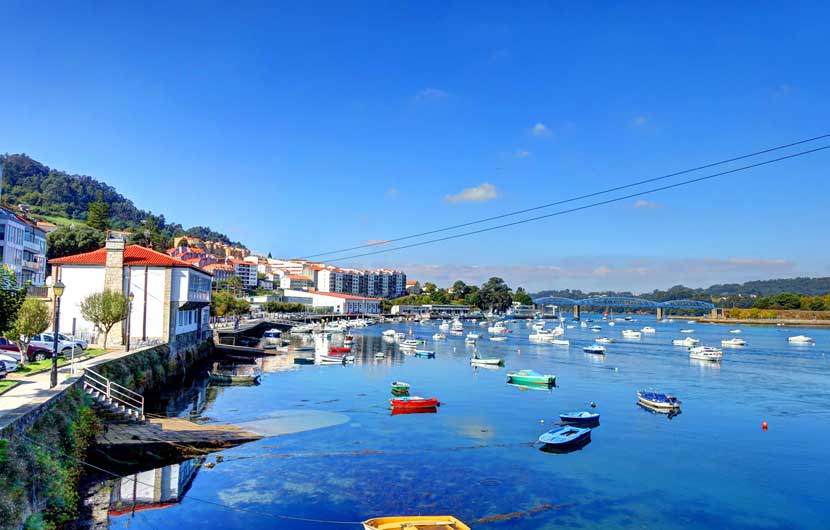
Pontedeume is a charming town situated on the banks of the Eume River, it is known for its beautiful historic quarter, which has been declared a Site of Cultural Interest.
The town is also famous for its beaches, including the picturesque beach of Cabanas and the natural area of the Fragas do Eume.
Pontedeume is also home to several notable buildings, such as the Gothic-style Church of Santiago de Pontedeume, and the medieval castle of the Andrade family, which dominates the town's skyline.
The town is renowned for its traditional festivals and gastronomy, which are deeply rooted in Galician culture.
Overall, Pontedeume is a great destination if you are looking to experience the authentic charm of Galicia.
4. Rias Baixas

The Rias Baixas are a series of estuary inlets located in the southwest of the province of Pontevedra. The region is made up of several rivers, or estuaries, including the Ria de Vigo, Ria de Pontevedra, Ria de Arousa, and Ria de Muros e Noia.
The region is known for its beautiful coastline, sandy beaches, and stunning landscapes.
The Rias Baixas is also famous for its delicious seafood and white wines, particularly the Albariño wine
Along the banks of the Rias Baixas you can explore the charming coastal towns and villages and picturesque fishing communities.
the Rias Baixas is a well-liked travel destination for both domestic and foreign visitors and is one of the most picturesque regions of Spain

Baiona is known for its beautiful beaches, medieval buildings, and picturesque harbour.
It was an important location in the history of Spain because it was where the news of Christopher Columbus' discovery of America was first reported.
The village is now a well-liked tourist destination with lots of eateries, cafes, and bars providing regional seafood and Galician cuisine.
A number of cultural and athletic events, such as the Baiona Medieval Festival, which honours the town's past, are also held in the town throughout the year.
Galicia Festivals

The Galicia region of Spain is known for its rich cultural and religious heritage, which is reflected in the numerous festivals and fiestas held throughout the year. These celebrations often have a historical or religious significance, and attract visitors from all over the world.
Here are some of the main festivals and fiestas held in Galicia:
- Carnivals - celebrated each year in February or March, it is a lively and colourful festival with parades, costumes, music and dance.
- Holy Week - held in March or April, it is one of the most important religious festivals commemorating the death and resurrection of Jesus Christ, with processions and ceremonies.
- Festa do Apóstolo - celebrated on July 25th in Santiago de Compostela, it honours Saint James, the patron saint of Galicia, with a variety of cultural events and religious ceremonies.
- Romería Vikinga - held in Catoira in August, it is a re-enactment of the Viking invasions of Galicia in the 9th and 10th centuries, with mock battles and parades.
- Festa do Marisco - held in O Grove in October, it is a seafood festival featuring a wide variety of local delicacies.
- Magosto - celebrated in November, it is a traditional festival honouring the autumn harvest, with chestnuts, wine and music.
- Entroido Ribeirao - celebrated in Xinzo de Limia, it is one of the most traditional Carnivals in Galicia, with a strong emphasis on the preservation of ancient cultural traditions.
These festivals and fiestas provide a unique insight into the history, culture and traditions of Galicia, and are a wonderful way to experience the vibrant and lively atmosphere of the region.
Holy Week in March/April

Holy Week is celebrated heavily in Spain, not least in Galicia. During this week, almost every Galician town and village holds street processions that display parades of religious icons. Each one of these lifelike sculptures are telling the story of the Virgin Mary and Jesus to the rhythm of drum bands.
Santiago de Compostela in July

The grandest festival in all of Galicia is that of Apóstolo Santiago, which is celebrated as Galicia´s national day. This is held on July 25th every year and the people spill into the cities’ streets for parades and fireworks. It’s a great party atmosphere where the people get really involved and anyone is welcome to celebrate. The party is actually a week long and is a must-see for keen visitors to Galicia.
The Gastronomy of Galicia

The gastronomy of Galicia is world-renowned for its fresh seafood, hearty stews, and delectable wines. Galicia is located in the northwest of Spain, surrounded by the Atlantic Ocean, and is known for its fertile seas and lands, which produce some of the best seafood and meats in Spain.
The history of Galician cuisine dates back to the Roman Empire, when the area was a major producer of wine, olive oil, and other agricultural products.
In modern times, Galicia has become known for its fresh seafood, with dishes such as octopus, clams, and shrimp being staples of the local diet.
The region is also famous for its hearty stews, which feature a variety of meats and vegetables and are often made with beans or chickpeas.
One of the most famous dishes in Galicia is pulpo a la gallega, which is a boiled octopus served with potatoes, paprika, and olive oil. Another popular seafood dish is empanada de atun, a savory pastry filled with tuna, onions, and peppers. Meat lovers will enjoy the traditional Galician beef, known as ternera gallega, which is known for its tenderness and flavor.
Wine is also an essential part of the Galician gastronomy, with the region producing some of the best white wines in Spain, such as Albariño, Godello, and Treixadura.
Galicia is also home to several unique liqueurs, such as Orujo and Queimada, a traditional drink made with Galician liquor, sugar, and coffee beans.
Overall, Galician cuisine is a perfect blend of fresh ingredients, bold flavours, and traditional cooking techniques.
The region's rich history, diverse landscape, and proximity to the Atlantic Ocean have all contributed to its unique and delicious culinary culture.
Whether you are a seafood lover or a meat enthusiast, Galicia has something for everyone to enjoy.

The top 10 dishes from Galicia

- Pulpo a la Gallega: Also known as Galician-style octopus, this dish features boiled octopus that is sliced and served on a bed of potatoes, drizzled with olive oil and sprinkled with paprika.
- Empanadas: These are savoury pies filled with a variety of ingredients, such as tuna, chicken, or cod, and are usually served as a snack or appetizer.
- Lacón con Grelos: This traditional dish consists of boiled pork shoulder served with a side of turnip greens or rapini.
- Caldo Gallego: A hearty soup made with white beans, potatoes, and greens, such as kale or collard greens, and often served with chorizo or ham.
- Percebes: These are unique-looking goose barnacles found along the rocky coastline of Galicia. They are typically boiled and served as a delicacy with lemon and bread.
- Tarta de Santiago: A traditional almond cake that is popular throughout Galicia, typically dusted with powdered sugar and decorated with the cross of Saint James.
- Arroz con Marisco: A seafood rice dish made with saffron, shrimp, clams, and other seafood, similar to paella but with a distinct Galician twist.
- Vieiras a la Gallega: Grilled scallops served on the half-shell with breadcrumbs, garlic, and paprika, a classic Galician appetizer.
- Zorza: A spicy sausage made with pork, garlic, and paprika, often served as a filling for empanadas or as a standalone dish.
- Queso de Tetilla: A mild, creamy cheese made from cow's milk, often served as an appetizer or snack with bread or crackers.
The top 10 wines from Galicia

- Albariño: A white wine that is crisp, dry, and acidic with citrus and stone fruit flavours. It is the most well-known and widely planted grape variety in Galicia.
- Godello: A white wine that is medium to full-bodied with a floral aroma and flavours of citrus, apple, and pear. It is known for its balance and complexity.
- Mencía: A red wine that is medium-bodied with red fruit flavours and a spicy finish. It is grown mainly in the Bierzo region of Galicia.
- Treixadura: A white wine that is medium-bodied with flavours of peach, apricot, and citrus. It is often blended with other grapes to add complexity.
- Loureira: A white wine that is light-bodied with floral and fruity flavours. It is commonly used in blends to add acidity and freshness.
- Brancellao: A red wine that is medium-bodied with red fruit flavours and a spicy finish. It is grown mainly in the Ribeira Sacra region of Galicia.
- Sousón: A red wine that is full-bodied with flavours of blackberry and plum. It is grown mainly in the Ribeiro region of Galicia.
- Torrontés: A white wine that is light-bodied with floral and fruity flavours. It is commonly used in blends to add aroma and acidity.
- Caíño: A red wine that is medium-bodied with flavours of cherry and spice. It is grown mainly in the Rias Baixas region of Galicia.
- Merenzao: A red wine that is medium-bodied with red fruit flavours and a spicy finish. It is grown mainly in the Ribeira Sacra region of Galicia.
Getting to and from Galicia
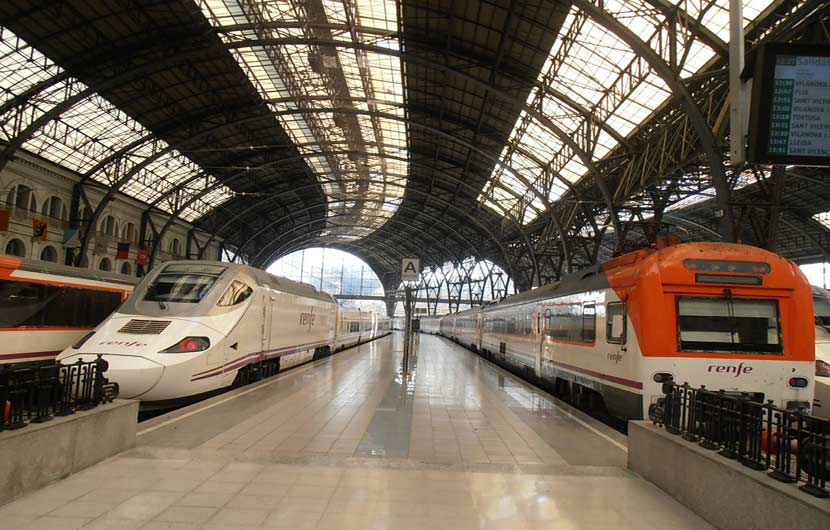
Today's excellent air, rail, and road transportation infrastructure makes it simple to travel to Galicia from any location in Spain or from the EEC.
Use the AVE High-Speed Trains ; there are frequent Ave services from Madrid and Barcelona if you want to travel in style.
Three international airports are situated at Lavacolla (Santiago), Peinador (Vigo), and Alvedro (A Coruna), and they are all connected by good quality highways and motorways and a reliable rail system.
Galicia has excellent motorway infrastructure, making it simple to travel there and explore the region. The main entrance routes are the N-VI from Madrid to A Coruna, the N-525 from Zamora to Vigo via Ourense, and the N-634 from Asturias, which enters Ribadeo. The N-13 enters Galicia through Tui in Portugal, connecting A Coruna and Vigo with the N-13, which originates in Lisbon and Oporto.
- About Author
- Latest Posts

Hey there! I'm Matt, your friendly neighbourhood explorer extraordinaire! For the past 15 years, I've been gallivanting around Spain, soaking up all its wonders and uncovering hidden gems like a modern-day Indiana Jones (minus the hat and whip, unfortunately). So, buckle up, amigos! It's time to dive straight into the heart and soul of Spain. Welcome to my world of Spanish wonders!
Latest posts from Matt
- 4 Days in Valencia – The Ultimate Bucket List Itinerary - March 17, 2024
- Luxury Spain Holidays – The Ultimate Bucket List Travel Guide - March 9, 2024
- Easter in Spain – Semana Santa Holy Week Traditions - March 7, 2024
Recent Posts

Off the Beaten Path: The Top Barcelona Beaches that You’ve Never Heard Of

Making the Most of the Off Peak Shoulder Season in Spain
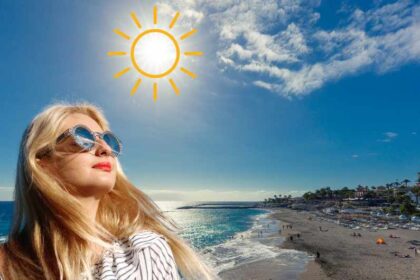
Spain Dominates With The Sunniest Cities in Europe

4 Days in Valencia – The Ultimate Bucket List Itinerary
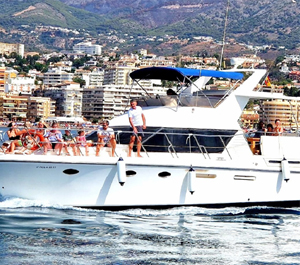
Luxury Spain Holidays – The Ultimate Bucket List Travel Guide
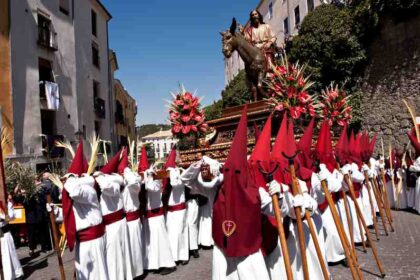
Easter in Spain – Semana Santa Holy Week Traditions

Barcelona Nightlife – Best Discos & Nightclubs Not To Be Missed
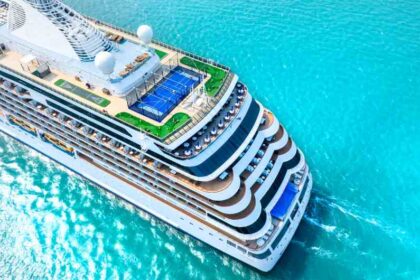
Making The Most Of Shore Sightseeing Excursions In Spain Whilst Cruising The Med
Leave a reply cancel reply.
Your email address will not be published. Required fields are marked *
This site uses Akismet to reduce spam. Learn how your comment data is processed .

Travel Smarter - Not Harder
Download free e-guides and travel tips.
Start your Journey today and get access to exclusive FREE content.
Disclosure: Please note that some of the links included in the above content may be affiliate links. We may earn a commission if you make a purchase at no extra cost to you. Rest assured, we only recommend products and services that we personally use or have used and are happy to recommend. Any commission we earn helps toward the site's running costs.
Username or Email Address
Remember Me
- WHY VISIT SPAIN?
- TRAVELLING TO SPAIN
- SPAIN ON A BUDGET
- TRAVEL REQUIREMENTS – ETIAS
- SPAIN ENTRY REQUIREMENTS
- SPANISH CUISINE
- SPANISH FOOD
- HOLIDAY IDEAS
- PUBLIC HOLIDAYS
- TOURISM BOARDS
- AIRPORT GUIDE
- DRIVING IN SPAIN
- WEATHER IN SPAIN
- FREE WEB CAMS
- BEST BEACHES SPAIN
- FESTIVALS & FIESTAS
- MUSEUMS IN SPAIN
- CAMPING IN SPAIN
- MARINAS IN SPAIN
- SKIING IN SPAIN
- WATER PARKS
- UNESCO WORLD HERITAGE SITES
- 80 BEST ATTRACTIONS
- 71 BEST PLACES TO VISIT
- REGIONS OF SPAIN
- COSTA DEL SOL
- CANARY ISLANDS
- SAN SEBASTIAN
- Complete List:
- SAGRADA FAMILIA BARCELONA
- BARCELONA FC STADIUM TOUR
- BARCELONA FLAMENCO SHOW
- SEVILLE FLAMENCO SHOW
- SEVILLE CATHEDRAL
- GAUDI`S CASA BATLLO
- THE ALHAMBRA GRANADA
- SANTIAGO CATHEDRAL
- CITY OF ARTS & SCIENCE VALENCIA
- MOSQUE-CATHEDRAL CORDOBA
- CAMINITO DEL REY
- PRADO MUSEUM MADRID
- REINA SOFIA ART MUSEUM
- SCUBA DIVING
- BEST TAPAS TOURS
- BEST WINE TASTING TOURS
- TOUR GUIDES
- HOTELS IN SPAIN
- LUXURY HOTELS
- LUXURY BEACH HOTELS
- HOLIDAY RENTALS
- PARADOR HOTELS
- CHEAP FLIGHTS
- TRAVEL INSURANCE
- FREE TRAVEL BROCHURES
- WIN FREE HOLIDAYS

Galicia Travel Guide
Book your individual trip , stress-free with local travel experts
Select Month
- roughguides.com
- Travel guide
- Itineraries
- Local Experts
- Travel Advice
- Accommodation
Plan your tailor-made trip with a local expert
Book securely with money-back guarantee
Travel stress-free with local assistance and 24/7 support
Maureen C, USA
The hotels were fabulous and we were greeted and treated with care. The itinerary proved outstanding. The drivers were wonderful. He was always on time, ma...
Passionately entangled with the Atlantic Ocean, at the northwest corner of the Iberian Peninsula, Galicia feels far removed from the rest of Spain. Everywhere is green, from the high forested hills to the rolling fields, a patchwork of tiny plots still farmed by hand. Indeed, with its craggy coast and mild, wet climate, Galicia is more like Ireland than Andalucía. Its people take pride in their Celtic heritage, and cherish the survival of their language, Galego. It’s hardly off the beaten track, however. Santiago de Compostela ranked during the Middle Ages as the third city of Christendom, and pilgrims have been making their way here along the Camino de Santiago for well over a thousand years.
Galego food
The rías altas, the costa da morte, ría de muros e noia, ría de arousa, ría de pontevedra, ría de vigo, inland galicia.
Santiago itself remains the chief attraction for visitors. Still focused around its unspoiled medieval core, a delightful labyrinth of ancient arcades and alleyways, it’s an unmissable gem. Galicia’s other major selling point is its endlessly indented shoreline, slashed by the powerful sea into the deep, narrow estuaries known here as rías, and framed by steep green hillsides. Sadly, however, a lack of planning controls has meant that much of the coast is depressingly overbuilt, albeit with dreary villas and apartments rather than high-rise hotels. With each town tending to merge into the next, those few resorts that remain recognizable as sturdy little medieval fishing villages, such as Cambados, Muros and Baiona, come as welcome highlights. Pretty, secluded sandy beaches do exist, but they take a bit of finding these days, and often require a drive away from the built-up areas.
Broadly speaking, of the distinct coastal stretches, the Rías Altas in the north are wilder and emptier, while the picturesque Rías Baixas, neighbouring Portugal, are warmer and more developed, and consequently attract many more visitors. In between the two lie the dunes and headlands of the more rugged Costa da Morte. Only a couple of the seafront towns have grown to become cities: the modern ports of A Coruña , with its elegant glass-encased balconies, and Vigo , perched alongside a magnificent bay. Further inland, the settlements are more spread out, and the river valleys of the Miño and the Sil remain beautifully unspoiled, while the attractive provincial capitals of Pontevedra , Ourense and Lugo seem little changed since the Middle Ages.
Again like the Irish, the Galegos are renowned for having emigrated all over the world. Between 1836 and 1960, around two million Galegos – roughly half the total population – left the region, thanks largely to the demographic pressure on agricultural land. Half of them ended up in Argentina, where Buenos Aires is often called the largest city in Galicia. An untranslatable Galego word, morriña, describes the exiles’ particular sense of homesick, nostalgic longing. That Celtic melancholy has its counterpart in the exuberant devotion to the land, its culture and its produce that you’ll encounter in Galicia itself, as evinced in its music, – they even play the bagpipes (or gaita galega) – literature and festivals. Above all, Galegos view their food and wine almost as sacraments; share in a feast of the fresh local seafood, washed down with a crisp white Albariño, and you may find the morriña gets a hold on you, too.
Book tickets and tours for Santiago de Compostela
Travel ideas for Spain, created by local experts

9 days / from 2491 USD
Andalucía Explored
Discover the best of Andalucía's breathtaking palaces, churches, museums, vineyards, and more, as you travel through spectacular scenery dotted with pueblos blancos and bordered by rugged mountains and coast en route to Granada, Seville, Ronda and Jerez de la Frontera.

4 days / from 649 USD
A culinary experience in Seville
Explore the cuisine and surroundings of Seville in Andalucia. From Iberian ham over sherry wines to the production and secrets of olive oil, this tour is an ideal weekend getaway. Decide yourself if you prefer a rental car or a chauffeur-driven car to explore the beauty of Andalucia.

10 days / from 3826 USD
Spanish Honeymoon
Discover Andalusia, starting with the cultural city of Seville, then on to Córdoba and Granada, home of the stunning Alhambra Palace. Next you'll visit Granada and the Albayzin Arab quarter, then enjoy a stunning hot-air balloon ride, before ending your trip with a luxury boat trip from Marbella!
1: Livestock fair at Betanzos.
6: Los Reyes Horseback procession of the Three Kings in Baiona.
1: San Rosendo Celanova’s big festival, at the monastery.
Pre-Lent: Carnavales throughout the region.
Semana Santa (Holy Week) Celebrations include a symbolic descendimiento (descent from the Cross) at Viveiro on Good Friday and a Resurrection procession at Fisterra. On Palm Sunday, there are Stations of the Cross at Monte San Tecla, near A Guarda.
Sunday after Easter: Fiesta de Angula Elver festival at Tui.
Second Monday after Easter: Fiesta San Telmo At Tui.
Late April–early May (dates vary) Festival at Ribadavia celebrating and promoting Ribeiro wines.
May 1: Romería at Pontevedra marks the start of a month-long festival.
Last week: Vino de la Ribeira Sacra Festival at Monforte de Lemos.
First weekend: Rapa das Bestas The capture and breaking in of wild mountain horses at Viveiro.
11: Fiesta de San Benito At Pontevedra, with river processions, and folk groups, and a smaller romería at Cambados.
Second weekend: Medieval de Betanzos Three-day fair at Betanzos, reliving the town’s time under Andrade rule.
Second weekend: International Festival of the Celtic World Galicia’s most important music festival is held in Ortigueira (wfestivaldeortigueira.com); pipe bands from all the Celtic lands perform, alongside musicians from around the world, and every event is free.
16: Virgen del Carmen Sea processions at Muros and Corcubión.
24–25: St James (Sant Yago) Two days of celebration in many places, with processions of bigheads and gigantones on the 24th and spectacular parades with fireworks and bands through the following evening.
25: Santiago Galicia’s major fiesta, at its height in Santiago de Compostela . The evening before, there’s a fireworks display. The festival – also designated “Galicia Day” – has become a nationalist event with traditional separatist marches and an extensive programme of political and cultural events for about a week on either side.
First Sunday Albariño wine festival at Cambados; bagpipe festival at Ribadeo; Virgen de la Roca observances outside Baiona; pimiento festival at Padrón; Navaja (razor shell) festival at Fisterra.
16: Fiesta de San Roque Festivals at all churches that bear his name: at Betanzos, there’s a Battle of the Flowers on the river and the launching of the Fiesta del Globo.
24: Fiesta (and bullfights) at Noia.
25: Fiesta de San Ginés At Sanxenxo.
6–10: Fiestas del Portal At Ribadavia.
14: Fiesta do Marisco Seafood festival at O Grove.
13: Fiesta de la Exaltación del Marisco At O Grove – literally, “A Celebration in Praise of Shellfish”.
11: Fiesta de San Martín At Bueu.
17: Magosto castaña Chestnut festival at Ourense.
Galegos boast that their seafood is the best in the world, and for quality and sheer diversity it’s certainly hard to match. Local wonders to look out for include vieiras (the scallops whose shells became the symbol of St James), mejillones (the rich orange mussels from the rías), cigallas (Dublin Bay prawns, though often inadequately translated as shrimp), anguilas (little eels from the Río Miño), zamburiñas (little scallops), xoubas (sardines), navajas (razor-shell clams), percebes (barnacles), nécoras (shore crabs) and centollas (spider crabs). Pulpo (octopus) is so much a part of Galego eating that there are special pulperías cooking it in the traditional copper pots, and it is a mainstay of local country fiestas. In the province of Pontevedra alone, Vilanova de Arousa has its own mussel festival (first Sun in Aug), Arcade has one devoted to oysters (first weekend in April), and O Grove goes all the way, with a generalized seafood fiesta. When eaten as tapas or raciones, seafood is not overly expensive, though you should always be wary of items like navajas and percebes that are sold by weight – a small plateful can cost as much as €50. Superb markets can be found everywhere; the coastal towns have their rows of seafront stalls with supremely fresh fish, while cities such as Santiago hold grand old arcaded market halls, piled high with farm produce from the surrounding countryside.
Another speciality, imported from the second Galego homeland of Argentina, is the churrasquería (grill house). Often unmarked and needing local assistance to find, these serve up immense churrascos – a term that in Galicia usually refers to huge portions of beef or pork ribs, cooked on a traditional open grill (parrilla). While Galegos don’t normally like their food highly spiced, churrascos are usually served with a devastating garlic-based salsa picante. Other common dishes are caldo galego, a thick stew of cabbage and potatoes in a meat-based broth; caldeirada, a filling fish soup; lacon con grelos, ham boiled with turnip greens; and the ubiquitous empanada, a flat light-crusted pie, often filled with tuna and tomato. Should you be around during the summer months, be sure to try pimientos de Padrón, sweet green peppers fried in oil, served as a kind of lucky dip with a few memorably spicy ones in each serving.
Galicia’s north coast has been ravaged by the ocean into a series of dramatic bays and estuaries known as the Rías Altas (High Estuaries). As you approach from Asturias, the coastline becomes noticeably more desolate, the road twisting around rocky inlets where wind-lashed villages cling to the shore, backed by eucalyptus forests and wild-looking hills. Driving is slow, though the final westward stretch of the FEVE railway, from Luarca to Ferrol, is perhaps the most picturesque of the entire route.
Book the Rias Baixas tour from Santiago
Wild, windy and at times desolate, the Costa da Morte, west of A Coruña , is often passed over by tourists heading south to the beaches of the Rías Baixas. But while the Costa da Morte lacks both the climate and the infrastructure for large-scale tourism, it’s not nearly as overdeveloped as the regions to the south, while boasting similarly beautiful coves, tiny fishing villages huddled against the headlands, and forested mountain slopes aplenty.
Its fearsome name, which means Coast of Death, stems from the constant buffeting the shoreline receives from the Atlantic waves. The most notorious of the countless shipwrecks that litter the sea bed is the oil tanker Prestige, which snapped in two following a ferocious storm in 2002. Although 77,000 tonnes of crude oil were released into the ocean, barely a trace of oil remained just twelve months later.
The coast from Camariñas to Fisterra is the most exposed and westerly stretch of all. Ever since a Roman expedition under Lucius Florus Brutus was brought up short by what seemed to be an endless sea, it has been known as finis terrae (the end of the world), and it is not hard to see why. This is prime territory, however, for hunting percebes (barnacles), one of Galicia’s most popular and expensive seafood delicacies, which have to be scooped up from the very waterline. Collectors are commonly swept away by the dreaded “seventh wave”, which can appear out of nowhere from a calm sea.
Even where the isolated coves do shelter fine beaches, you will rarely find resort facilities. While the beaches may look splendid, braving the water is recommended for only the strongest of swimmers, and the climate is significantly wetter and windier here than it is a mere 100km or so further south.
Famed until the time of Columbus as the western limit of the world, the town of Fisterra (Finisterre) still looks like it’s about to drop off the end of the earth. On a misty, out-of-season day, it can feel no more than a grey clump of houses wedged into the rocks, but it puts on a cheerier face in the summer sunshine.
Just beyond the southern end of Fisterra’s long harbour wall, a tiny bay cradles an appealing beach, overlooked by the pretty little eighteenth-century Castelo de San Carlos. Originally an artillery post, this now holds a museum of fishing . Beside the road south out of town, Santa María das Areas is a small but atmospheric church. Its beautiful carved altar, like the strange weathered tombs left of the main door, is considerably older than the rest of the building.
Book the Finisterre and Coast of Death tour from Santiago
The Rías Baixas, much the most touristed portion of Galicia’s coastline, starts in the north with the Ría de Muros e Noia. In truth, it’s so close to the Costa da Morte that there’s little difference in climate or appearance, and it remains relatively underdeveloped, but unspoiled little MUROS is well worth visiting. Some of the best traditional Galego architecture outside Pontevedra can be found in its old town, enhanced by a marvellous natural setting at the widest point of the Ría de Muros, just before it meets the sea. The town rises in tiers of narrow streets from the curving waterfront, where fishing boats unload their catch, to the Romanesque Iglesia de San Pedro. Everywhere you look are squat granite columns and arches, flights of wide steps, and benches and stone porches built into the house fronts. There’s also a nice – though small – beach on the edge of town next to the road to Fisterra.
Tourism on a significant scale starts to make its presence felt in the next ría south, the Ría de Arousa. The most popular destination is the old port of O Grove – linked by bridge to the island of A Toxa, which holds a very upscale enclave of luxury hotels – while much the nicest of the old towns hereabouts is Cambados, renowned for its beautiful central plaza. Sadly, both are bypassed by the rail line south from Santiago to Pontevedra and Vigo.
While strip development mars much of the coast, the hillsides just inland are a patchwork of tiny fields, primarily planted with the grapes that go into the delicious local Albariño wine. Gourmets will want to sample authentic pimientos in the village of Padrón.
According to legend, St James completed his miraculous posthumous voyage to Galicia by sailing up the Ría de Arousa as far as Padrón. Accumulated silt from the Río Ulla having left it stranded 12km inland, Padrón is no longer even on the sea, and the old town now consists of a handful of narrow pedestrian lanes squeezed between two busy roads. There’s surprisingly little to show for the years of pilgrimage, except an imposing seventeenth-century church of Santiago, where the padrón (mooring post) to which the vessel was tied supposedly resides under the high altar.
Padrón is best known as the source of the small green peppers known as pimientos de Padrón. Available in summer only, they’re served whole, shallow-fried in oil and liberally sprinkled with sea salt. Most are sweet, but around one in ten is memorably hot.
The wines of Galicia
Thanks largely to the international success of its crisp, dry Albariño, which has become the best known of all Spanish white wines, Galicia is now recognized as a premium wine-producing region. The Romans first introduced vines two thousand years ago, growing them on high terraces sculpted by slaves into the banks of rivers like the Miño and Sil. With its mild climate and high rainfall, Galicia is more akin to Portugal than to the rest of Spain – Galego wines, and especially Ribeiro, were much exported to Britain during the seventeenth and eighteenth centuries, before declining relations between Britain and Spain led the Portuguese to develop their own wineries, which produce similar wines to this day.
Technically, “Albariño” is the name of a grape variety, introduced to Galicia by monks who followed the Camino de Santiago all the way from the Rhine during the twelfth century – it translates literally as “white wine from the Rhine”. Albariño cultivation centres around the Rías Baixas (w doriasbaixas.com ), where around five thousand farmers grow grapes on tiny, scattered plots, often banding together and forming co-operatives to bottle and market their wine. The largest co-operative winery, Condes de Albarei, on the main road 2km south of Cambados, is open for guided tours and visits (t986 543 535, w condesdealbarei.com ).
The best-selling wine in Galicia itself is Ribeiro, produced in the region around Ribadavia on the Río Miño. It comes in both white and red, from such grape varieties as Treixadura, Torrontés and Loureira. The recent success of Albariño having spurred greater quality control, white Ribeiro has lost its previous trademark cloudiness, and is seen as the closest Spanish approximation to the dry Muscadet of France. Ribadavia’s tourist office (w ribadavia.net ) organizes guided tours, and can also provide maps and listings for free, self-guided winery visits.
Only the Ribeira Sacra region, concentrated along the stunning canyon of the Río Sil, produces more red than white wine. That it’s not better known is largely because two thirds of it never reaches the market but is drunk by the producers themselves. There are no large wineries or even co-operatives, but the three thousand or so farmers who create it have instigated a tourist route through the region and its vineyards.
By contrast with most of its neighbours, the village of Cambados, 5km south of the Illa de Arousa bridge, is exquisite. Only its historic core, however, set a couple of hundred metres back from the waterfront and easily missed altogether if you’re driving along the coast road, deserves such praise. The paved stone Praza de Fefiñáns here is an idyllic little spot, overlooked by a seventeenth-century church and lined on all sides with beautiful buildings, several of which hold wine shops and bodegas. As the vines crammed into its every spare square centimetre testify, Cambados is the main production centre for Galicia’s excellent Albariño wine.
The seafront itself is unremarkable, though a small island at its southern end holds the vestiges of a watchtower originally erected to look out for Viking raiders, while the vast seaweed-strewn flats exposed at each low tide play host to legions of redoubtable freelance clam- and cockle-pickers known as mariscadoras.
Of all the Rías Baixas, the long, narrow Ría de Pontevedra is the archetype, its steep and forested sides closely resembling a Scandinavian fjord. Pontevedra itself is a lovely old city, set slightly back from the sea at the point where the Río Lérez begins to widen out into the bay. Though it lacks a beach of its own, it makes a good base for excursions along either shore of its ría. The north coast is the more popular with tourists, with Sanxenxo (Sanjenjo) as its best-known resort, but if you want to avoid the crowds, head for the south coast, which stretches out past secluded beaches towards the rugged headland, ideal for camping in privacy.
The Ría de Vigo ranks among the most sublime natural harbours in the world. Its narrowest point is spanned by a vast suspension bridge that carries the Vigo–Pontevedra highway; you’ll see its twin towers from all around the bay. On the inland side is what amounts to a saltwater lake, the inlet of San Simón. The road and railway from Pontevedra run beside it to Redondela, separated from the sea by just a thin strip of green fields, and pass close to the tiny San Martín islands, once a leper colony and used during the Civil War as an internment centre for Republicans. Beneath these waters lies a fleet of Spanish bullion galleons, sunk by a combined Anglo-Dutch force at the Battle of Rande in 1703.
The city of Vigo looks very appealing, spread along the waterfront, but although it makes a good base for trips along the south shore to Baiona, across the bay to Cangas, and, especially, out to the wonderful Illas Cíes, it has few attractions of its own.
Baiona (Bayona), 21km south of Vigo, is situated just before the open sea at the head of a miniature ría, the smallest and southernmost in Galicia. This small and colourful port, which nowadays makes a healthy living from its upscale tourist trade, was the first place in Europe to hear of the discovery of the New World. On March 1, 1493, Columbus’ Pinta made its triumphant return to Spain; the event is commemorated by numerous sculptures scattered around the town. An exact replica of the Pinta (daily 10am–8.30pm; €2) is moored in the harbour, which these days contains pleasure yachts rather than fishing boats.
The medieval walls that surround the wooded promontory adjoining Baiona enclose an idyllic parador (see Praia de América). It’s definitely worth paying the €1 fee to walk around the parapet, which provides a series of changing, unobstructed views across the ría to the chain of rocky islets that leads to the Illas Cíes. Another hugely enjoyable footpath circles beneath the walls at sea level, and provides access to several diminutive beaches. These are not visible from the town proper, which despite its fine esplanade has only a small, if attractive, patch of sand.
The Illas Cíes
The most irresistible sands of the Ría de Vigo adorn the three islands of the Illas Cíes, which can be reached by boat from Vigo, and (less regularly) from Baiona and Cangas. Sprawling across the entrance to the ría, battered by the open Atlantic on one side but sheltering delightful sandy beaches where they face the mainland, the islands were long used by raiders such as Sir Francis Drake as hide-outs from which to ambush Spanish shipping, but are now a nature reserve. The most southerly, Illa de San Martiño, is an off-limits bird sanctuary; the other two, Illa do Monte Ayudo and Illa do Faro, are joined by a narrow causeway of sand, which cradles a placid lagoon on its inland side.
Most visitors stay on the sands, with their sprinkling of bars and a campsite in the trees, so if you want to escape the crowds, it’s easy to find a deserted spot – particularly on the Atlantic side. From the beach, a long climb up a winding rocky path across desolate country leads to a lighthouse with a commanding ocean view. The islands’ campsite has a small shop and restaurant, but if you’re on a budget you’re better off taking your own supplies.
While most visitors to Galicia concentrate their attentions on Santiago and the coast, the interior of the region can be both spectacular and intriguing. The Romans were always more interested in mining gold from inland Galicia than they were in its coastline, and some remarkable vestiges of their ancient occupation still survive, including the terraced vineyards along the stupendous canyon of the Río Sil, and the intact walls of unspoiled Lugo. The obvious route for exploring the region is the one used by the Romans, following the beautiful Río Míño upstream, via towns such as Ribadavia and Ourense, and through the wine regions of Ribeiro and Ribeira Sacra.
Set slightly back from the Miño atop a low hill, the historic core of Ourense (Orense), one of Galicia’s four provincial capitals, is more attractive and personable than you might expect from the dispiriting urban sprawl that surrounds it. While not a place to spend more than one night – or to break a train or bus journey, as both stations are a considerable way out, across the river – the old quarter does at least offer a handsome and lovingly restored tangle of stepped streets, patrician mansions with escutcheoned doorways, and grand little churches squeezed into miniature arcaded squares. Its centrepiece is a squat, dark Catedral, an imitation of the one in Santiago, which contains a museum of religious odds and ends that’s not really worth bothering with.
A bewildering number of bridges cross the River Miño as it curves extravagantly through Ourense. The oldest is the thirteenth-century Ponte Romana, but the most visually impressive is the new Ponte Milenio, a futuristic road bridge with an undulating pedestrian loop that provides great views.
Cañon de Río Sil
Inland Galicia’s most spectacular scenery can be admired not far northeast of Ourense, though it’s only practicable to explore this area by car, and you can expect the driving to be slow. Follow the N120 out of the city, alongside the Río Miño, and after 20km you’ll reach the confluence of the Miño with the lesser Río Sil. For roughly 50km east from here, the final stretch of the Sil is quite extraordinarily picturesque and dramatic, flowing through a stunning canyon known as the Gargantas del Sil.
This magnificent gorge is the heartland of the Ribeira Sacra wine region – the only place in Galicia that produces more red than white wine – and even where they’re all but vertical, the river cliffs are almost always terraced with grape vines. That phenomenal landscaping project was started by the Romans, and has continued for two millennia. A high mountain road climbs east from the N120 just before the confluence, then winds along the topmost ridge of the canyon’s southern flank, passing through a succession of lovely villages.
Discover more places in Spain
- Santiago de Compostela
- The Camino de Santiago
The Rough Guides to Spain and related travel guides
In-depth, easy-to-use travel guides filled with expert advice.

Find even more inspiration here

Planning your own trip? Prepare for your trip
Use Rough Guides' trusted partners for great rates
written by Rough Guides Editors
updated 07.07.2021
Ready to travel and discover Spain?
Get support from our local experts for stress-free planning & worry-free travels.
- Where to stay
- Travel advice
10 of the Most Charming Small Towns and Villages in Galicia
Wistful and grey, Galicia is also a land of lush valleys dotted with pine and eucalyptus trees and deep green rolling hills. Discover ten of its most charming small towns and villages, characterised by unchanging bucolic ways and the picturesque melancholy of overcast skies – be sure to pack a raincoat!
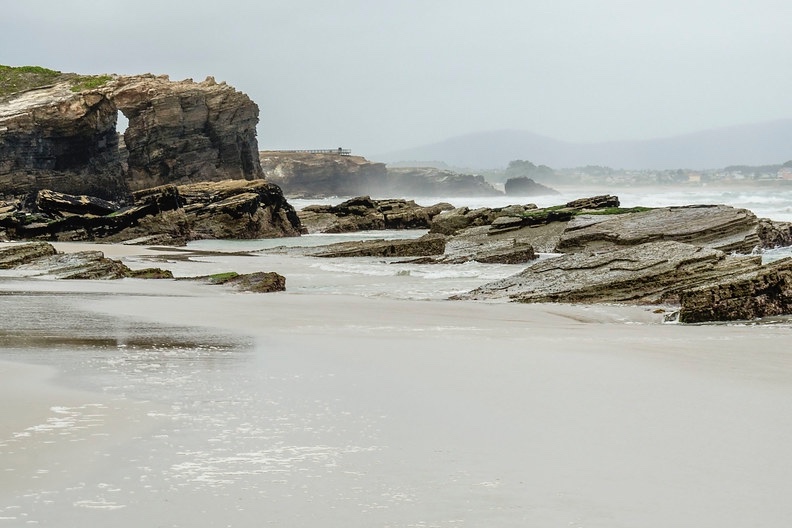
A rainy day at the famous Praia das Catedrais (Photo: Guillén Pérez via Flickr / CC BY 2.0)
Famous for its rugged coastline exposed to the North Atlantic and its warm-hearted locals with musical accents, this north-western region of Spain is a far outcry from the country’s crowded beach resorts.
Galicia’s drizzly climes and wild landscapes could be likened to those of Scotland – and the similarities don’t end there. The presence of the Celts in Galicia dates back to ancient times, with their influence still palpable today. Village hilltops are dotted with roundhouse settlements still in use, and the lamenting melody of the bagpipe prevails at local festivities.
If you’ve already decided on visiting this undiscovered region as your next travel destination (or are looking for that extra nudge before doing so), here’s a selection of some of Galicia’s towns and villages that, to this day, retain an authentic, rustic charm.
It was this fishing town on Galicia’s eastern coast that first heard news of the New World as announced by Alonso Pinzón in 1493. A full-size replica of the explorer’s magnificent caravel sailing ship, La Pinta, can be found moored alongside yachts and fishing boats in the town’s harbour, making for a postcard-perfect snap of your stay here.
Equally as impressive is Baiona’s grand 16th-century city wall. A walk along this well-preserved fortification promises views of the Atlantic with the Cíes Isles nature reserve just visible on the horizon. When dinnertime comes around, you’re be spoiled for choice. At the heart of the town is its Casco Vello (Old Quarter), replete with charming eateries serving tapas and refreshingly dry Albariño wine – many of these places are jam-packed with Spanish tourists and locals, especially during the summer months.
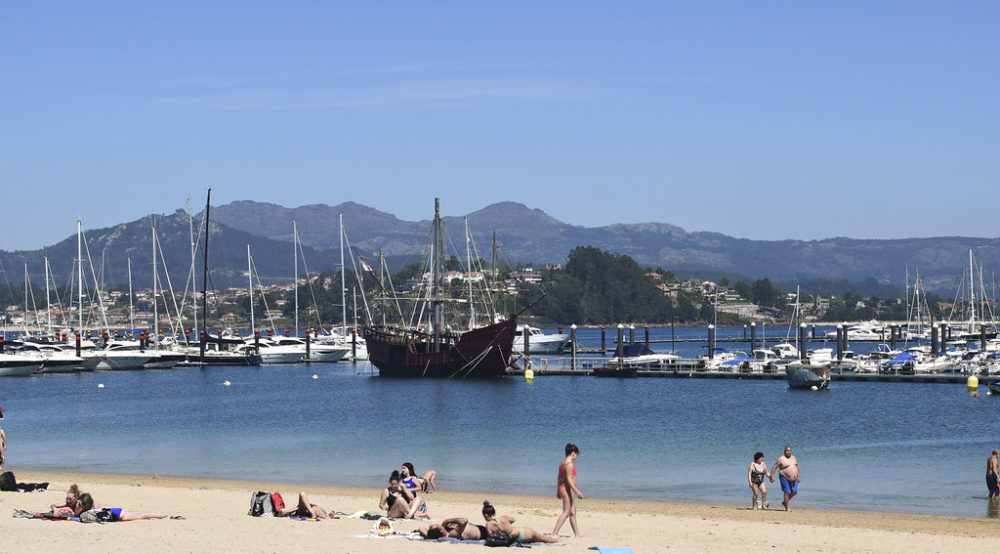
A replica of La Pinta sailing ship in Baiona’s harbour (Photo: Elisa G. Fernández via Flickr / CC BY 2.0)
The delightful Combarro sits on the banks of the River Pontevedra. Dubbed the most beautiful village in Galicia, the charm of its traditional fishing houses set above the ebb and flow of the Atlantic tides is difficult to resist. The village’s major lure is its numerous waterfront hórreos. These raised granite granaries are a symbol of rural Galicia, and, from a distance, can be mistaken for stone chapels or memorials to the dead.
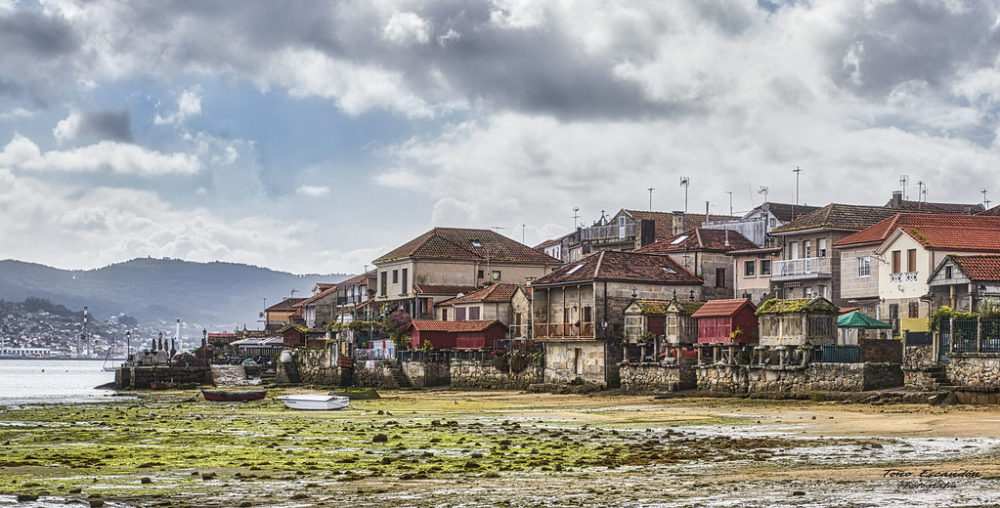
Combarro’s raised stone houses and granaries (Photo: Toño Escandón via Flickr / CC BY 2.0)
On Galicia’s unforgiving Costa da Morte – a coastline named on account of the lives its rough seas and unforgiving cliff faces claim every year – lie several quintessential Galician villages, Muxia among them. The cape where Muxia stands is headed by the Santuario da Virxe da Barca . Legend has it that it was here at this church where the Virgin appeared to Santiago – a story that has inspired many pilgrims on St James’ Way to make a detour to these rugged headlands.
Back in the village, a short walk up the Miradoiro do Corpiño promises views of the scattering of stone houses Muxia is home to, their russet-coloured roofs, and the foamy waters on either side. Then end your day with a visit to Lonxa d’Álvaro restaurant, where seafood specialities abound – the local navajas (grilled razor clams) doused in white wine sauce are particularly divine.
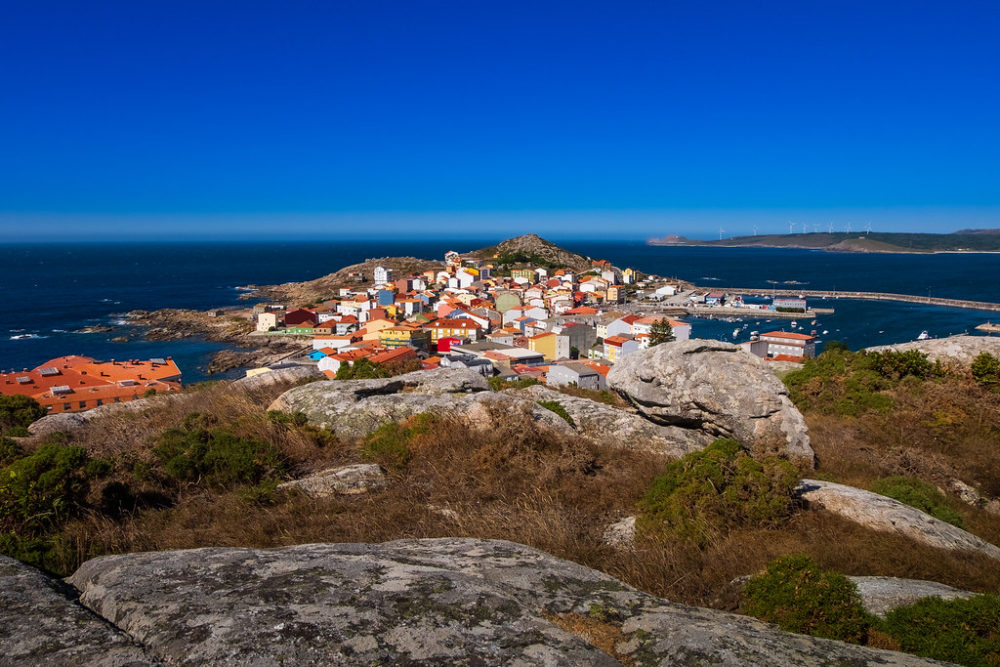
Views of Muxia from the Corpiño viewpoint on an unusually sunny day (Photo: J. A. Díaz via Flickr / CC BY 2.0)
On the other side of the Ría do Porto from Muxia lies Camariñas. With a quaint harbour and uncrowded promenade, it’s a town that lends itself well to a slow-paced afternoon. The village is renowned for its bobbin lace makers and their intricately braided cloth; its lace museum pays homage to this age-old craft. Nearby is the Cabo Vilán lighthouse, which sits atop a dramatic rocky crag and offers magnificent unimpeded sea views. The journey from Muxia to here takes you across the hinterland of the Costa da Morte estuary and offers an up close look at rural Galician life.
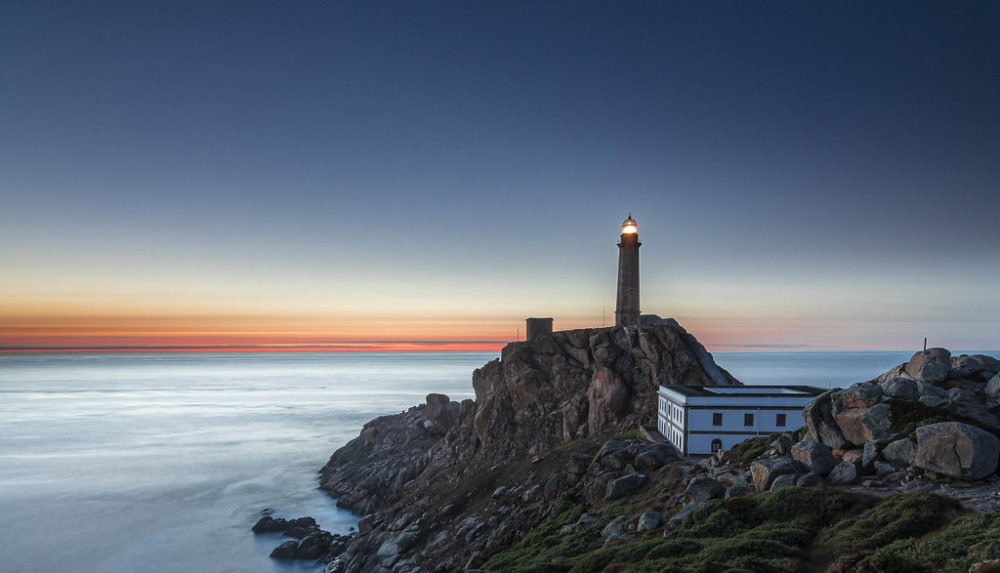
The sun setting on the Cabo Vilán lighthouse (Photo: José Ramón Dominguez via Flickr / CC BY 2.0)
In the words of Álvaro Cunqueiro – Galician playwright, poet, and novelist born in this otherworldly town – Mondoñedo is melancholy and silence. Once the capital to one of the region’s seven kingdoms, today it’s home to less than 5,000 people. Its rich heritage, though, includes a 13th-century cathedral with a kaleidoscopic rose window and the Barrio dos Muíños, an historic district criss-crossed by waterways and lined by the old stone houses of artisans. Much of their trade is still kept alive in the ancient crafts of pottery and blacksmithing, and more. Pop in to any of the area’s bodegas for a refreshing glass of Galician-grown wine, served with a complimentary bubbling hot tapa of caldeirada ( fish stew) – the perfect antidote to a drizzly day.
The town is an excellent base point for hikers wanting to explore the surrounding meadows, or those wishing to visit the arresting Praia das Catedrais , with its immense sea stacks eroded naturally by the sea to form majestic rocky archways.
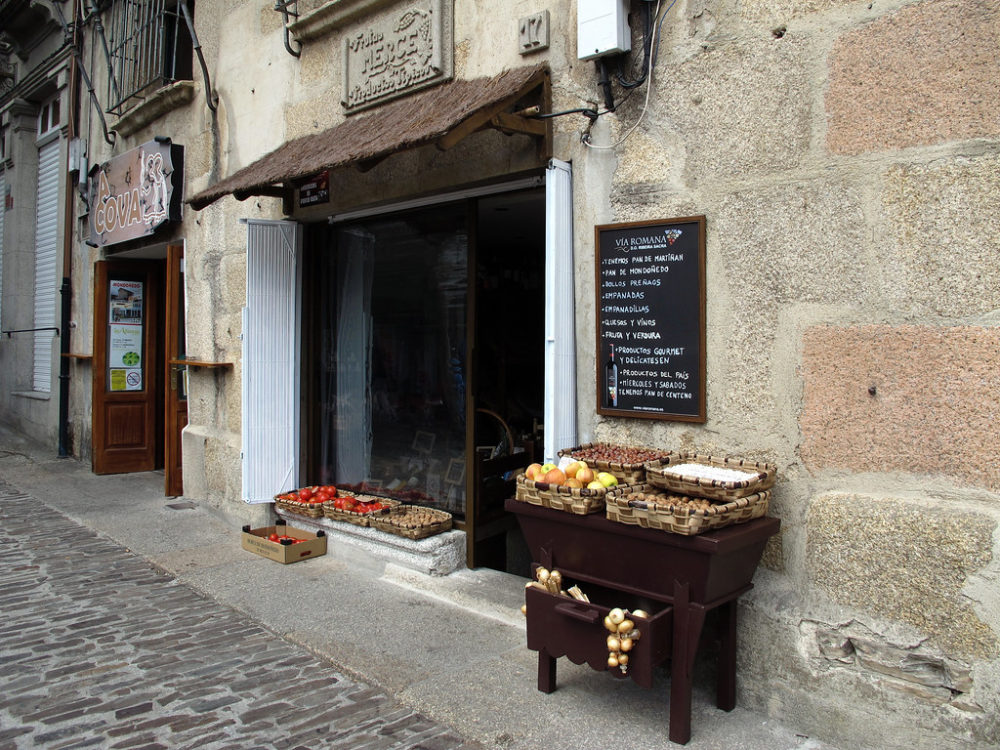
A local artisan shop in Mondoñedo (Photo: Rafa Gallegos via Flickr / CC BY 2.0)
Another former capital of the Ancient Kingdom of Galicia, Betanzos is set atop a small hill on the site of an ancient fort. This village in the northern Rías Altas region is steeped in medieval history and brimming with Gothic elements. Passing through one of the two remaining gates of its 15th century city wall is like travelling back in time.
Betanzos is considered by some as being home to Spain’s best tortilla de patatas . After spending the morning basking in the history of its steep cobbled streets, pull up a stool in one of its many bars and restaurants to try it for yourself. The best of all could be argued to be that served at O Poto – this Spanish omelette is firm on the outside, soft on the inside, and the colour of the midday sun.

Tortilla served with warm crusty bread in Betanzos (Photo: Daniel Candal Castro via Flickr / CC BY 2.0)
Further along Galicia’s northern Lugo coastline, eroded by fierce winds and rainstorms, lies Ribadeo. It’s located on the banks of the River Eo – both the natural border between Galicia and Asturias and a rich natural habitat for multiple species of bird, fish, and estuarine flora. Ribadeo is a hotspot in summer for Spaniards seeking cooler climates and a cool caña of the local Estrella Galicia beer.
High among reasons to visit this blustery township include its striking colonial-style manor houses, its exquisitely preserved, colourful old quarter, and the nearby Isla Pancha – the location of Spain’s first lighthouse-hotel with several possibilities for hiking. What’s more, not far from Ribadeo is Sargadelos; the location of an 18th-century ceramics factory where artisans continue to make beautifully decorated blue and white china.
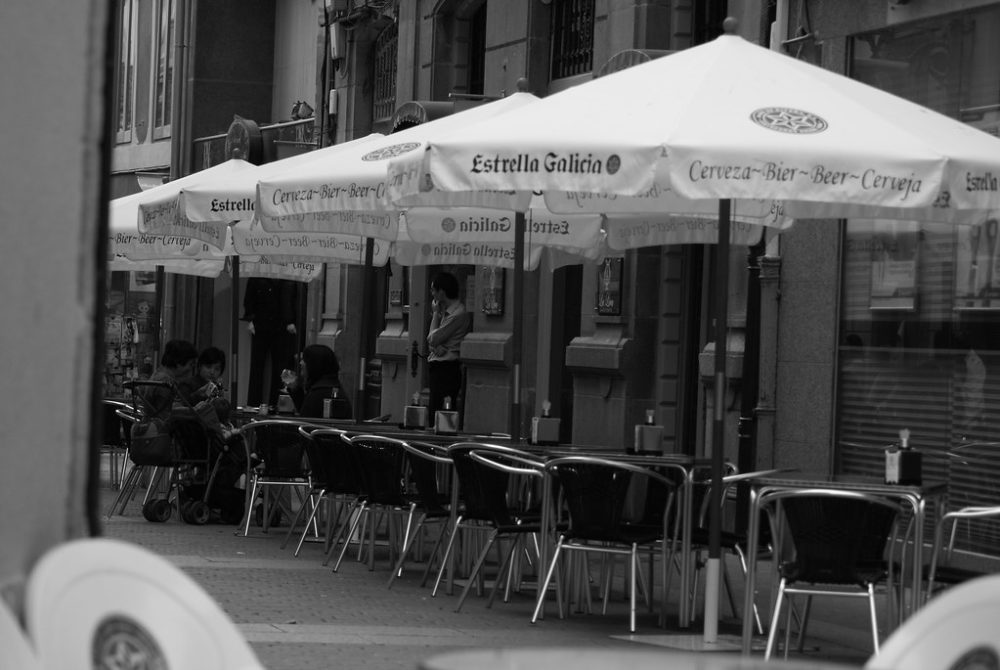
Bar terraces before rush hour in Ribadeo (Photo: Tito Villarmea via Flickr / CC BY 2.0)
Heading inland towards Galicia’s rustic farmlands, you’ll find Piornedo in the Dos Ancares National Reserve. A pre-Roman Celtic settlement, Piornedo today is more a hamlet than a village, and is the perfect spot to stretch your legs before continuing on your journey. Get there early in the morning to see the mist grazing the surrounding low mountains. As the round thatch-roofed cottages of Piornedo come into view, you’ll know you’ve come across something special. These preserved ancient stone dwellings – known as pallozas – are representative of Galicia’s humble lifestyle. There’s also one that’s been reclaimed as a museum so visitors can experience this for themselves.
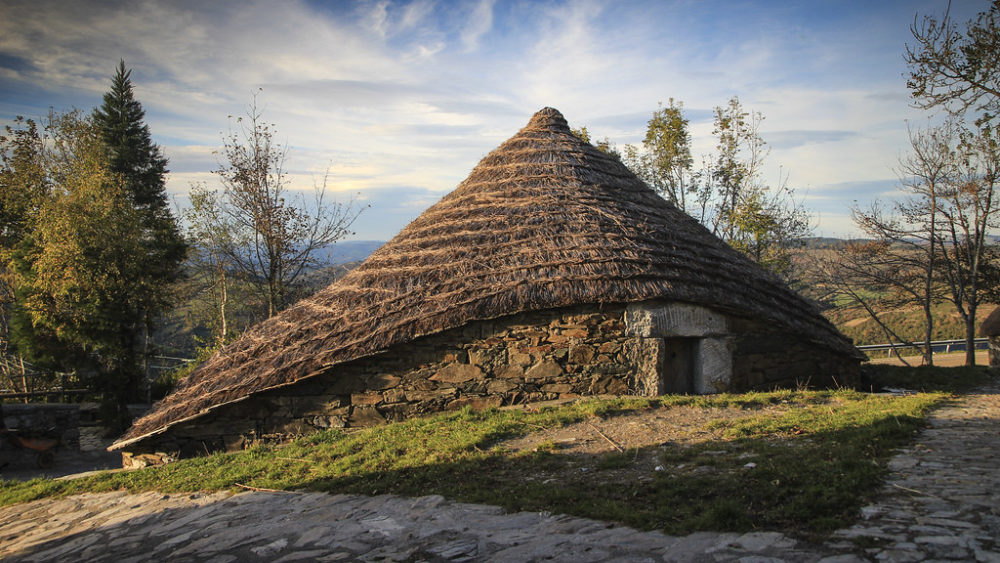
A traditional palloza in Piornedo (Photo: Manu Varela via Flickr / CC BY 2.0)
The south-eastern town of Verín stands in a large valley close to Galicia’s border with Portugal and is famous for being host to ancient spas with healing thermal waters and a burgeoning wine culture. Close by is Castillo de Monterrei with views of the lush green countryside below. Today, this stunning castle complex houses a modern parador. Don’t leave the area without trying the local Monterrei wines and Galicia’s justly famous pulpo a feira . As the local Gallegos say, octopus may be fished on the coast, but inland is where it’s cooked best.
The village’s springtime Carnival celebrations (known as Entroido in Galician) combine revelry and tradition, bolstered by the extravagantly dressed, masked cigarróns . A note to keep in mind: avoid the main square, unless you consider getting caught up in a fariñada (flour fight) the perfect way to fully experience Galician culture.
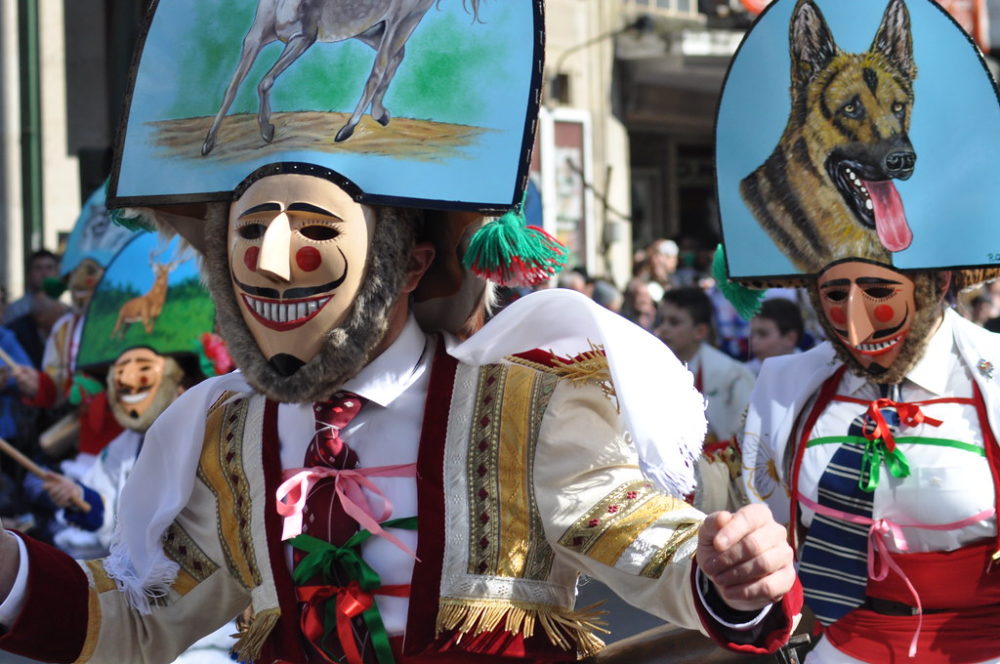
Masked cigarróns during Carnival celebrations in Verín (Photo: Adri Bouzada via Flickr / CC BY 2.0)
A mere half-hour drive away is the quaint Allariz, just south of the region’s capital, Ourense. Its delightful old quarter is best explored on foot and its main square offers the perfect spot for a coffee. With castle ruins, a city wall, several museums and a Jewish quarter, Allariz has something for everyone. Locals particularly enjoy its yearly garden festival, an initiative that fills the village with colour and excitement, above all when the votes for the best design are cast.
As this journey comes to an end, it’s worth noting that getting to Galicia has just been made that bit easier. In addition to its airports in Santiago, Vigo and A Coruña, the region has recently been added to Spain’s high-speed train (AVE) map, proof that it is finally being recognised as a worthy stop on a visit to the Iberian Peninsula.
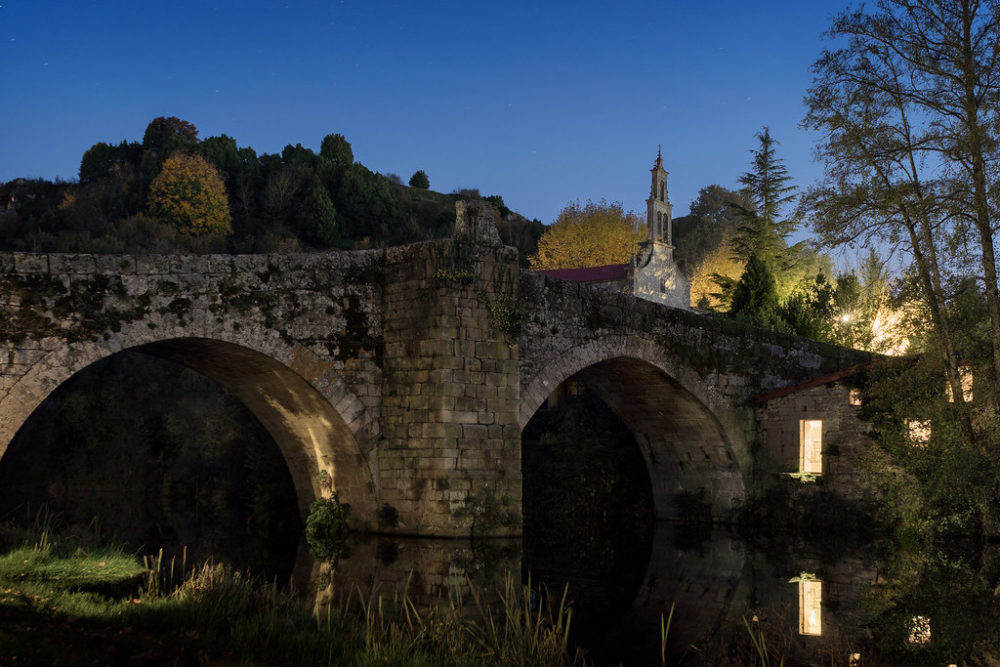
The Roman bridge in Allariz (Photo: Charlón via Flickr / CC BY 2.0)
Latest Articles
- The Best Summer Festivals in Stockholm & Sweden June 7, 2024
- A Comparison of Red Rocks Amphitheatre Tours from Denver June 6, 2024
- Where to Book Transfer from Reykjavik Airport to Your Hotel June 6, 2024
- 5 of the Best Siena Wine Tastings & Tours June 5, 2024
- The Best Italian Language Schools in Milan June 5, 2024

BEST PLACES TO VISIT IN GALICIA, SPAIN (THAT ARE AFFORDABLE)
What can I say about the best places to visit in Galicia? There are so many: the majestic ancient cities of Santiago de Compostela and Lugo, the stunning vistas of its 1030 miles (1,660 km) of coastline, its picturesque fishing villages with the freshest seafood, its dense, lush, green forests…the list goes on and on!
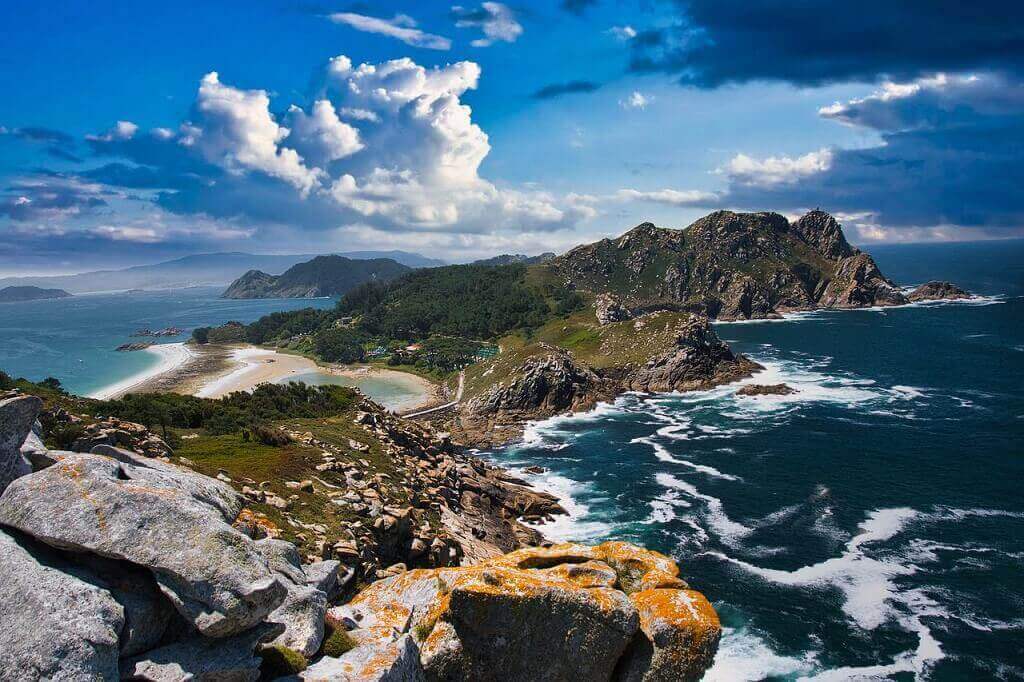
Galicia is one of Spain’s best kept secrets. This autonomous community is situated in the northwestern corner of the Iberian Peninsula, next to Asturias and immediately above Portugal. With such proximity, it was inevitable that Galicia share its culture with Portugal although it is part of Spain.
Two official languages are spoken in Galicia, Spanish and its very own Galician language , known as Galego, a Latin root language spoken by the Romans who conquered the region in the first century CE. Galego is spoken by about 3 million people throughout the region.
When is the best time to visit Galicia?
I visited Galicia at the beginning of the summer, just in time for some of the liveliest festivals in the region. June to September is the best time to visit Galicia as this is the driest and sunniest period.
Average temperature in the Galician summer is 72°F. Despite summer being the driest period, it’s still going to rain in Galicia -that’s why it’s so green. Travelers are advised to come prepared.
What is Galicia famous for?
Food! Particularly seafood. If you love seafood, Galicia is a must-visit destination for the freshest delicacies from the cold waters of the Atlantic Ocean as well as the Bay of Biscay. Going on tapas crawls and exploring food markets are among the best things to do in Galicia.
Galicia also enjoys a world-renown reputation for excellent wine, the albariño, from the many vineyards throughout the region.
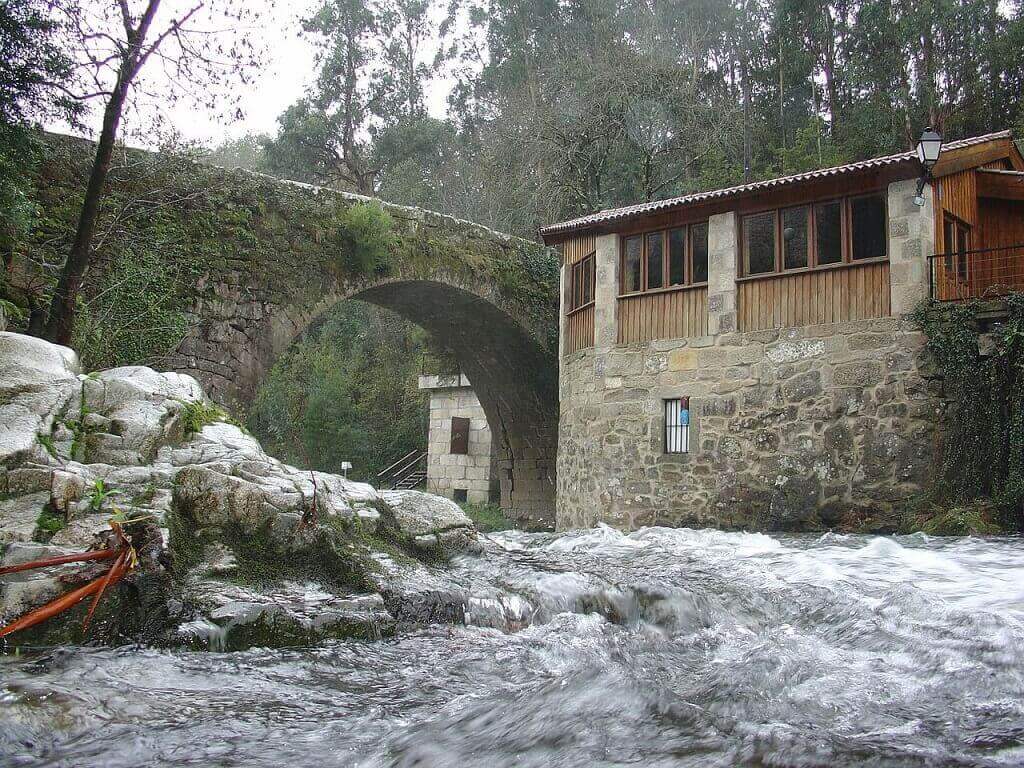
Other claims to fame include the wild, natural vistas and the historic cities of Galicia. But the region’s unique, sustainable competitive advantage is that it is the final destination of the Camino de Santiago pilgrimage.
BEST PLACES TO VISIT IN GALICIA
Table of Contents
How to choose the best places to visit in Galicia from an endless list? We asked frequent travelers to weigh in with their recommendations.
Costa Da Morte (Death Coast)
Although the limits of this stretch of the Galician coast are not clear, it is often said that Costa da Morte covers the area between the municipalities of Malpica and Muros, a couple of villages that belong to the province of A Coruña.
This piece of paradise boasts the longest beach in Galicia, lighthouses that used to help or confuse sailors (the region took its name from the many shipwrecks that took place in that area), soaring cliffs and fishing villages.
Lovers of raw landscapes and everyone else looking to get away from the crowds will appreciate this coast because, if you dare to visit this area in winter, solitude is almost guaranteed.
You might come across locals, some surfers, and fishermen but the tourist crowds do not usually dare to come during the winter season. The possibility of rain (‘it always rains in Galicia’ is a common thought) usually stops them.
The newly opened Meiga do Mar hotel in Carnota is an excellent option for exploring the area. It has a relaxing spa, a wonderful terrace to have a drink, and spacious rooms.
What are you waiting for? Dozens of unique experiences await you in Costa da Morte , one of the best places to visit in Galicia, Spain.
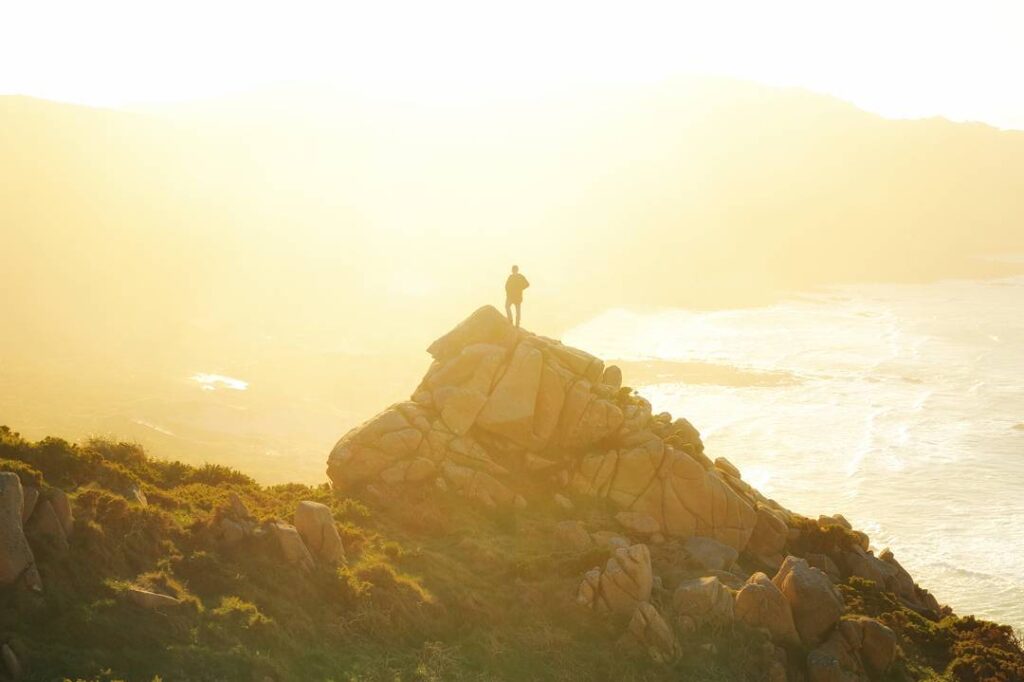
Inma blogs at A World to Travel
Love Spain? Check out HIDDEN GEMS IN SPAIN OFF THE BEATEN PATH and A 2 WEEK ITINERARY FOR ASTURIAS: NORTHERN SPAIN’S PARADISE
Santiago de Compostela
Right in the western corner of Green Spain is Santiago de Compostela, a stunningly beautiful historic city full of labyrinthine alleys, elegant squares and ancient religious buildings waiting to be explored.
Visit here as you road trip through northern Spain , and you’ll see pilgrims covering the final few miles and proudly displaying their vieira , the scallop shell badge that you’ll have seen wherever your route has coincided with the Camino de Santiago, possibly the most famous walk in the world.
The UNESCO World Heritage Site of Santiago de Compostela is undoubtedly one of the most beautiful cities in Spain and picking out the top sights can be hard. If you only see one thing, it must be the imposing Romanesque Cathedral of Santiago de Compostela, where all roads seemingly lead, including the famous Camino.
Approach over the grand Plaza del Obradoiro for fantastic views of the frontage, before entering to admire the Gothic and Baroque interior. It’s worth the small fee to climb to the roof for panoramic views of the city.
There are lots of other attractions to see, which you should aim to pass as you wander the medieval streets and alleys of the old town, by far the best way to experience Santiago de Compostela.
Look out for the Abbey of San Martin Pinario, the second largest religious monument in Santiago after the cathedral, and Pazo da Fonseca, a delightful 16th century palace.
This patch of Spain, including Galicia, is known as Green Spain, because it rains so much! Santiago de Compostela is probably best visited in spring or September to October – to avoid both the blisteringly hot summer and the tourists that throng here when the sun shines.
Stay at the Parador De Santiago de Compostela for its unrivalled location, history, traditional decor and huge breakfast buffet!
If you have limited time, Santiago is one of the best places to visit in Galicia.
Izzy blogs at The Gap Decaders
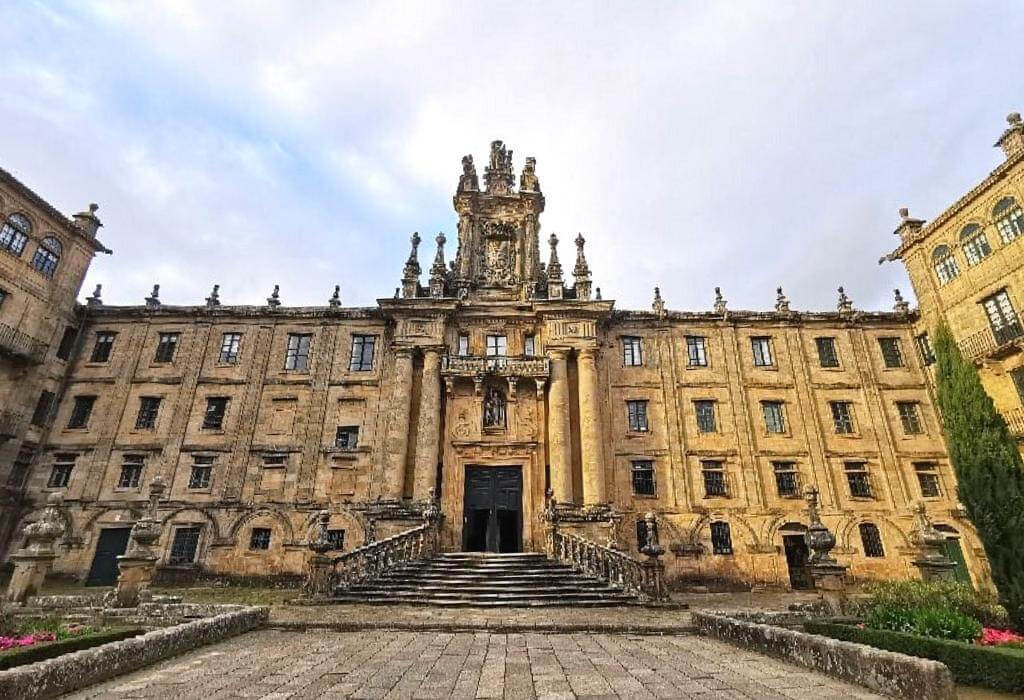
A UNESCO World Heritage site, Lugo is an ancient city in the interior of the region, one of the most interesting cities of Galicia and arguably one of the best places to visit in Galicia. The city lies about 60 miles east of Santiago de Compostela.
Lugo’s most outstanding features is that it is completely surrounded by its original Roman wall, one of the best preserved of the Roman Empire. In fact, Lugo is a treasure trove of Roman art.
The House of Mosaics is a well-preserved former home of a wealthy Roman and contains examples of ceramic and mosaics for the Roman period.
The nearby Roman Bridge and ancient Roman baths complete the collection of fine examples of that period. The Municipal Museum is also worth a stop to see articles from the Roman and other periods.
The people of Lugo are so into their Roman heritage that every June the populace dresses up in period costumes to perform reenactments of life under the Romans. It is one of the most important festivals of the area.
Strolling through Lugo’s Old Town is like traveling back in time. The city center boasts the Cathedral of Santa Maria completed in 1769.
If you REALLY want to travel back in time, stay at the Hotel Monumento Pazo de Orban , right next to the ancient Roman wall.
Nature lovers will appreciate the Ribeira Sacra area, a nature reserve with forests, meadows, vineyards and wineries. A day wandering – and sampling wine – at the wineries is just glorious.
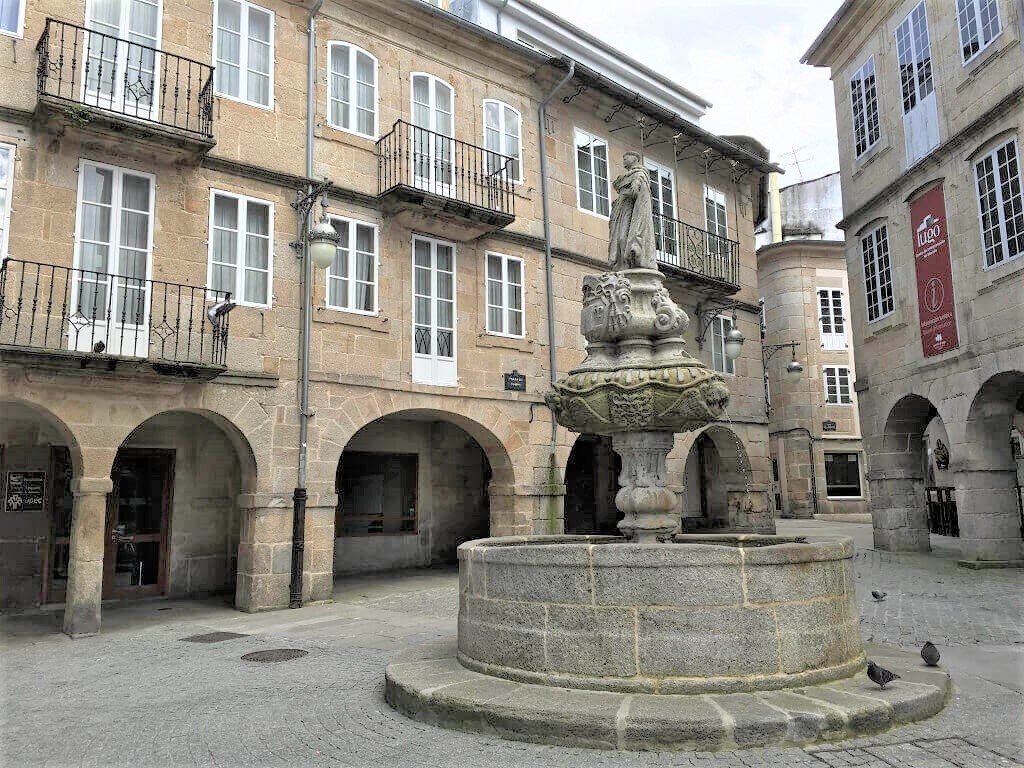
Talek blogs at Travels with Talek
Are you thinking about visiting Galicia and getting to know its festivals, gastronomy, music, and traditional dances?
In the fishing village of Moaña one of the most important local festivals is held, the Moaña Antiqua Medieval Festival. This festival will take you back in time to live a unique magical experience from the Middle Ages!
It takes place in Moaña, Galicia, Spain in the parish of San Martiño with 2,062 inhabitants and is celebrated near the beautiful Church of San Martiño. This is a Galician Romanesque style church from the 12th century that suffered numerous attacks by Barbary pirates from the North of Africa.
During this festival, you will find numerous arts & craft stalls, taste traditional gastronomy, listen to Galician Celtic music, and dance shows. There will also be workshops for the little ones so they can learn about medieval writing, wood carving, coin minting, stamp sealing, etc…
You will see artisans making pieces using traditional techniques and savor the wines in the Galician taverns.
One of the most impressive shows that you cannot miss at this festival is “Errantes” performed by a group of actors called Troula Animación, which is a spectacular night-fire show.
The Concello de Moaña and the Moaña Antiqua Cultural Association are in charge of organizing this festival that is celebrated every year on June 24th, 25th, and 26th.
Apart from this festival Moaña has a lot to offer the visitor… beautiful golden beaches like the popular Xunqueira Beach, bars, restaurants, walking trails, and important cultural heritage.
So, if you want to visit Moaña during these dates and enjoy the Moaña Antiqua Medieval Festival, our Eat & Walkabout experts recommend you stay at the Hotel Bienestar Moaña located in the town centre with rooms overlooking the wonderful Vigo Bay.
For dining out we recommend the Restaurante Matices, where you can enjoy the Galician cuisine, especially tasting the amazing abundant seafood like the delicious mejillones (mussels), the star dish of this brave seafaring village!
Tiernan blogs at Eat and Walkabout
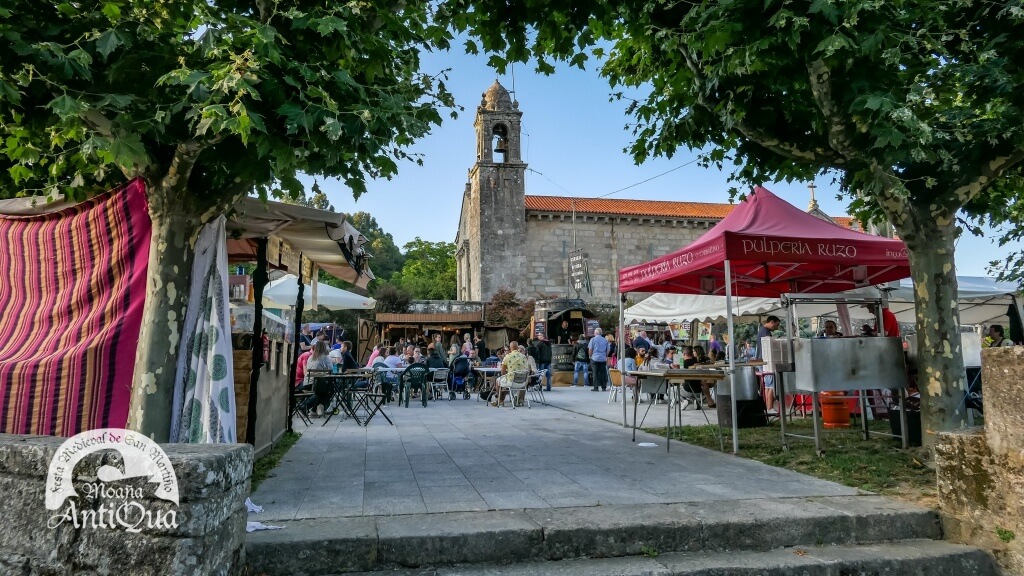
Situated along the northwestern Spanish coastline on the banks of the Ria de Vigo, Vigo is easily one of the best places to visit in Galicia, Spain. A dominant name in the fishing industry, Vigo is home to one of the largest fishing ports in all of Europe!
Unique to this Spanish destination, visitors can enjoy spectacular views of the grand harbor from terracotta rooftops and unlimited fresh seafood straight off the docks.
Oysters and crab are specialties, though you can find everything from spider crabs to mussels, and even barnacles! Often accompanied by a good Galician Rías Baixas wine, seafood in Vigo is at its finest.
To get there, most visitors fly to the Porto International Airport in Portugal where they will be just a quick 2.5-hour train ride from Vigo. Madrid is the next closest option with a train time of about 6.5-hours and at least one changeover.
The best time to visit Vigo, Spain is during the summer months of June and September. During this time, you’ll still experience lovely weather but far fewer tourists and better deals on flights, trains, and accommodations.
If you happen to be visiting during the month of July, you may be lucky enough to attend the Wild Festival where you’ll get to watch an amazing line-up of artists and performers from around the country including The Galician Messengers!
Overflowing with unique history and Spanish culture, Vigo is home to some of the most hospitable people in Europe. Just be sure to learn a few helpful Spanish phrases before you arrive since much of the population speaks mainly Galician and Spanish.
A perfectly located place to stay in Vigo is the Sercotel Hotel Bahia de Vigo . It is situated between Vigo Old Town and the Cies Islands’ departure pier.
Emily blogs at Emily Embarks
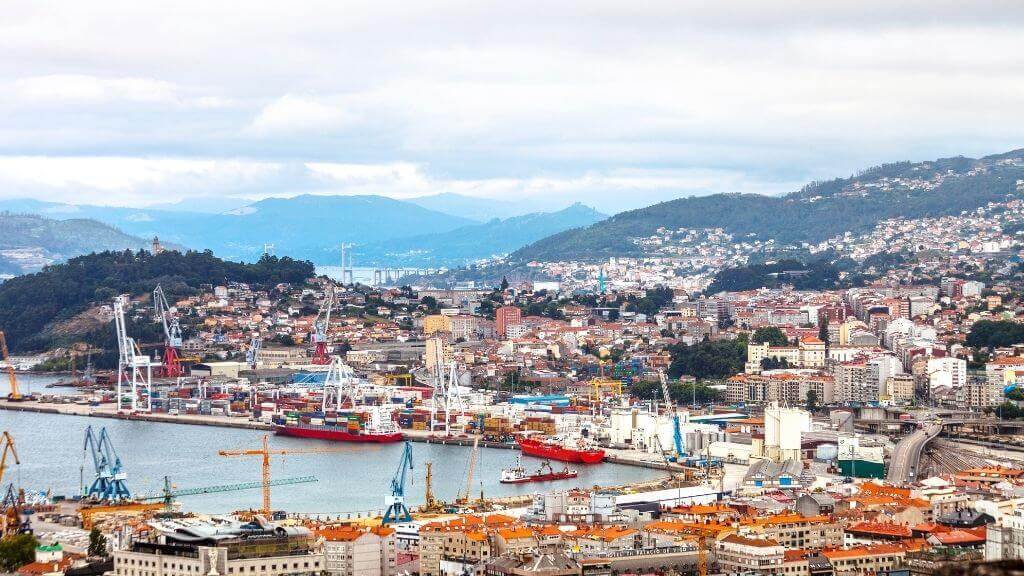
Cabo Finisterre
Cape Finisterre is a picturesque cape on the so-called Coast of Death, a part of the Atlantic Coast of Spain. It’s a not-to-miss place in Galicia. The name “finis terrae” in the Latin language means the end of the world. In the old times, the cape was considered the end of the known world.
The scenery along the peninsula is truly spectacular; rugged rocky cliffs, sandy beaches, dramatic drops, lush-green forest, and breathtaking lookout points. Cape Finisterre is a great spot for watching the sunset.
Things not to miss at Cape Finisterre are Praia do Coveiro, Praia do Mar de Fora, Monte Facho, the Lighthouse, and Mirador Finisterre. Finisterre town is situated about 3 km away from the cape.
The city has many hotels, restaurants, and souvenir shops. Local restaurants serve freshly caught fish and seafood.
You can try traditional Galician dishes such as Pimientos de Padrón, Pulpo a la feira, steamed mussels, and tarta de Santiago.
Finisterre can be reached by bus from Santiago de Compostela. The bus journey takes 2 hours. It’s possible to walk from Santiago to Finisterre following a scenic trail . The total distance of the route is 90 km. The walk takes 3-4 days.
The summer months, June to August, are the best time to visit Cape Finisterre. When it’s nice, warm, and often sunny, it can get quite windy at the cape at any time.
The best and the most romantic place to stay in the area is Hotel O Semaforo situated in the old lighthouse building on the tip of the cape.
Alya blogs at Stingy Nomads
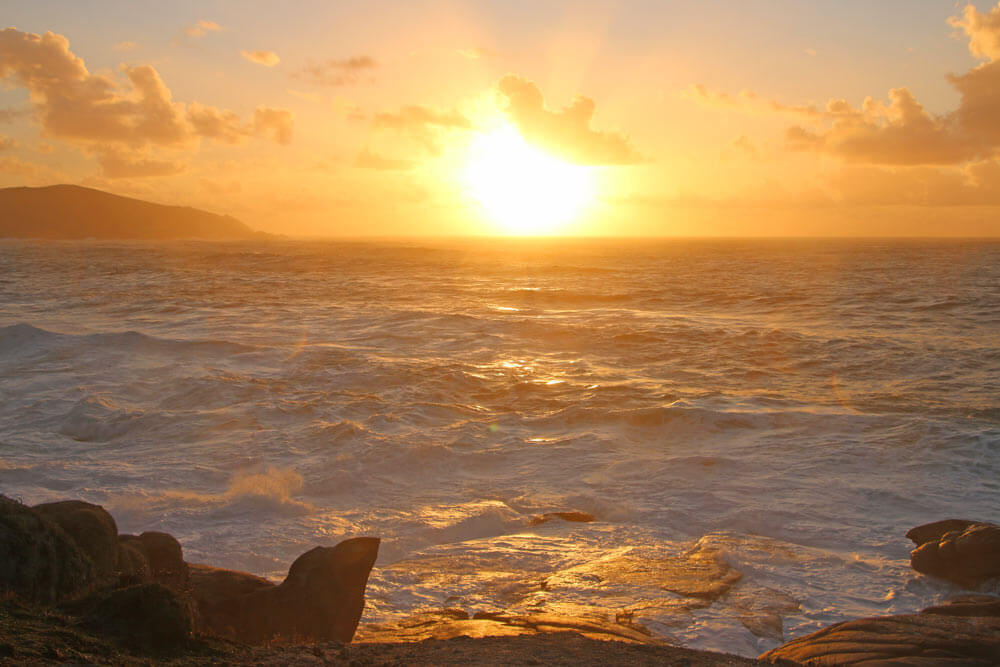
Can’t get enough of Spain? TOP 16 THINGS TO DO IN GRAN CANARIA, CANARY ISLANDS (SPAIN)
Tui is a charming hilltop village located just across the river from Portugal. The undisputed highlight of this Galician city is the magnificent Tui Cathedral which dates back to the 11 th century. The cathedral sits atop the hill and can be seen from miles in all directions.
Tui is situated in the fertile Minho River valley which has been inhabited since prehistoric times. A former Roman settlement, the city later played a key role in the wars between Portugal and Castile.
Skirmishes regularly took place between Tui and the walled city of Valença on the other side of the river.
Today Tui is an important stop on the Portuguese Camino , a historic path that leads to the pilgrimage city of Santiago de Compostela. While many pilgrims start their journey in Lisbon or Porto in Portugal, some choose to begin walking at the Tui Cathedral. Located 116 km (72 miles) from Santiago, the distance is just long enough to earn the coveted pilgrim’s certificate.
When visiting Tui, be sure to tour the inside of the romanesque Cathedral. The tour includes a visit to the roof with spectacular views of the Minho River valley.
Other nearby attractions include the Church of Santo Domingo, the distinctive Tui International Bridge, and the beautiful medieval city of Valença just across the Minho River.
Tui enjoys mild weather year-round with temperatures reaching 78 degrees F (25 C) in the summer months and 45 degrees F (7 C) in the winter. A great time to visit Tui is on the second Monday after Easter. This is when the city celebrates the Festival of San Telmo, the city’s Patron Saint.
There are many ideal accommodations in the area. If you’re on a budget, I recommend Residencial Portas do Sol in Valenca, Portugal, just accross the river from Tui.
For a memorable accommodation experience, stay at the Parador de Tui , part of the Paradores de España group. These are a collection of hotels established in refurbished Spanish monasteries, abbeys, palaces and hospitals.
Katy blogs at A Rambling Unicorn
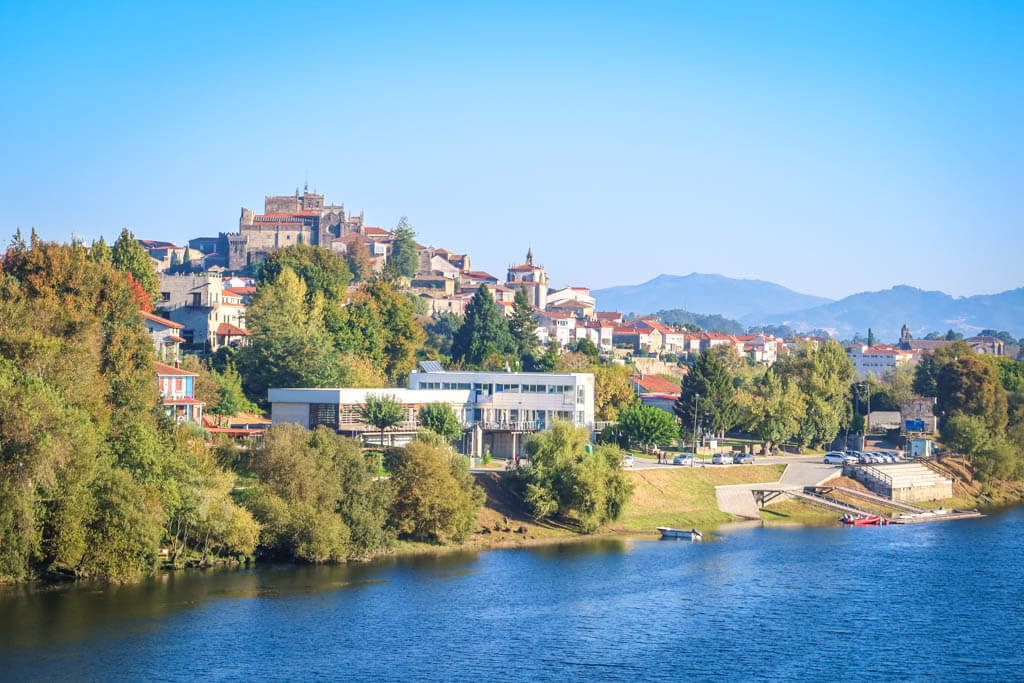
Insider tip: Want to delve deeper into Galicia’s history, cuisine, culture and traditions? Book with Eatandwalkabout.com . This Galician group offers experiences you are unlikely to have elsewhere. Enjoy hikes in the Galician countryside, Galician cooking classes taught by native chefs and cultural tours to cities as well as coastal towns throughout Galicia.
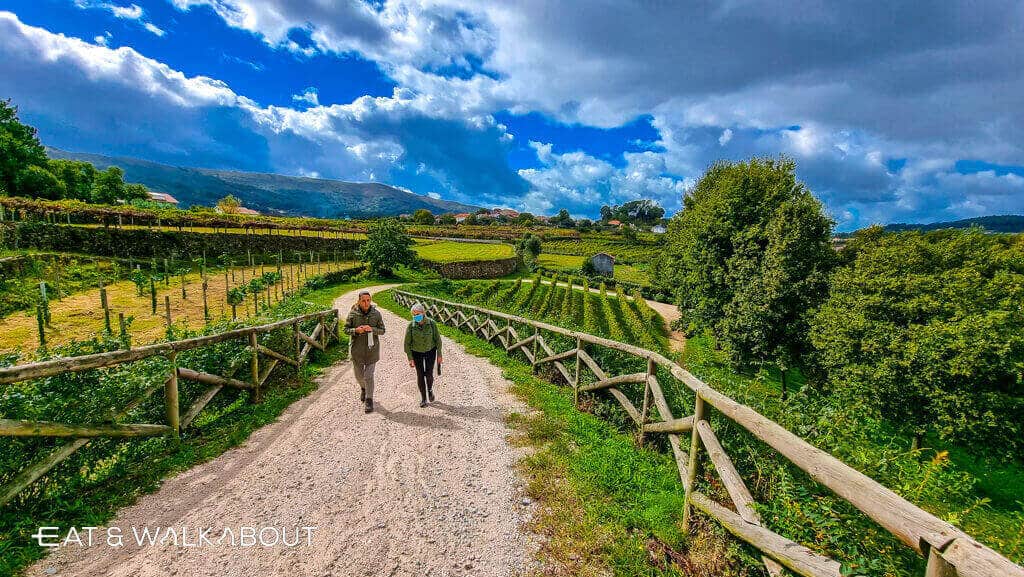
How to get to Galicia
Galicia has three international airports in Santiago de Compostela, Vigo and A Coruña. The roads are modern and easily accessible. The region is served by RENFE, the Spanish rail service and there is reliable and timely bus service.
What to eat (and drink) in Galicia
The unofficial regional dish is octopus Galician style or a Feira, served over sliced potatoes sprinkled with paprika and doused with olive oil. The tastiest Galician dessert is the Tarta de Santiago. But Galicia has many regional specialties.
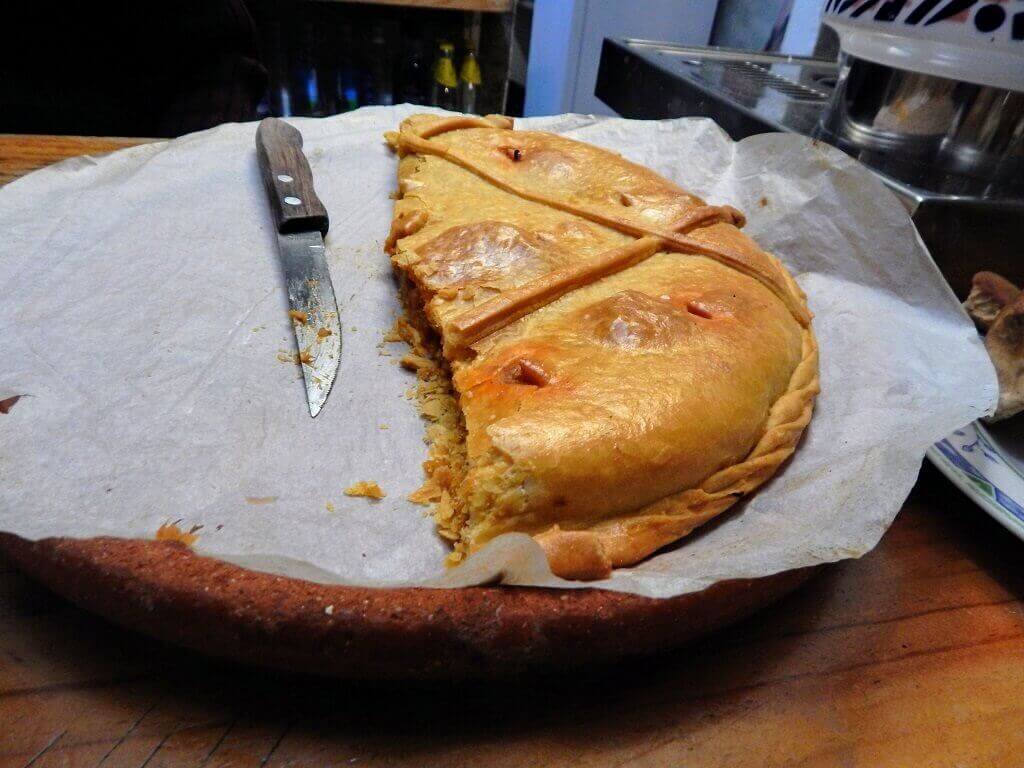
Other classic Galician dishes you should try include Galician empanadas (large meat-stuffed pastry, caldo Gallego (hearty stew with meat, beans and veggies), ternera Gallega (veal famed for its tenderness), queso tetilla (flavorful cheese, great with wine).
Here are even more delectable Galician dishes and drinks.
Galician wines are outstanding. Try the crisp, dry albariño. The excellent local beer is Estrella Galicia, widely available throughout Spain and many other countries including the United States.
If you want to experience the best of green Spain and focus on the best places to visit in Galicia, stock up on some of these reference materials.

What are our thoughts on visiting Galicia? What do YOU think are the best places to visit in Galicia, Spain? Let us know in the comments.
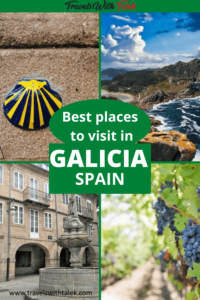
BTW, if you are getting ready for your trip, make sure to take advantage of these useful, money-saving links to book your trip:
- Research and book your flight with Skyscanner . I have found them to be the best because they list all airlines including the budget ones. You are always sure of having researched all options.
- For car rental around the world, Discover Cars has flexible pickup and drop-off options, I recommend Discover Cars .
- Book your accommodation with Booking.com . I find they have a wide selection and a nice, user-friendly, transparent website.
- Protect your trip and, more importantly, protect yourself with travel insurance. I use Travelinsurance.com and have been very happy with them.
- Looking for a small group tour to unforgettable destinations with top professionals? Intrepid Trave l is your choice.
- For more general tours to any destination or attraction, book with Viator . Check them out.
- Need a visa? Get your visa for all countries with Passport Visa Exp ress.
- Looking for a cool walking tour to explore a city? My favorite walking tours are offered by Take Walks.
- Food and drink tours are the best way to enjoy a city. And Devour Tours are my favorite.
- Looking for a good VPN to protect your security, privacy and freedom online while traveling? Nordvpn is your best option.
- The best and most economical way to stay connected while traveling is with an Airalo eSIM.
I personally use, and can recommend, all the companies listed here and elsewhere on my blog. By booking through these sites, the small commission we earn – at no cost to you – helps us maintain this site so we can continue to offer our readers valuable travel tips and advice.
Talek Nantes
Leave a reply cancel reply.
Your email address will not be published. Required fields are marked *
This site uses Akismet to reduce spam. Learn how your comment data is processed .

Disclosure: As an Amazon Associate I may earn from qualifying purchases. Posts may contain affiliate links. If you click on one of them, we may receive a commission at no cost to you.

JOIN OUR NEWSLETTER

Lets Connect
Privacy policy.

Your Galicia Road Trip Itinerary: Why You’ll Love Spain’s Rugged and Wild Coast
February 19, 2024
Enjoy this four day Galicia road trip itinerary and explore one of the world’s most curious landscapes. It’s a great way to embrace slow travel in Spain.
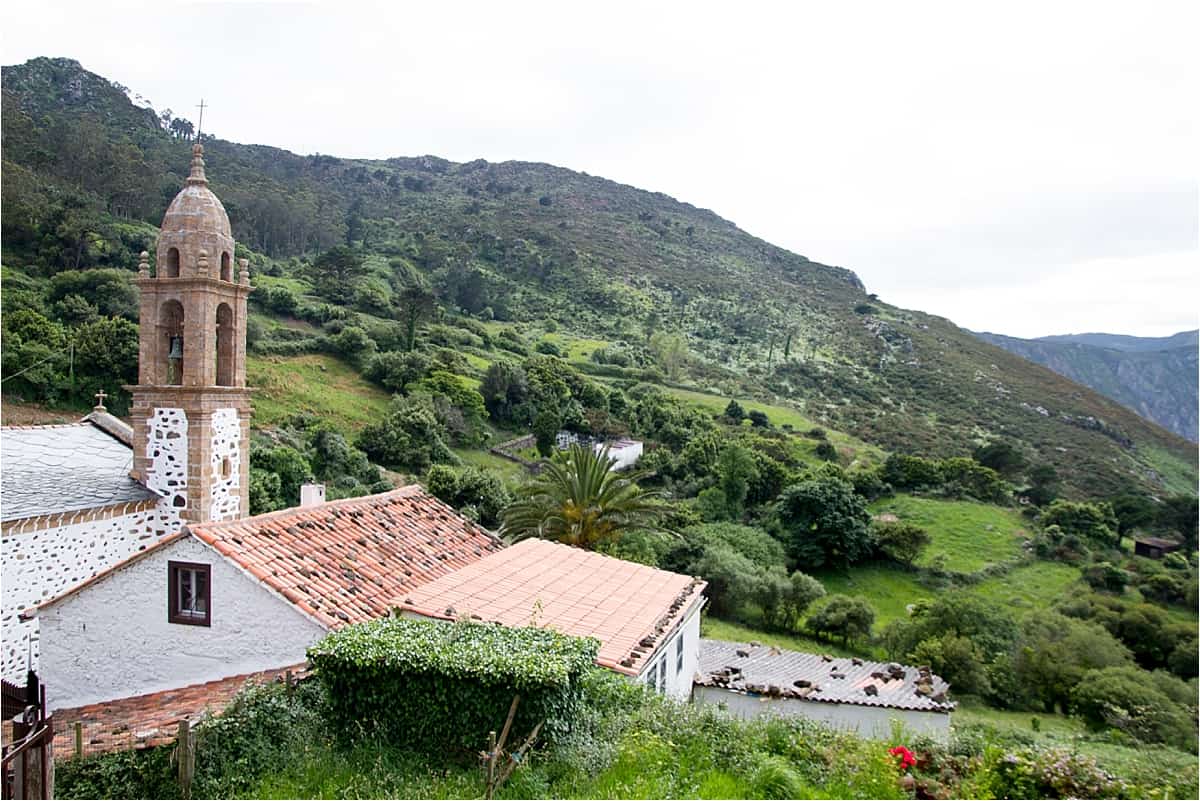
Table of Contents
Your Galicia Road Trip Itinerary
Every coast is salty. But northwest Spain’s Galician coastline seems the saltiest of all: its landscape licked into shape by the churning, whirling waves, its cuisine at one with the sea and its architecture, history and general attitude shaped by the way that surf reaches the shore.
This is a place to experience the real side of Spain, away from tower blocks, fake paella and concrete-edged, crowded hotel pools.
Overdeveloped resorts, you know who you are.
And it’s an ideal spot for a self-drive holiday. Without further ado, here’s how to plan a Galicia road trip. Beaches, lighthouses and fine food await.
What’s So Special About Galicia?
In Galicia, the curves and swerves of the coastline resemble the fused sutures of the skull: intricate, delicate and yet immensely strong.
Few regions in the world are like this, the closest one to mention would be Ireland’s wild Atlantic way. In fact, should you set sail without a sail from that part of Ireland, Galicia is where you would wash up, as many monks did centuries and centuries ago.
- Recommended reading: how to plan a road trip by yourself
Start and Finish in La Coruña
With short flights from London and a car and sat nav on board, it’s easy to wiggle your way along the coast from La Coruña to Santiago de Compostela and enjoy an authentic Spain that few visitors get to see.
I cheated, a little, in this case. Heading off with a guide, a driver and a couple of good friends, this plan left me with more time to gaze through the windows, to stand on the clifftops and to track down some churros.
The fields may be green, the weather changeable, but some of the sweetest parts of Spanish culture still, of course, remain.
See also this article on unique things to do in Spain and Spain’s best road trip itineraries.
Your Galicia Road Trip Itinerary: Day by Day
This Galicia Road Trip works as a great introduction to the area for people looking to get a taste of the authentic side of Spain, far from crowds of tourists.
It includes winding turns along narrow roads that glide above the crashing surf, so it’s not for the faint of heart. You’ll find plenty of different stops, all short, and all with a focus on great views and great food.
I’ve added in some recommendations on restaurants and hotels to save you time. Enjoy!

Galicia Road Trip Itinerary: Day One
La Coruña makes the start and end of this Galicia Road Trip. It’s a moderate sized city with a UNESCO World Heritage site that’s quite the surprise.
To begin with, though, just get your bearings, hire the car and enjoy some great food.
Where to Eat
Try Arbore Da Veira .
- Modern local food, trendy decor with private areas.
- 10-course menu with 8 dishes and 2 desserts – 55 euros
- 15-course menu with 12 dishes and 3 desserts – 70 euros
Where to Sleep
- Hotel Riazor – a slightly dated place to rest but it’s right on the beach and with easy walking distance of cafes and restaurants.
Galicia Road Trip Itinerary: Day Two
Now it’s time to hit the road and start to get a sense of the area on this Galicia Road Trip. First stop is…
This seaside town combines side streets, old churches, forts and more and is a joy to walk around for an hour. Make an early start to catch the fresh seafood market and look up to catch the best of the Galician balconies: enclosed in glass because it does like to rain a lot here.
Walk uphill to reach the Igrexa de Santiago church, a 16th century chapel built by Don Fernando de Andrade.
Take a Boat Trip to Redes
In good weather, the short boat trip to Redes gives you the feel of the salty nature of Galicia. Redes is a picturesque fishing village with colourful houses best seen from the water.
Stop for a small churros y chocolate or early coffee, before heading back to your car.
- Book a boat trip through Alta Vela.
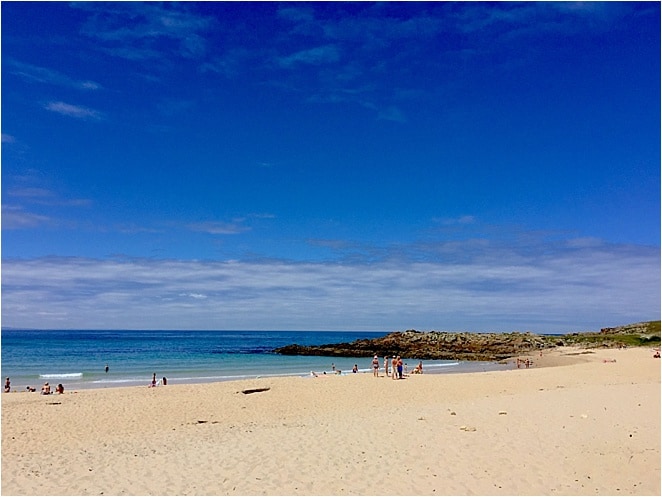
Praia de Doniños Surf Beach
It’s a short drive from Pontedeume to the laid back surfer beach of Prai de Doniños. While you’ll find sand, long grasses and dunes, it’s a wild place with a small beach bar and no blaring soundtracks.
Lunch at Leira Antiga
Spain eats late, even in the north, so don’t head here before about 2pm. Leira Antiga is a hotel and restaurant with a stunning outdoor terrace that overlooks the bay of Cedeira.
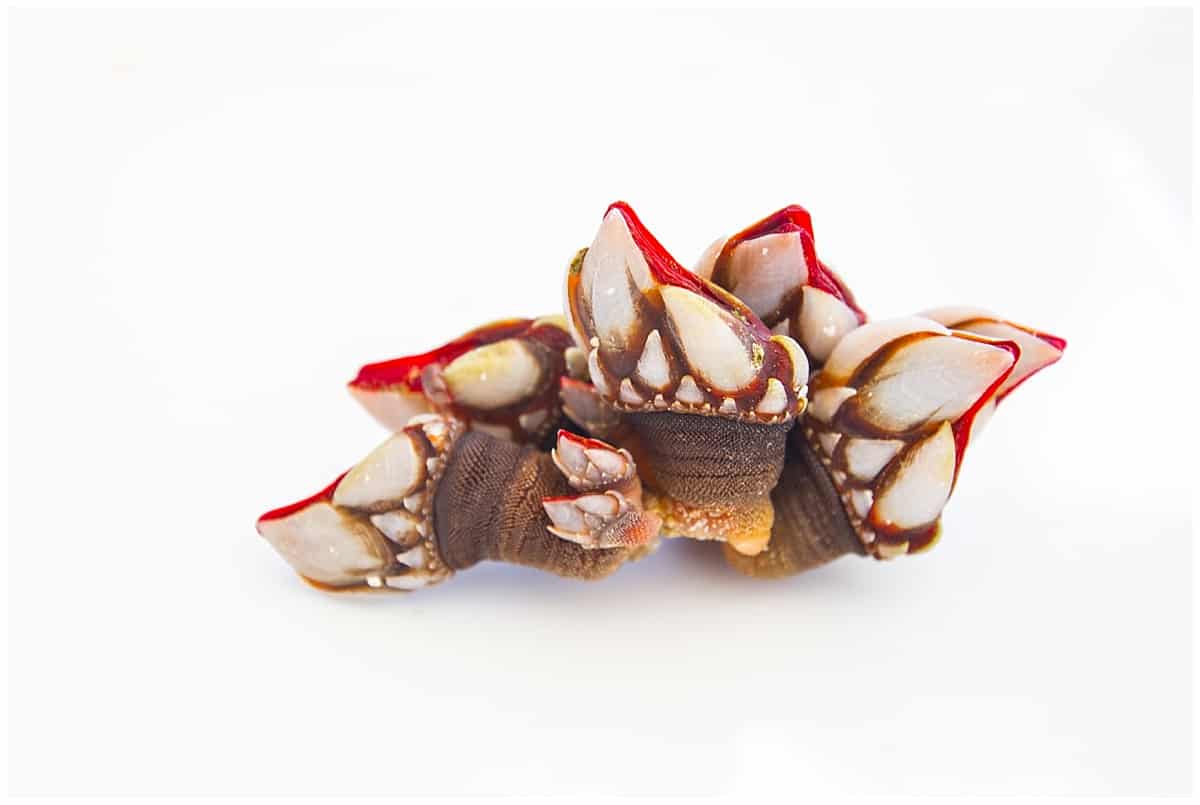
Blistering Barnacles
With miles and miles of coastline peppered with fishing villages, it’s no surprise that Galicians love their seafood.
Make sure to try the barnacles. Though they look like dinosaur claws, they’re surprisingly tasty, served freshly cooked and dripping with their own juice.
San Andrés de Teixido
“If you don’t come when you’re alive, you’ll visit when you’re dead.” So begins the spooky legend of the small clifftop village of San Andrés de Teixido.
Walk through cobbled paths cloaked in green to reach the sanctuary where locals leave wax relics of dismembered body parts by the altar.
Vixía de Herbeira Viewpoint
At 621 metres, the Vixía de Herbeira viewpoint lives on one of the highest cliff faces in Europe. On the proverbial clear day, you can sometimes see the Sisargas Islands and Estaca de Bares Point.
Even on a cloudy day, it’s worth the hair-raising drive. The clouds and swirling winds give a sense of menace and of great, wide open spaces that hide secrest in the wind.
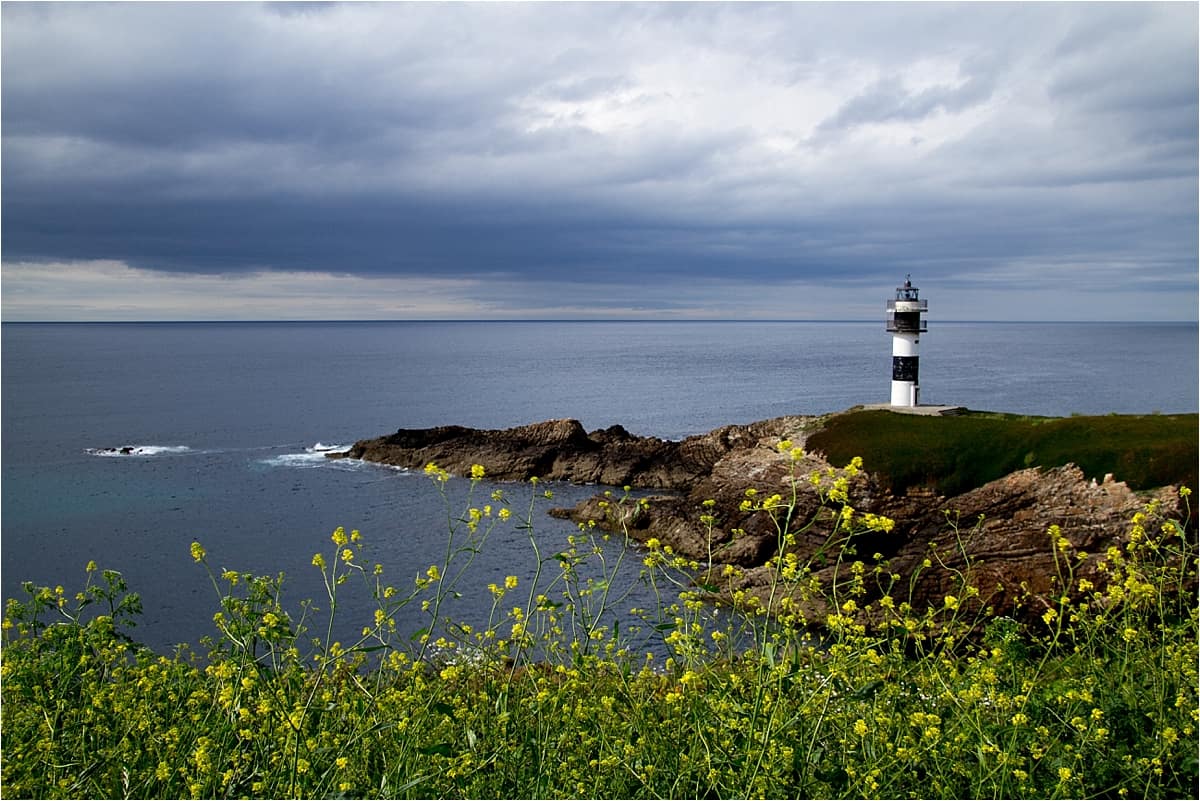
Faro de Cabo Ortegal Lighthouse
Isolated and exposed, the Faro de Cabo Ortegal Lighthouse further cements the position of Galicia as a land dominated by the sea. Built in 1984, it’s squat red and white silhouette isn’t the main draw. But the views of the swirling surf and screeching wind make this place seem otherworldly.
Parking is easy and windy paths run along the top.
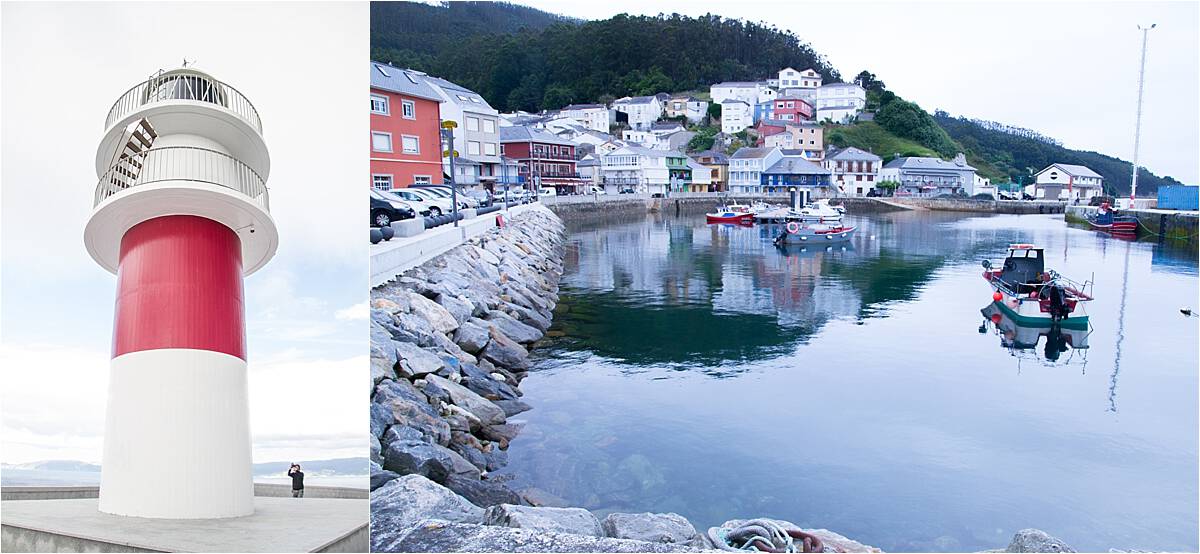
Galicia Road Trip Itinerary: Day Three
Porto do barqueiro.
Fresh from a Norwegian fjord, the small fishing village of Porto do Barqueiro mixes pretty colourful houses with rough and ready fishing equipment.
In ordinary times, Viveiro would seem like a small town. But after snaking through the hamlets and fishing villages of northern Galicia, Viveiro starts to feel huge.
Its city wall gate imposes and the stone-covered streets and stony buildings loom large. It’s good for a walk around, a mid morning churros and any shopping you may want to do.
If you’ve a taste for monuments, look for Iglesia Santa María do Campo, the oldest church in Viveiro with stone brickwork dating back to the 12th century.
Also, consider the Capilla de San Roque church and enjoy the view of the Río Landro and the ocean just outside the Old Town.
Faro de Punta Roncadoira Lighthouse
Drive further onto the rocky cliffs as this Galicia road trip itinerary returns to the sea. Built in 1984 and standing 80 metres tall, the Faro de Punta Roncadoira Lighthouse brushes away any cobwebs from the night before.

Fabrica de Ceramica de Sargadelos
By now, you’ve probably noticed the striking blue and white ceramics at tapas bars, taveranas and homes. They come from Sargadelos, a 19th century company from Galicia. You can visit their showroom and glimpse their historic factory.
Lunch at Home
Casa do Mudo is a restaurant and hotel set in an old farm house with granite walls and original wooden beams. They serve homemade traditional food in enormous portions, exceeded only by the warmth and friendliness of the owners.
Praia das Catedrais
Praia das Catedrais is known to locals as Cathedral Beach thanks to the astonishing rock formations and caves that appear during low tide. Cathedral-like arches can appear up to 30 metres high and the sight is so popular that entrance tickets are now required. Buy your Praia das Catedrais ticket here.
Faro de Illa Pancha Island and Lighthouse
Add this place to your lighthouse list on account of its staggering 360 degree views of the Cantabrian Sea.
Where to Sleep: Parador de Ribadeo
Make the most of the great Spanish tradition of converting historical buildings into accessible hotels by spending a night at the Parador de Ribadeo.
It overlooks the estuary with spacious, unpretentious rooms and serves up a good, Galician breakfast.
Ribadeo itself is a moderately lively port with a scattering of cafes and bars. Dine at Restaurant San Miguel on the marina for great service and a view of the bridge and estuary.
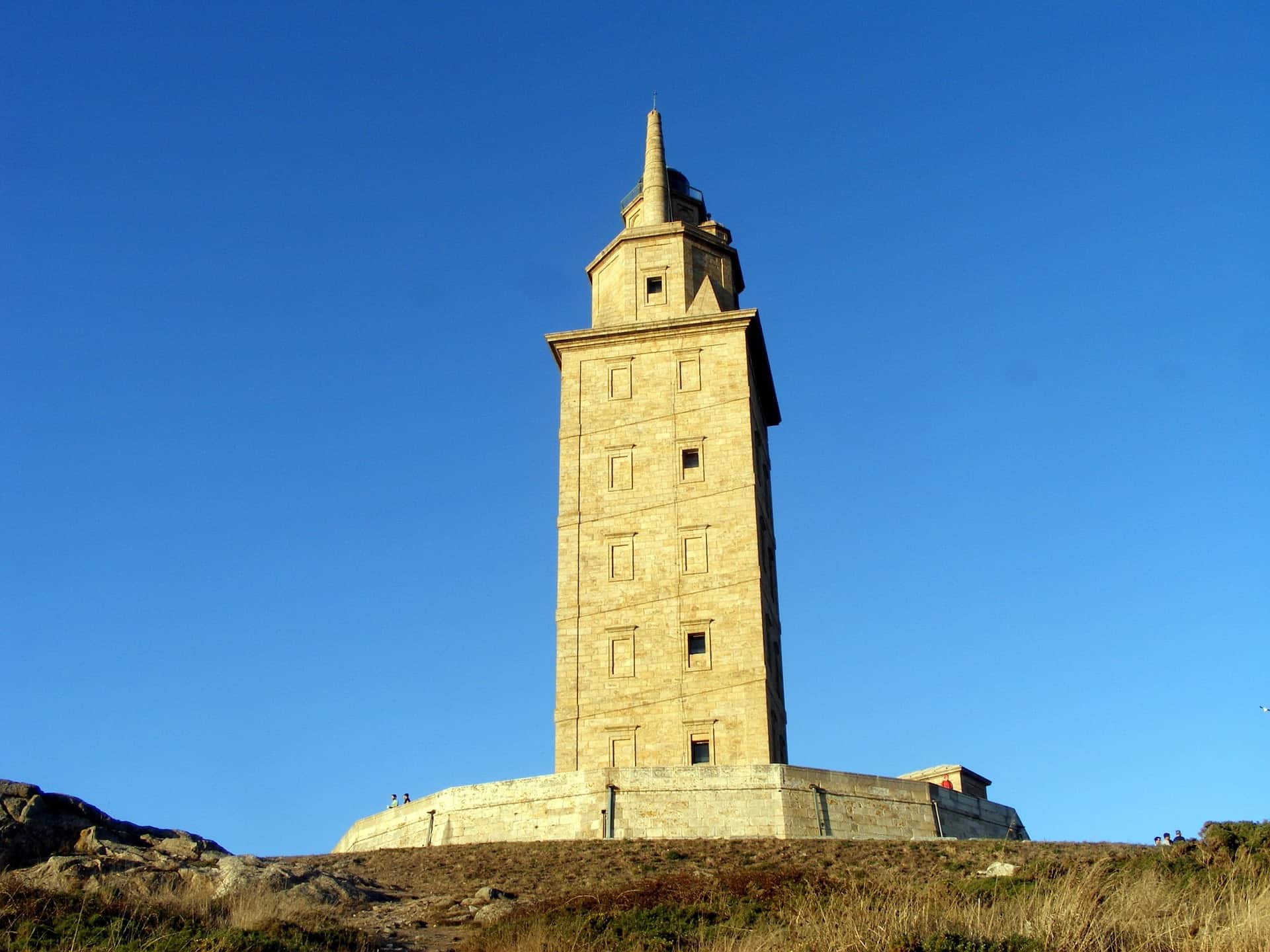
Galicia Road Trip Itinerary: Day Four
Take the time, if you can, to spend time in the narrow streets of salty, no nonsense La Coruña before heading back to the airport.
But if you don’t have time to laze around before catching your flight back home, be sure to visit the l ighthouse of Galicia. The one, the only, the oldest functioning lighthouse in the world…
The Torre de Hércules Lighthouse
The “Tower of Hercules” lighthouse is the oldest Roman lighthouse still in use. It is incredible to think of people laying the stones for this concept over 2000 years ago and seeing the same view of the La Coruña harbour, coastline and city.
It costs only 3 euro to climb to the top and as befits a UNESCO World Heritage Site, it has an informative and immersive education centre underground.
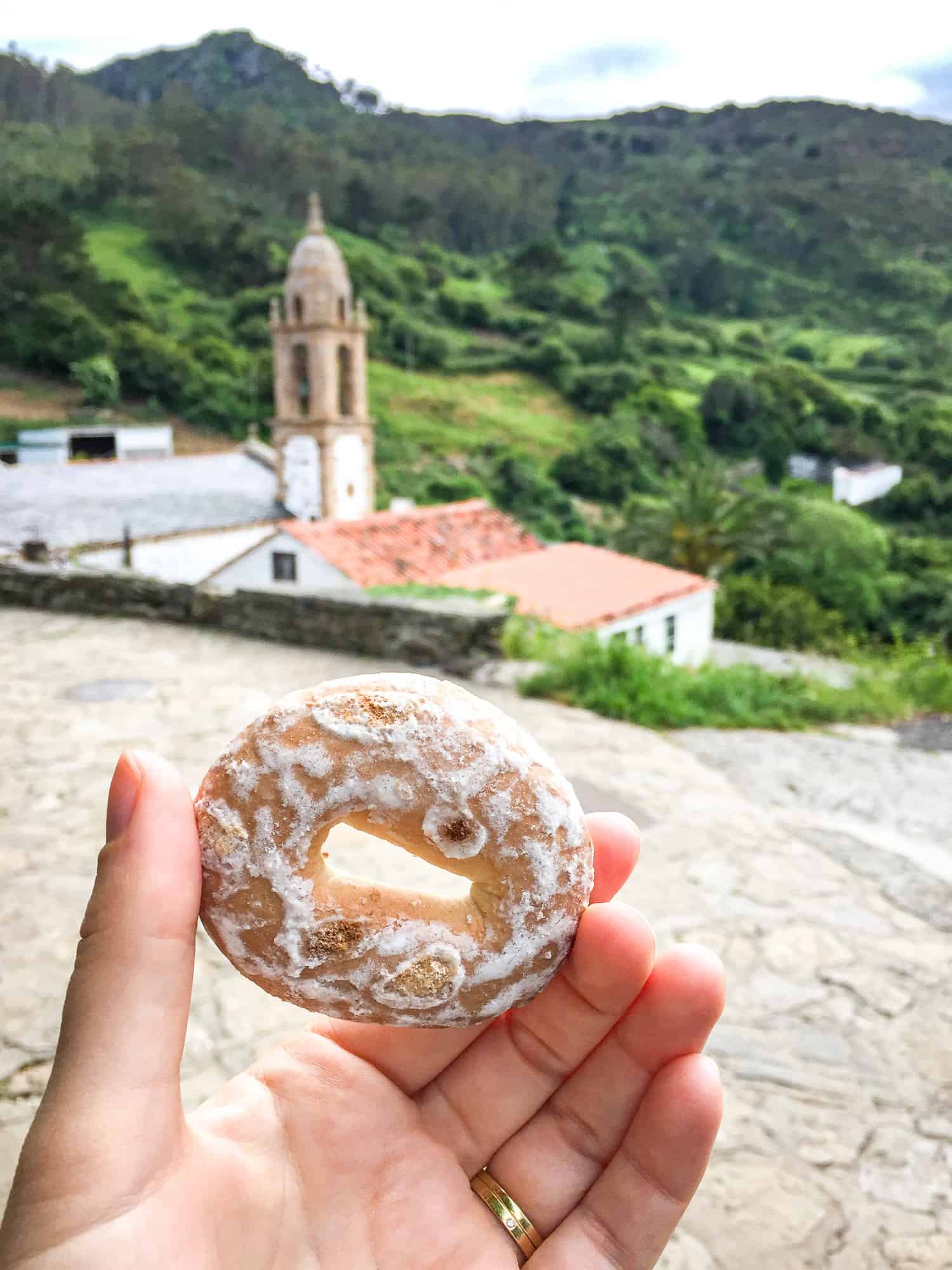
More About Galicia
Galicia’s curious geography.
Galicia’s distinctive landscape, a mix of lakes, valleys, soft-sand beaches and ferocious, raging-black cliffs, results from a blip in geography.
Like most places, valleys developed as the rivers ran into the sea. Years ago, when the sea levels rose, cutting off Britain, the coastline of Galicia flooded. The sea flowed inland across the rivers, creating marshy, wide rias you can still see today.
It’s these rias that explain the extended, Loch Ness monster-like bridges.
And it’s these rias that explain the high quality, ubiquitous seafood.
Galician Lighthouses
It’s Galicia’s coastline that creates its lighthouse trail: from black and white and candy-striped red right to the oldest functioning lighthouse in the world, the UNESCO World Heritage Site Roman lighthouse in La Coruña.
In short, and much as I hate the overused term, a road trip along Galicia’s coastline provides a real taste of the real Spain. And yes, everything we experience is real, no matter where we are.
But. Well. You know what I mean…
A Special Place to Stay in Galicia
The name El Castaño Dormilón means sleeping chestnut, a term referring to the local saying and also the heavy presence of wood in this restored place of childhood learning.
Inside this former village school, the rooms were awash with white and light. My suite at the top of the house bore skylights that seemed to reach and kiss the trees.
It’s a rare place that can successfully marry minimalist chic with gnarly wooden beams, but owners Mónica and Alex pull it off and with aplomb.
They’re friendly and welcoming, yet know when to step back and allow their guests some privacy.
Mónica used to work in the arts magazine trade in Barcelona, on the other side of the coast, perhaps explaining her eye for artistic detail. A bold splash of colour here, a scroll of poetry there.
Rooms have different themes and colours, although all look as though they belong. The white suite on the top floor has a dressing area, desk and free wifi, jacuzzi jet bathroom with transparent walls to the rest of the room. Beyond the skylights, normal windows open up into the trees, creating the idea, I’m sure, that this is a luxury treehouse for grown-ups.
A Smegg kettle and teacups provide a morning pick-up before taking the lift downstairs.
The open spaces downstairs seem designed for reading, eating, or quiet contemplation.
Mónica and Alex serve up traditional Galician seafood: crusty bread and lemon-zested shellfish.
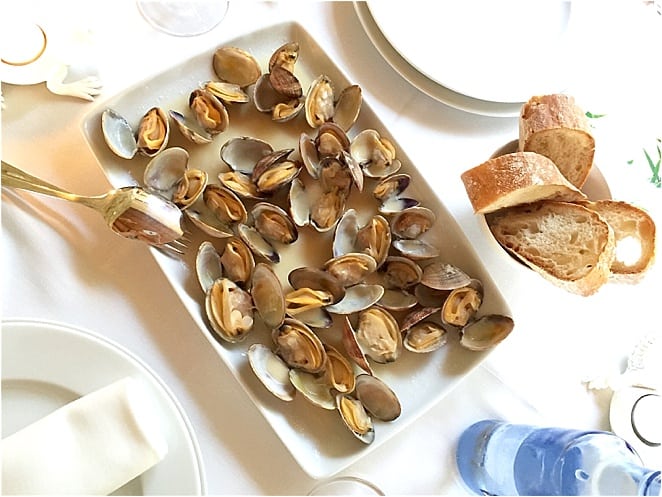
What I Loved about El Castaño Dormilón
- The cool blend of chic white and renovated wood.
- The trees in the skylight.
- The small, artistic touches throughout.
- The caring consideration of dietary restrictions.
- Comfy bed. Very.
- Hassle-free fast wifi
- Great service: friendly but not intrusive
- Disabled access
- The approach to renewable energy
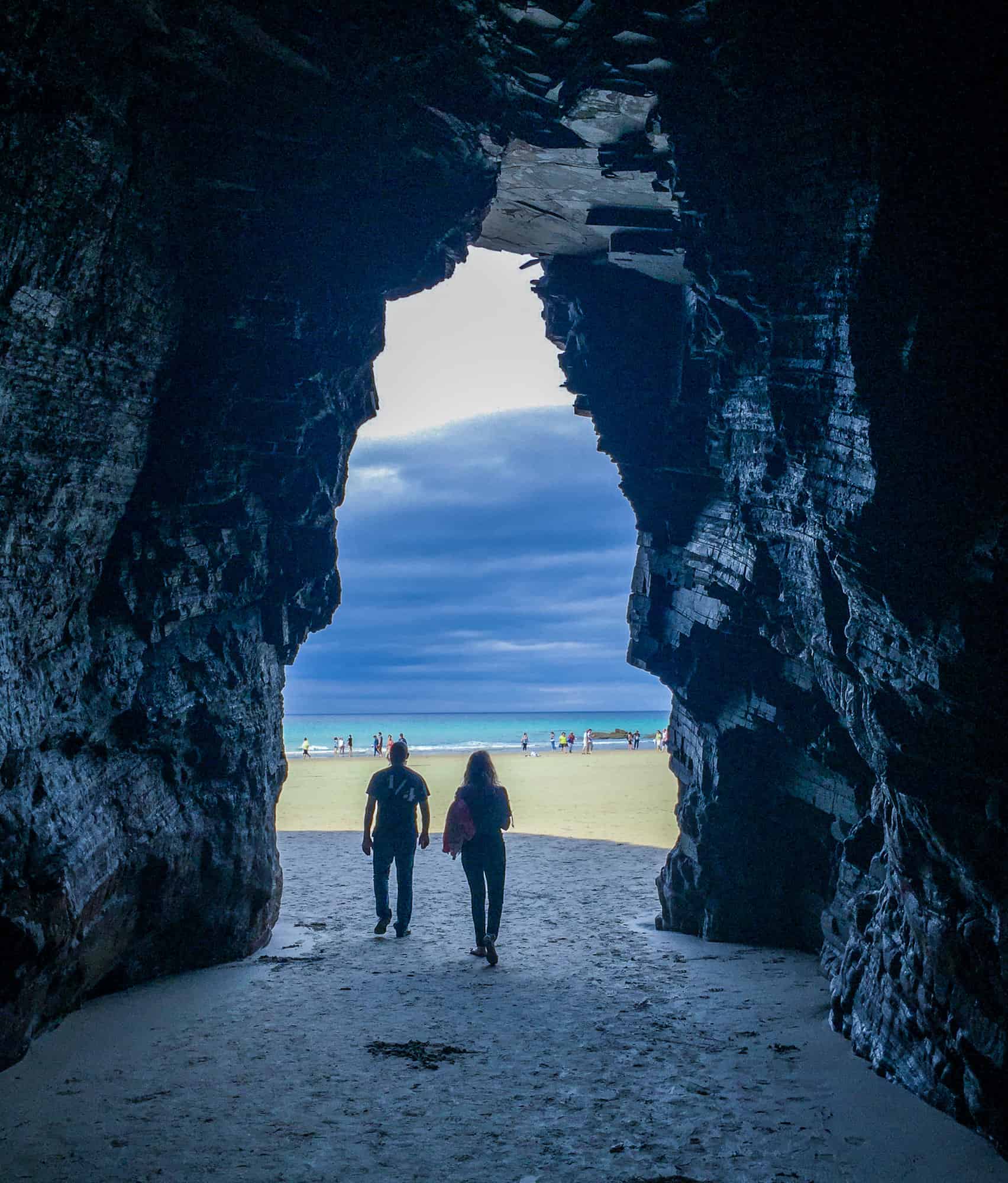
Practical Details for Your Galicia Itinerary
Make sure your Galicia itinerary runs smoothly with the following tips and suggestions:
When to Visit Galicia
Spain may have a reputation for sunny good weather, but the northwest coast where Galicia lies is green for a reason. Rain and wind blow through here as they do in Ireland, making it beautiful but not always suitable for a laze on the beach kind of adventure.
Any time between May to October should be pleasant enough, though.
Is Galicia Safe?
Absolutely. Galicia is one of the safest regions in the world.

What to Pack for Galicia
- Beachwear with warmth – think wetsuits for surfing, not just bikinis and board shorts.
- Pack a two-pronged EU adapter.
- It’s always wise to pack both waterproofs and sunglasses and sunscreen.
- Check out our ultimate packing list here.
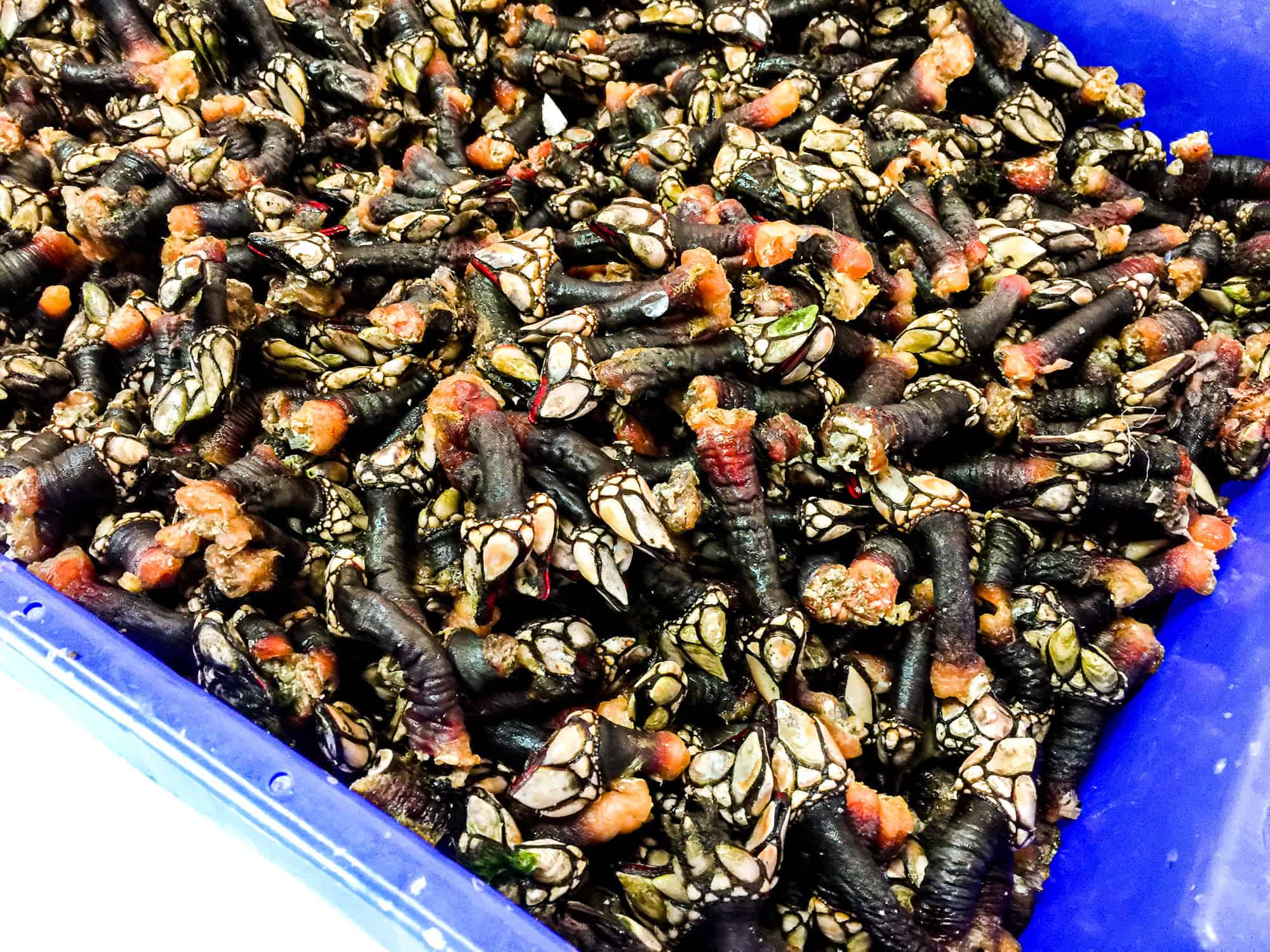
Is Galicia Worth Visiting?
Galicia represents a corner of Spain that most visitors miss. It is deep, deep green with rocky coastlines and centuries of traditions and pilgrimages. In short, Galicia is definitely worth visiting!
Disclosure: I travelled to Galicia, Spain as part of a project between Captivate and the Spanish Tourist Board. As ever, as always I kept the right to write what I like. Otherwise I lose the will to even enjoy my churros. Life is just too short. If you book our buy through these links, I may earn a small commission at no extra cost to you. Thanks!
More on Travel in Spain
- The Spain quiz for curious people
- 49 Interesting facts about Spain
- Spain in one week: an itinerary for your first time in Spain
- How to plan a road trip through Andalucia
- The best road trips in Spain
4 thoughts on “Your Galicia Road Trip Itinerary: Why You’ll Love Spain’s Rugged and Wild Coast”
I’m grateful you tracked down those churros so easily :)
I am nothing if not dedicated to my craft…!
Lovely read as always :) the food looked gorgeous and Spain as always never disappoints.
Ah, thank you! Yes, you can’t go wrong with churros…and the seafood was quite the exploration!
Comments are closed.
Travel Safe
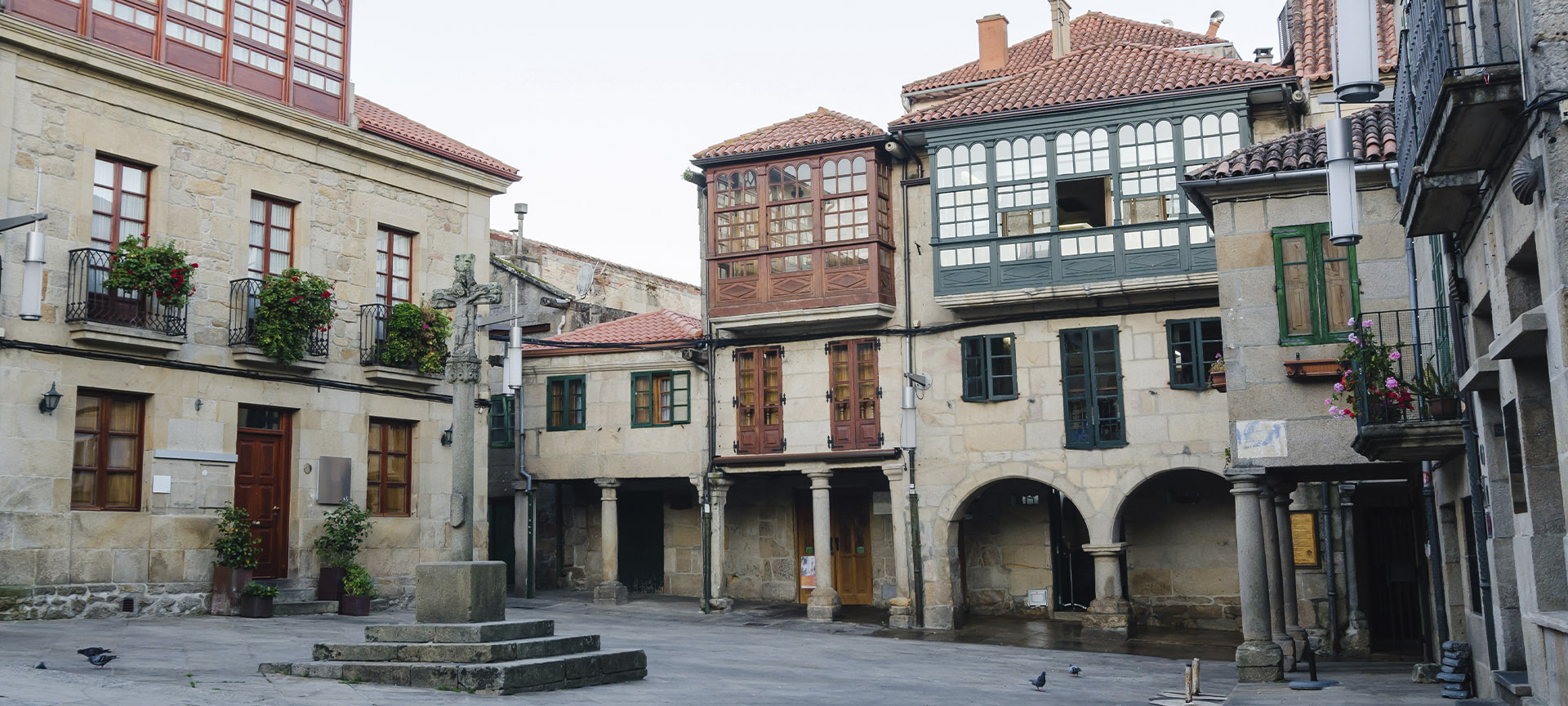
Pontevedra, a city with a long maritime and trading tradition, boasts one of the largest and most elegant historic quarters in the whole of Galicia. Situated on the edge of the estuary of the same name, the old town extends in a network of streets and squares and contains major civic and religious buildings.
Called Ad Duos Pontes by the Romans, Pontevedra has over the centuries adopted a character profoundly marked by the sea, as demonstrated by the shipyards, fishing port and the city's intense commercial actvitity.
The original settlement emerged at the confluence of the river Lérez and the Pontevedra estuary as a walled enclosure of cobbled streets and small secluded squares, some of them arcaded. Situated at the centre of the historic quarter is the Plaza de España and the City Hall , an eclectic building constructed in the 19 th century. Its main façade is defined by four pairs of columns and the frontons above the doors, as well as the balcony and the clock. Extending opposite this building is the so-called Alameda, a wide avenue lined by grand civic buildings such as the Diputación (provincial government), the 19 th -century façade of which contrasts with the medieval ruins of the convent of Santo Domingo . This 14 th -century complex has National Monument status. One of the sites of the Provincial Museum, this enclave houses architectural elements of various origins, such as Romanesque and Gothic capitals, gravestones and sarcophagi. Another place of interest in the old Pontevedra is the so-called Sanctuary of the Pilgrim (18 th century), which preserves the image of the city's patron saint. The work of the Portuguese architect Antonio Souto, it has an almost circular ground plan and a Baroque façade with several 18 th -century Neoclassical additions. Situated opposite this church is the traditional Plaza de la Ferrería , which is surrounded by important buildings such as the church and convent of San Francisco , constructed in the late pointed style between the 14 th and 15 th centuries. Based on a Latin-cross ground plan with a sanctuary and three apses, it contains several medieval sarcophagi. The Provincial Museum of Pontevedra , one of the largest in Galicia, merits special consideration. Its collection is distributed amongst the ruins of St Dominic and another four buildings overlooking the Plaza de la Leña. The main exhibits are the large collection of medieval art and Spanish and European paintings from the 16 th to the 18 th centuries, and a selection of works of popular art by Galician artists. A tour of Pontevedra takes in typical shopping streets named after specific guilds and granite squares such as the Plaza del Teucro, Plaza de Cinco Calles and the Plaza de la Verdura, finally arriving at the basilica of Santa María . Constructed during the 16 th century by the guild of sailors, this grand Renaissance church displays great sophistication in its forms. Hence, the interior of the building boasts a nave and two lateral aisles covered by rib-vaults and a series of lateral chapels. The outstanding feature of the exterior is the main façade, the work of Cornelis de Holanda and Juan Nobre. All of this combines to produce one of the jewels of Galician art. Gastronomy and the Outskirts The deeply-rooted maritime tradition of Pontevedra and the nearby ports has resulted in a type of cuisine largely based on fresh fish and seafood. Typical dishes include oysters and mussels , as well as cockle and sardine pies . Another option is to try the excellent fresh-water fish, the best of which are the trout, salmon and, especially, the lamprey . Wines with the Rías Baixas Label Guarantee make an excellent accompaniment to any of these dishes. The province of Pontevedra contains two of Galicia's most important protected spaces. One of the finest is the National Park of the Atlantic Islands , which encompasses the Cíes Isles, as well as the isles of Ons, Cortegada and Sálvora. Fringed by sheer cliffs and sandy beaches, their coasts are the home of thousands of migratory birds. The wealth not only of the wildlife and flora but also of the sea bottom constitutes an ecosystem of inestimable ecological merit. The Nature Reserve of Monte Aloia in the Serra do Galiñeiro mountain range boasts archaeological remains of great merit, whilst its highest point affords spectacular views over the Miño valley. The Pontevedra coastline is formed by the Rías Baixas , which are dotted with picturesque fishing villages and highly attractive towns such as Sanxenxo , Vilagarcía de Arousa, O Grove and the island of A Toxa. Pontevedra and its province offer a wide range of hotel accommodation. Situated inside the historic quarter of the city is the 16 th -century "Casa do Barón" a "pazo" , or Galician country house, now functioning as a parador. Opposite the Arousa estuary, at the heart of the Rías Baixas, is the Parador de Cambados , housed in the old "Pazo de Batán Barón" (17 th century). One of the finest in terms of location is the Parador de Baiona , a walled fortress on the Monterreal peninsula. Finally, the Parador de Tui is a reproduction of a traditional Galician "pazo" in this historical town on the Portuguese border. Commencing in Portugal, the Camino del Norte (northern road) of the ruta jacobea (pilgrim's route to Santiago de Compostela) enters Spain via Tui and crosses the province of Pontevedra from south to north until it reaches Santiago de Compostela .
What to visit
Select from the list or hover over the map to find out about points of interest.
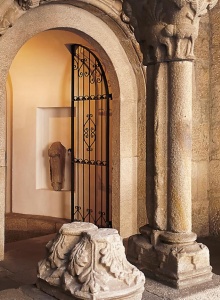
Pontevedra Museum
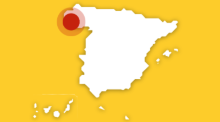
Ruins of the Santo Domingo Monastery
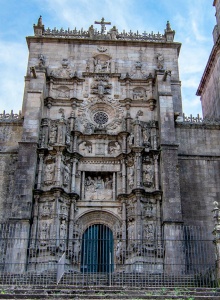
Santa María la Mayor Basilica
Church of La Peregrina
Church of San Francisco (Pontevedra)
Travel plans for inspiring you
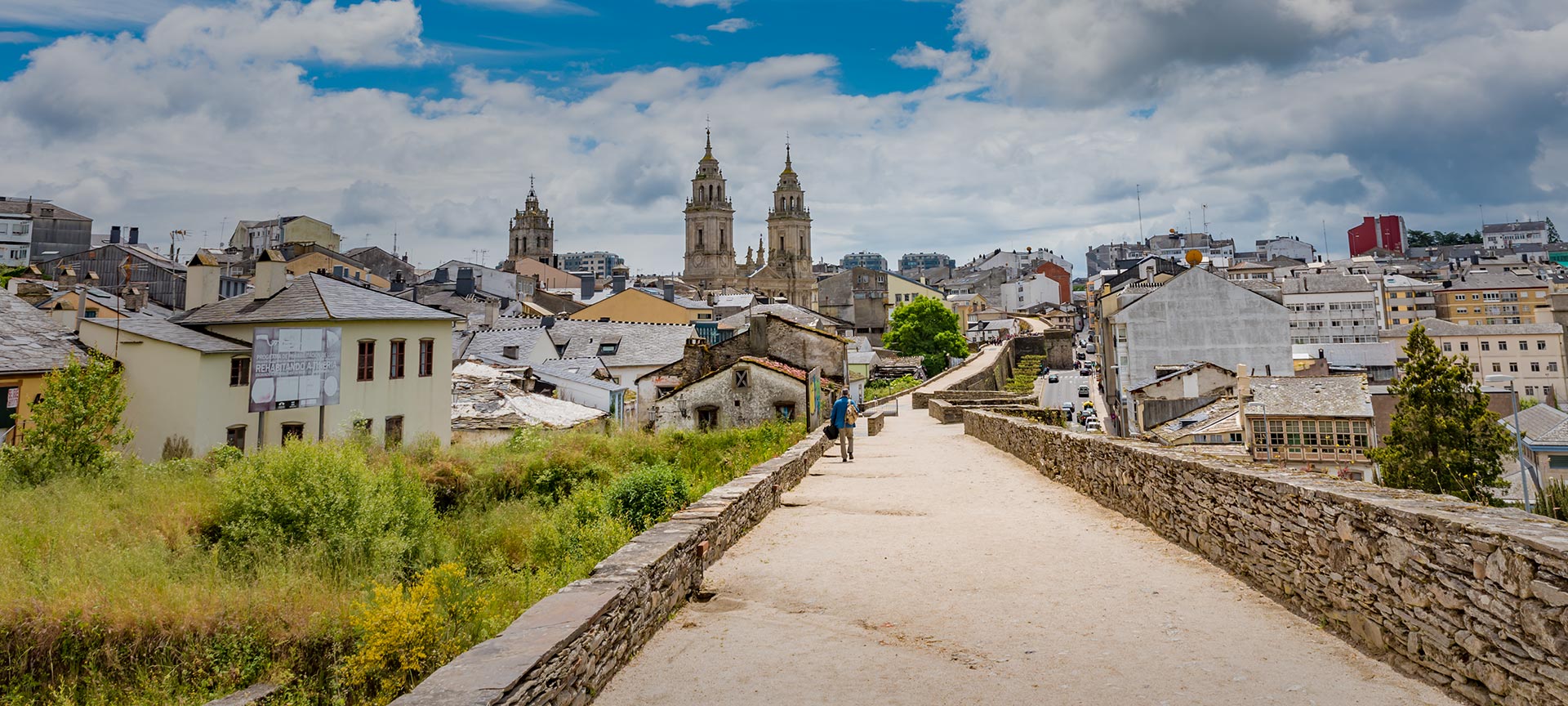
Five must-sees in the urban side of Galicia
Shows, festivals, sports...
View some of the most relevant events you will be able to enjoy at the destination.

International Jazz and Blues Festival of Pontevedra
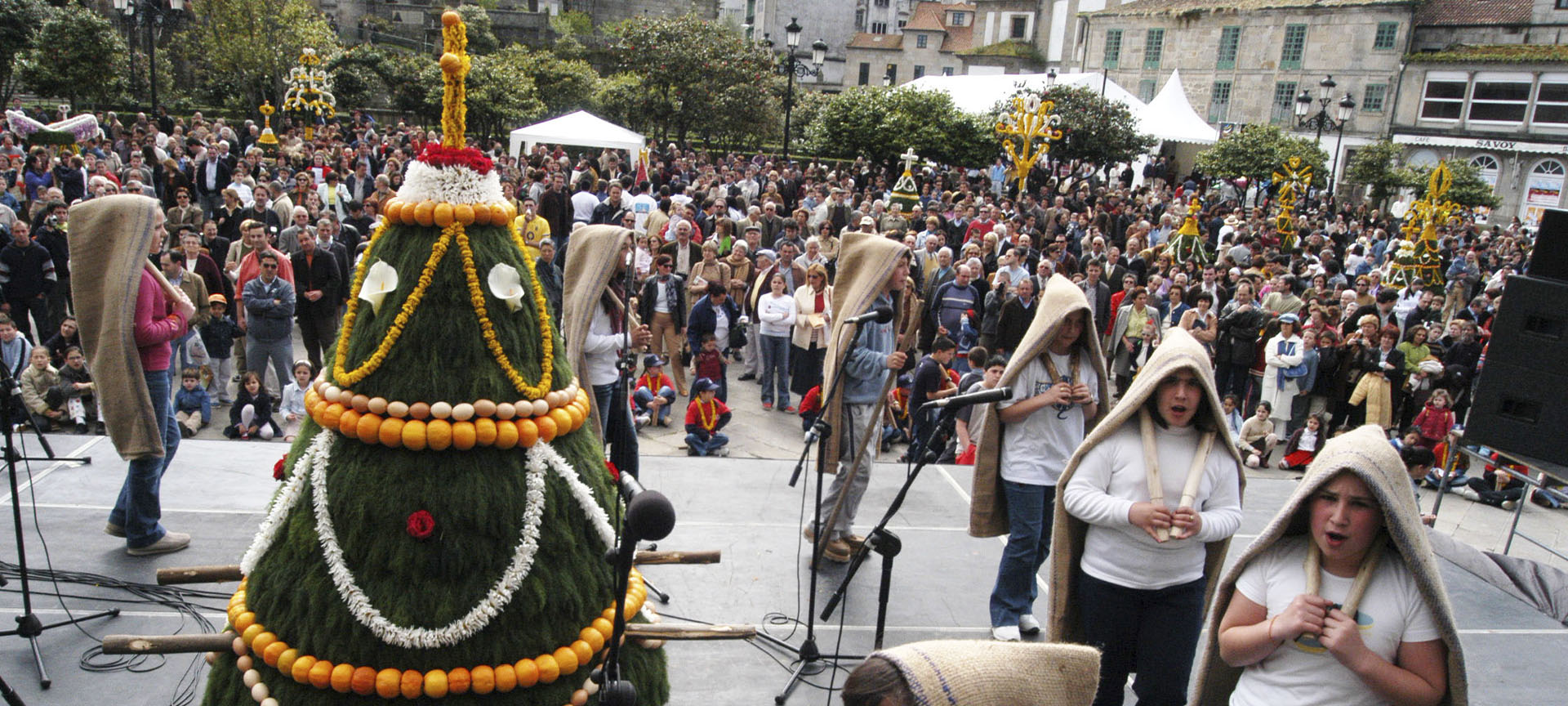
Pontevedra Maios Fiesta

Choose between thousands of activities to live your best life on holiday.

- 10 Things To Know Before...
10 Things to Know Before Visiting Galicia

The region of Galicia lies in the northwestern corner of Spain, above Portugal. It’s characterised by rugged coastlines, historic cities and rolling green scenery. Here are our 10 things to know before visiting Galicia.
They have their own language.
Galicians speak Spanish, but they have their own language too – Gallego. Gallego is like a cross between Portuguese and Spanish, and you will see signs written in Gallego all over the region. To find out more about Gallego – read our article about it here .
It’s home to the end of the Camino de Santiago
Galicia is the end of the celebrated pilgrimage route, which crosses the whole of Spain and winds its way through Navarra, La Rioja, Castilla y Leon, and finally Galicia. The end point is of course the cathedral in the city of Santiago de Compostela.

They have a connection to Celtic culture
There is evidence to suggest that Galicians have somewhat of a connection to the Celts in Ireland and Scotland and the like, so don’t be surprised if you see instruments similar to bagpipes, whistles and souvenirs with Celtic crosses on them.
It’s a great place to learn to love seafood
Being surrounded on two sides by the Atlantic Ocean, Galicia has some of the best seafood in the whole of Spain. This means that it’s a great chance to try some new dishes and learn to love some of the more obscure sea creatures you may not have tried before. Pulpo, or octopus, is of course the most famous, but other things to try here include percebes, or goose barnacles, and angulas, or baby eels.

The weather is not always great here
Yes Galicia may be in Spain, but that doesn’t mean that you’re guaranteed hot and sunny weather. Galicia is known for its cool and rainy days, even in summer, so be prepared and bring a rain jacket and umbrella – as well as your bathing suit.
It’s home to beautiful wild beaches
Galicia may not be as popular for a beach holiday as Spain’s Costa del Sol, Costa Dorado or the Costa Brava, but it’s actually home to many spectacular beaches . One of the best beaches to visit is Praia das Catedrais, named ‘Cathedral’s Beach’ because of its towering rock formations.

Become a Culture Tripper!
Sign up to our newsletter to save up to $1,656 on our unique trips..
See privacy policy .

A Coruña or Santiago de Compostela make for the best bases
The larger Galician cities of Santiago de Compostela in the centre and A Coruña in the northwest make for great bases to explore the rest of the region. Santiago de Compostela is the famous end of the Camino de Santiago pilgrimage route and is filled with historic architecture and fascinating museums, while Coruña lies on the coast, within reach of many of the area’s best beaches.
People once believed this was the end of the Earth
It was once believed that Galicia was where the Earth ended. This place was the westernmost point in the region, jutting out into the Atlantic Ocean. It was given the name Cape Finisterre – literally ‘end of the Earth’ – and is located on the Galician Costa da Morte, or the ‘Coast of Death’. Many people choose to continue the Camino de Santiago to this point.

It produces some excellent wines
Galicia is actually one of Spain’s best wine-producing regions, making some top quality white wines. The best areas to visit for wine here include the Rías Baixas, Ribeira Sacra, D.O. Monterrei and O Ribeiro. Read our article on ‘ The Ultimate Tour of Galicia’s Best Wine Routes ‘ to learn more.
It’s packed with vestiges of its Roman past
Galicia is an excellent destination for history lovers, especially those who are interested in the Romans. Some of the highlights include the UNESCO World Heritage Roman Walls of Lugo and the Roman bridge of Ourense and the Tower of Hercules in A Coruña.

Culture Trips launched in 2011 with a simple yet passionate mission: to inspire people to go beyond their boundaries and experience what makes a place, its people and its culture special and meaningful. We are proud that, for more than a decade, millions like you have trusted our award-winning recommendations by people who deeply understand what makes places and communities so special.
Our immersive trips , led by Local Insiders, are once-in-a-lifetime experiences and an invitation to travel the world with like-minded explorers. Our Travel Experts are on hand to help you make perfect memories. All our Trips are suitable for both solo travelers, couples and friends who want to explore the world together.
All our travel guides are curated by the Culture Trip team working in tandem with local experts. From unique experiences to essential tips on how to make the most of your future travels, we’ve got you covered.

Guides & Tips
The best private trips to book for your spanish class.

Top Tips for Travelling in Spain

Reasons Why You Should Visit La Rioja, Spain

Bars & Cafes
The best wine bars in la rioja, spain.

Places to Stay
The best hotels to book in catalonia.

See & Do
Getting a taste of picasso in malaga.

Reasons Why You Should Visit Andalucia, Spain

The Best Private Trips to Book for a Foodie Adventure

The Most Beautiful Train Stations in the World

The Best Places to Travel in June

The Most Unique Temples and Churches in the World

The Best Hotels to Book in Salou, Catalonia
Culture trip spring sale, save up to $1,656 on our unique small-group trips limited spots..

- Post ID: 2156067
- Sponsored? No
- View Payload
Plan Your Trip to Spain: Best of Spain Tourism

Essential Spain
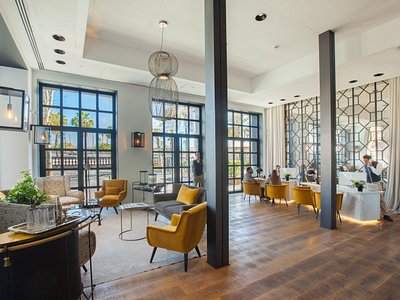
Dig Into Spain
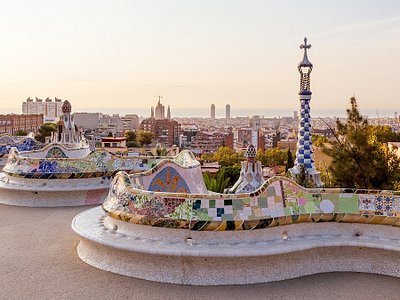
Spain Is Great For
Art & history.

Eat & drink
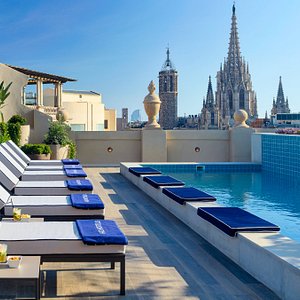
Maps of Spain
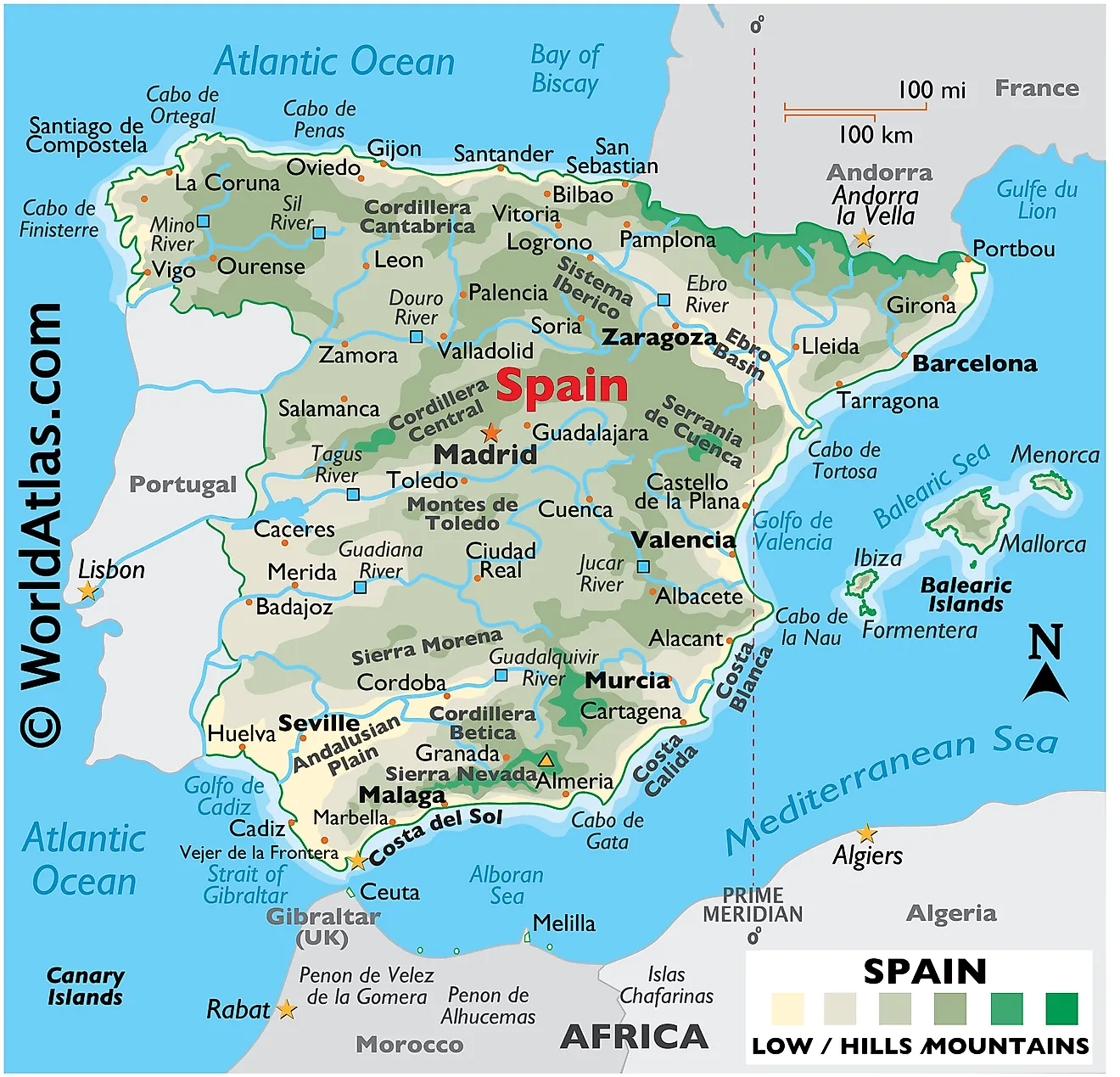
Spain is located in southwestern Europe on the Iberian Peninsula , which it shares with its western neighbor, Portugal . To the north, it borders France and Andorra , with the Pyrenees mountain range acting as a natural boundary. Towards the south, Morroco lies just across the Strait of Gibraltar . The Mediterranean Sea lines its eastern coast, while the Atlantic Ocean lies to the north and west. The total area of Spain is about 505,994 km 2 (195,365 mi 2 ).
Mainland Spain comprises eight geographic regions, but the notable territories of the Balearic and Canary Islands are also significant enough to merit inclusion.
Meseta Central : The Meseta Central is a vast plateau in the heart of Spain. This expansive high plain covers a significant portion of the country's interior and is characterized by its relatively flat terrain interspersed with rolling hills. The Tagus and Duero Rivers cut across this region, providing crucial water sources for agriculture. The altitude of the Meseta Central averages about 660 meters (2,165 feet), giving it a continental climate with hot summers and cold winters.
Cantabrian Mountains (Cordillera Cantabrica) and the Northwest Region : The Cantabrian Mountains extend across northern Spain, running parallel to the Bay of Biscay . These mountains are characterized by their rugged peaks, deep valleys, and dense forests. They act as a climatic barrier, bringing heavy rainfall to the northern coastal regions. The northwest region, including Galicia, benefits from these mountains, which ensures that the surrounding area receives adequate rainfall.
Ibérico Region : The Ibérico region, featuring the Iberian Mountains, is located in northeastern Spain. These mountains, though not as high as the Pyrenees, contain significant mineral deposits, especially in their northern parts. The Ebro River , one of Spain's most important rivers, originates from this region, providing an essential waterway for transportation and irrigation. This region is known for its varying landscapes, from rocky peaks to fertile valleys.
The Pyrenees : The Pyrenees mountain range acts as a natural boundary between Spain and France. Stretching approximately 300 miles (490 kilometers) from the Mediterranean Sea to the Bay of Biscay, these mountains are known for their towering peaks, some reaching over 11,000 feet (3,400 meters). Several major rivers, including the Garonne and the Aude, originate from the Pyrenees.
Penibético Region in the Southeast : The Penibético region encompasses the Baetic Mountain Range in southern Spain. This region features two primary mountain systems: the Sierra Nevada and the Sierra de los Filabres. The Sierra Nevada boasts the highest peak in mainland Spain, Mulhacén , which rises to 3,482 meters (11,424 feet). These mountain ranges are notable for supporting various ecosystems and serving as water catchments.
Andalusian Plain : The Andalusian Plain, situated in southern Spain, is a flat, fertile expanse. The Guadalquivir River , one of the country's major rivers, flows through this plain, making the land especially suitable for agriculture. Historically, this region has been significant for crop production, particularly olives, cereals, and grapes. Its strategic location near the Strait of Gibraltar also makes it a critical economic region.
Ebro Basin : The Ebro Basin is centered around the Ebro River, which flows into the Mediterranean Sea. This basin is one of Spain's primary agricultural regions, producing a variety of crops thanks to its fertile soils. The river and its tributaries have been essential for the development of the region's agriculture and transportation networks. The Ebro Delta, where the river meets the Mediterranean, is of ecological significance, supporting numerous bird species.
Coastal Plains : Spain's coastal plains stretch along both its Mediterranean and Atlantic coastlines. These plains are often narrow, squeezed between the sea and nearby mountain ranges. With mild climates and fertile soils, they support agriculture, particularly citrus fruits, olives, and vineyards. Moreover, large settlements dot these coastal plains, and over time, they have grown into significant centers of trading, political concentration, and social infrastructure.
Balearic Islands : This autonomous community is an archipelago in the Mediterranean Sea, east of the Spanish mainland. Comprising major islands like Mallorca, Menorca, Ibiza, and Formentera, these islands are characterized by their limestone landscapes, fertile plains, and coastal cliffs. They play a significant role in Spain's tourism industry, attracting millions of visitors annually. The surrounding sea also contributes to the islands' mild climate and rich marine biodiversity.
Canary Islands : The Canary Islands are another autonomous archipelago that belongs to Spain, despite being located off the northwest coast of Africa. These volcanic islands, including major ones like Tenerife, Gran Canaria, and Lanzarote, harbor striking landscapes, from black sand beaches to towering volcanoes. Interestingly, Teide Peak of Tenerife is the highest point on Spanish soil, at 3,715 m (12,188 ft). The Canary Islands have a subtropical climate, which has made them a popular tourist destination. The Canary Current, a major ocean current of the North Atlantic, impacts the climate and marine life around these islands.
Bodies of Water : Besides the Atlantic Ocean, the Mediterranean Sea, the Bay of Biscay to the north, and the Alboran Sea, the country has a series of major rivers. The Tagus River originates in Spain and flows into Portugal, making it the longest. The Ebro River runs through the northeast, draining into the Mediterranean, and the Guadalquivir River winds through southern Andalusia, aiding agriculture. Other notable rivers include the Duero and the Júcar, each playing significant geographical roles.
Regarding lakes, Lake Sanabria is the Iberian Peninsula's largest glacial lake. The Albufera Lake, near Valencia , is a shallow lagoon, while the Lakes of Covadonga consist of Lake Enol and Lake Ercina in the Picos de Europa range. Catalonia's Lake Banyoles is another major natural lake. Spain also contains several reservoirs, crucial for water management.
Communities of Spain Map
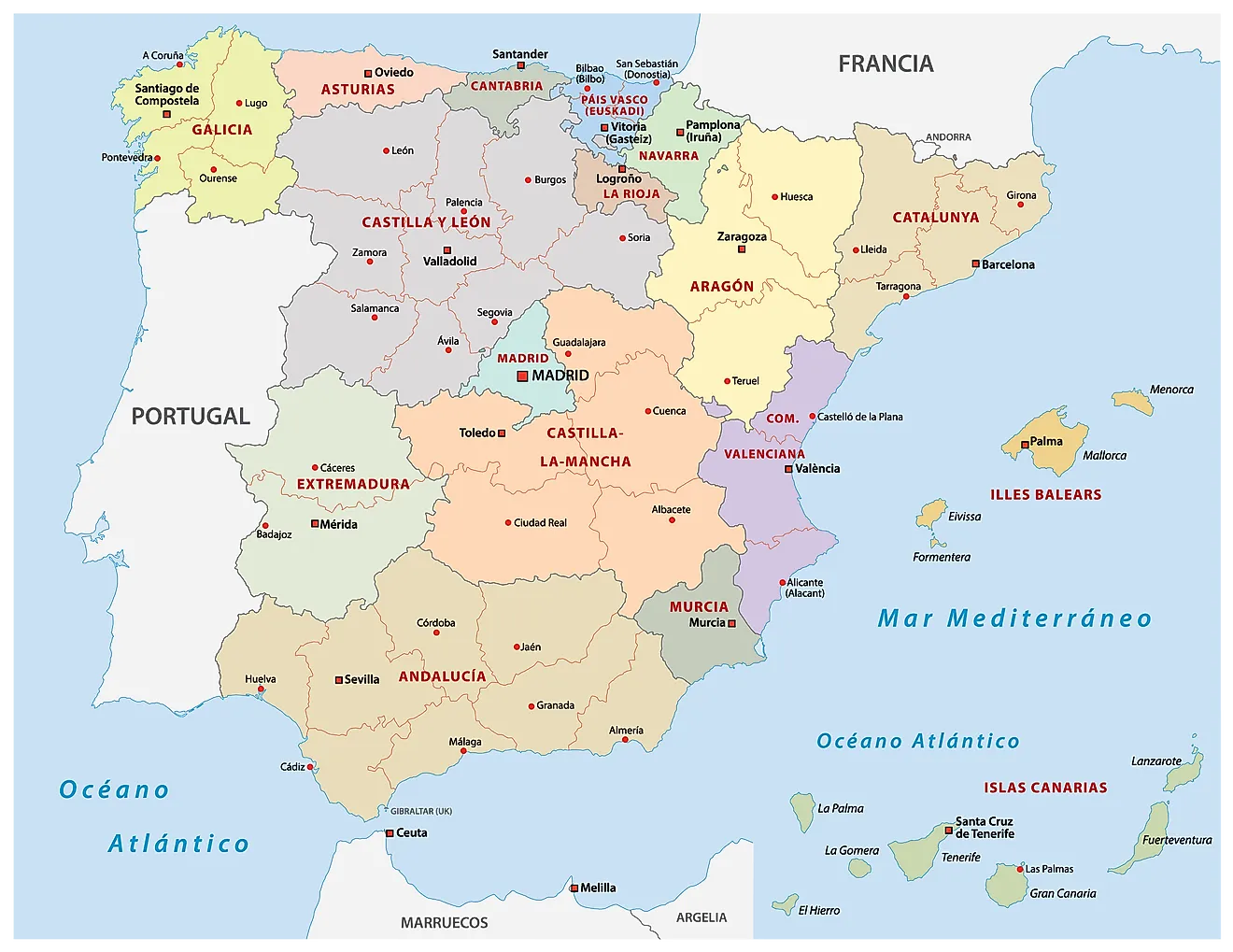
Spain (officially, the Kingdom of Spain) is divided into 17 autonomous communities ( comunidades autonomas , sing. comunidad autonoma ) and 2 autonomous cities ( ciudades autonomas , sing. ciudad autonoma ). The autonomous communities are: Andalusia, Catalonia (Catalan), Madrid, Comunitat Valenciana [Valencian Community], Galicia, Castilla-Leon, Euskadi (Basque) [Basque Country], Castilla-La Mancha, Canarias (Canary Islands), Murcia, Aragon, Extremadura, Illes Baleares (Balearic Islands), Asturias, Navarre (Castilian), Cantabria, and La Rioja. The 2 autonomous cities are: Ceuta and Melilla. The autonomous communities are further subdivided into provinces and smaller subdivisions.
With an area of 505,990 sq. km, Spain is the largest country in Southern Europe and the 4 th largest country in the continent of Europe. It is also the 2 nd largest country in Western Europe and EU. Spain has a population of over 47 million, making it the 6 th most populous country in Europe and the 4 th most populous country in EU. Located in the central part of the country is, Madrid – the capital, the largest and the most populous city of Spain. Madrid is also the cultural, administrative and economic center of Spain. Madrid functions as an important financial hub of Southern Europe.
Where is Spain?
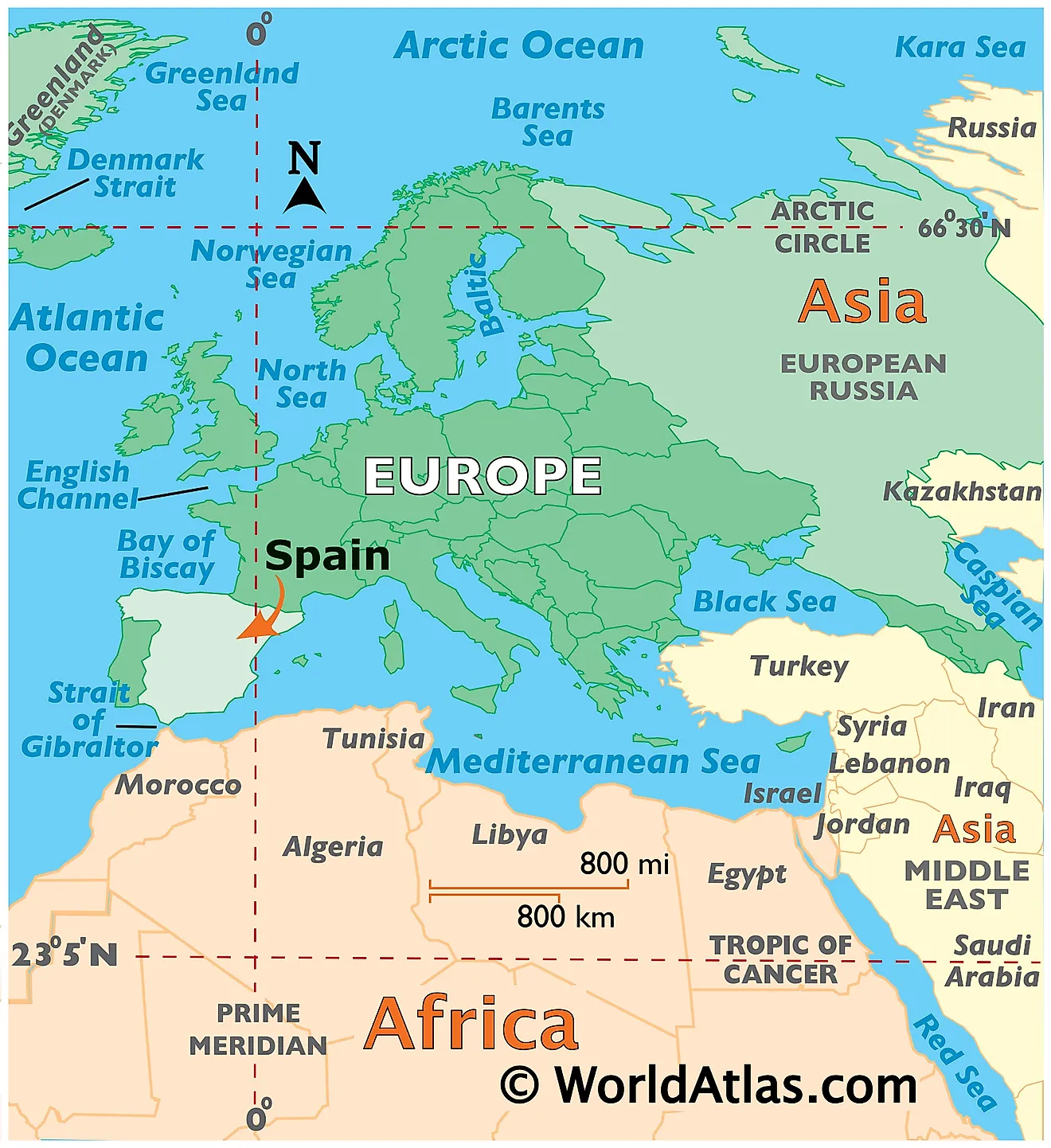
Spain is a country located on the Iberian Peninsula in southwestern Europe. It is situated in both Northern and Eastern hemispheres of the Earth. Spain is bordered by 5 countries: by Portugal in the west, by France and Andorra in the northeast, by Gibraltar and Morocco (the Spanish territories of Ceuta and Melilla in North Africa), in the south. The country is bounded by the Mediterranean Sea in the east and southeast, by the Atlantic Ocean in the northwest and southwest and by the Bay of Biscay in the north. Spain shares its maritime borders with Algeria and Italy.
Spain Bordering Countries : Morocco , Gibraltar , Portugal , Andorra .
Regional Maps : Map of Europe
Outline Map of Spain
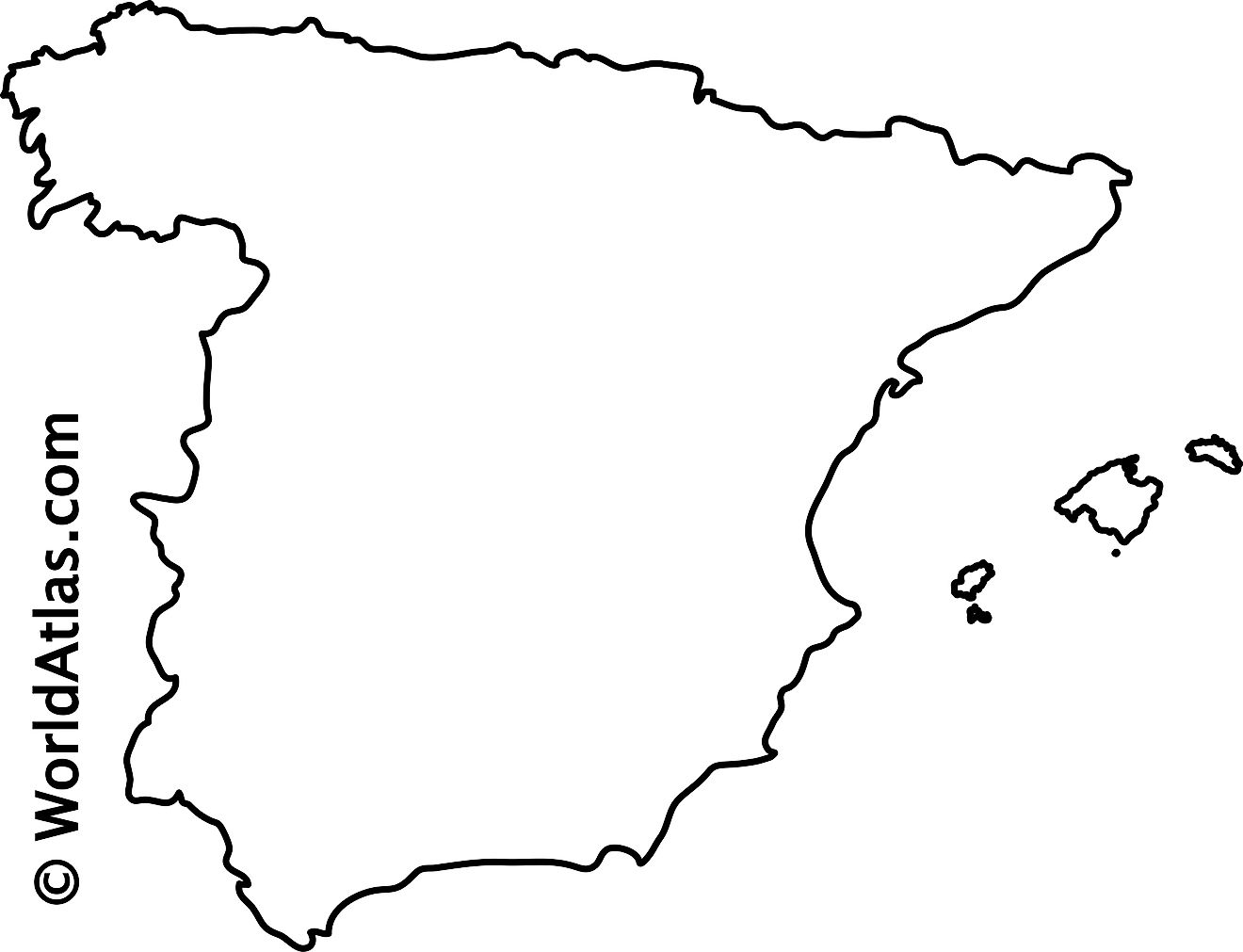
The above blank outline map is of the European country of Spain. The map maybe downloaded and printed to be used for coloring or educational purpose.
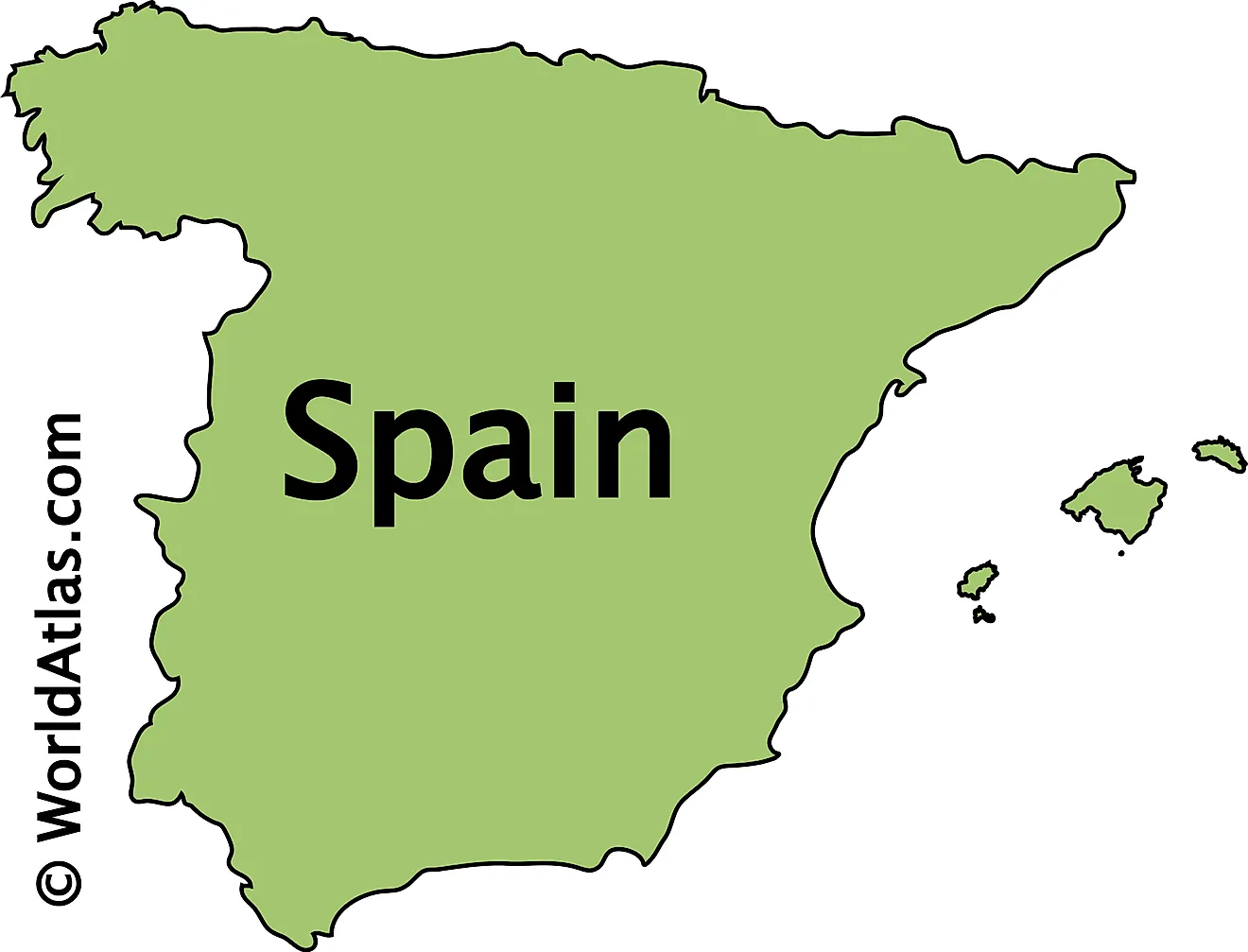
The about map represents Spain, a country in South Western Europe well-known for its unique and vibrant Spanish culture.
This page was last updated on August 18, 2023
Latest by WorldAtlas
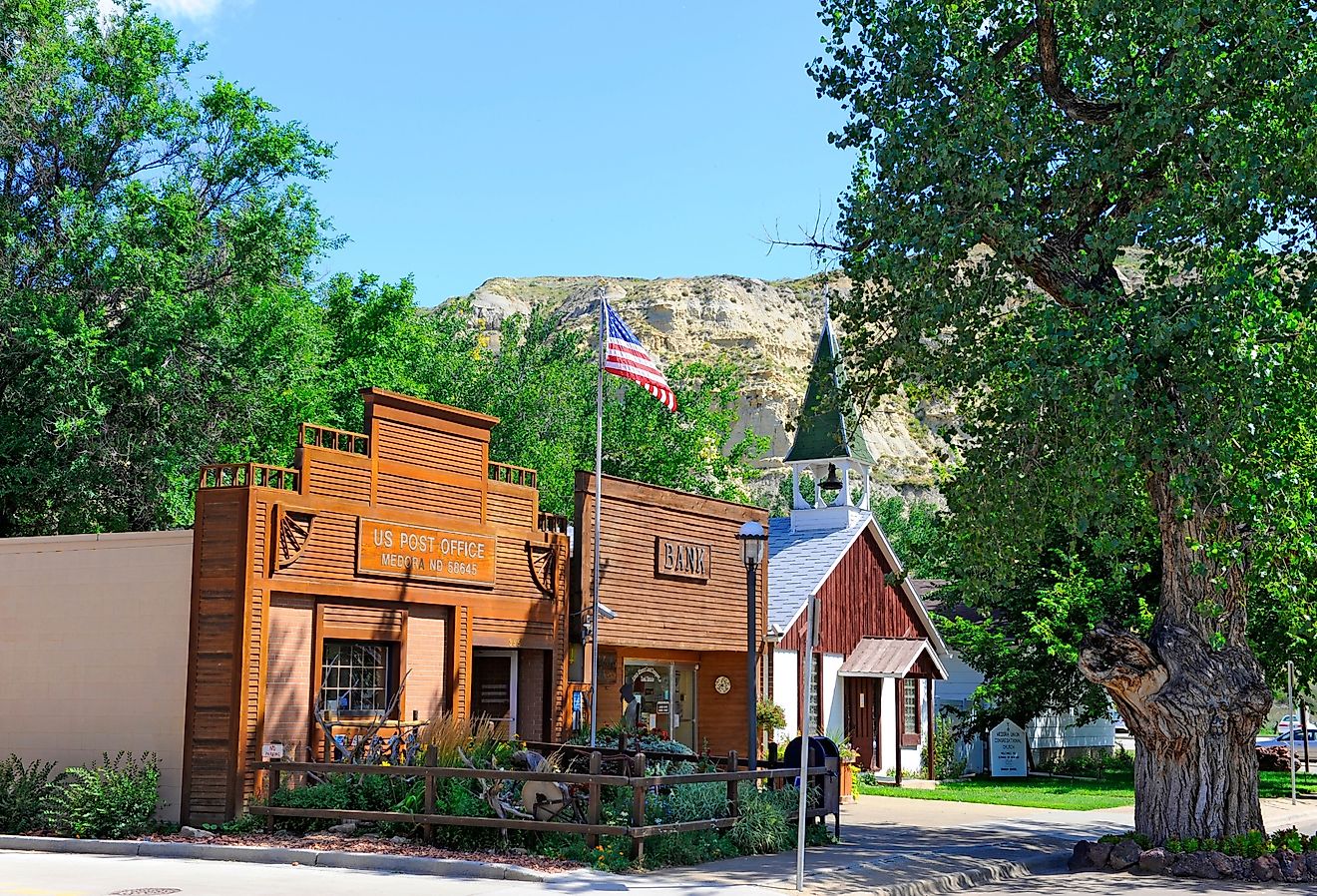
6 Cozy Towns to Visit in North Dakota
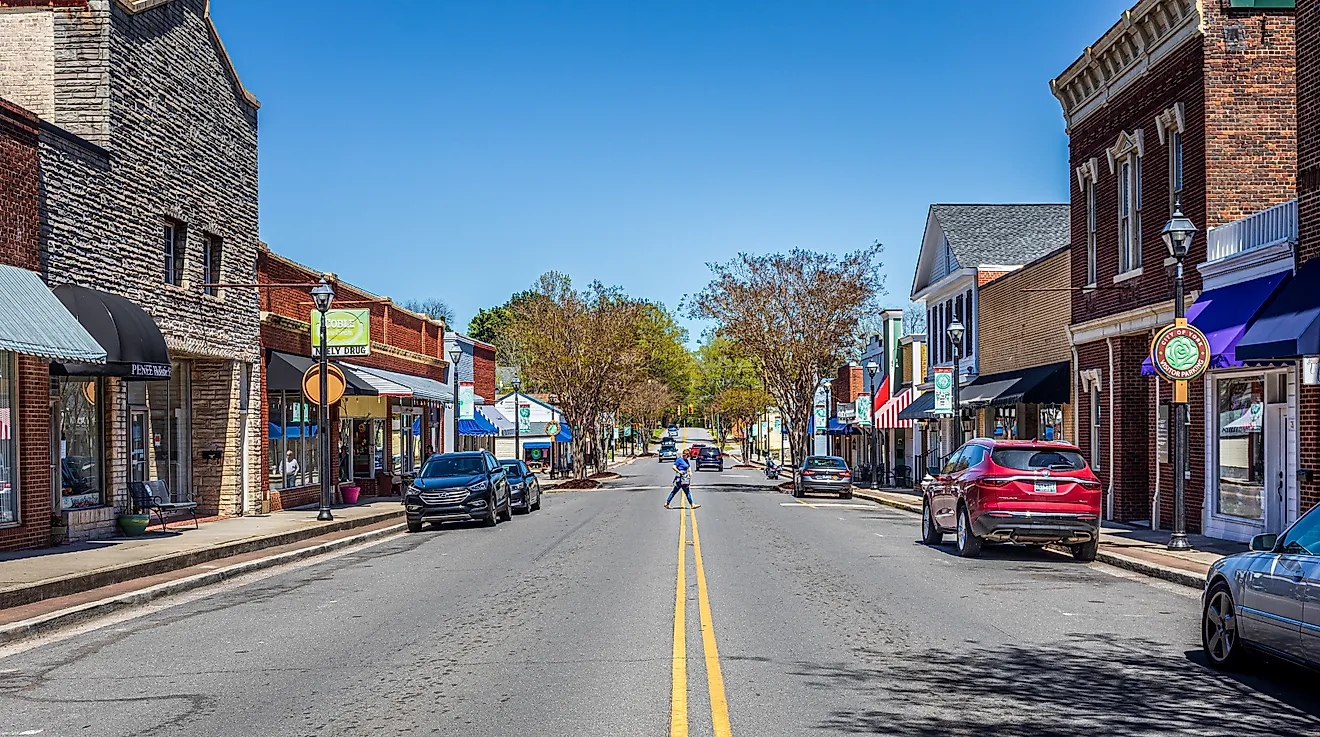
8 Underappreciated Towns To Visit In South Carolina
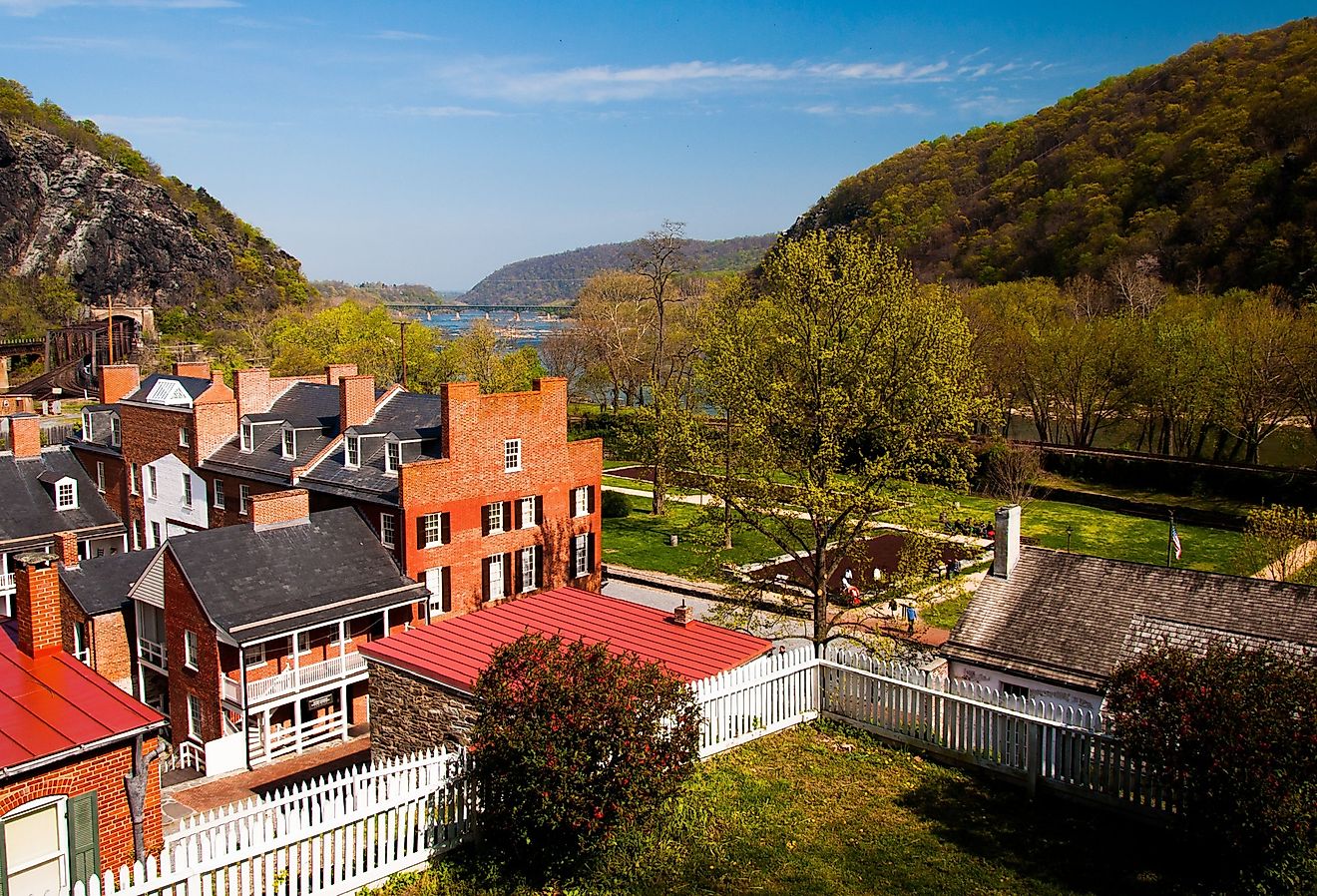
7 Serene Towns in West Virginia for a Weekend Retreat
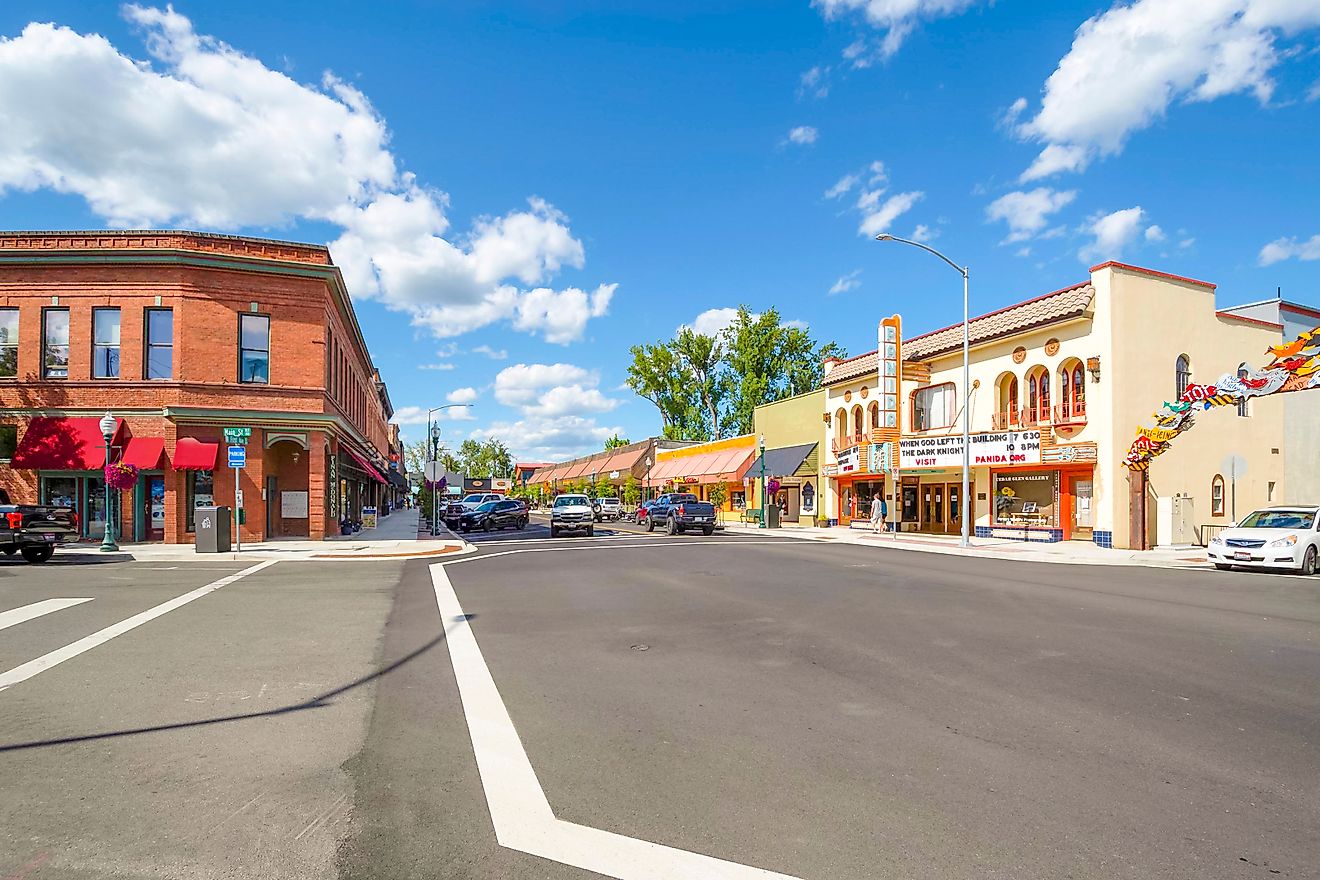
6 Cozy Towns to Visit in Idaho
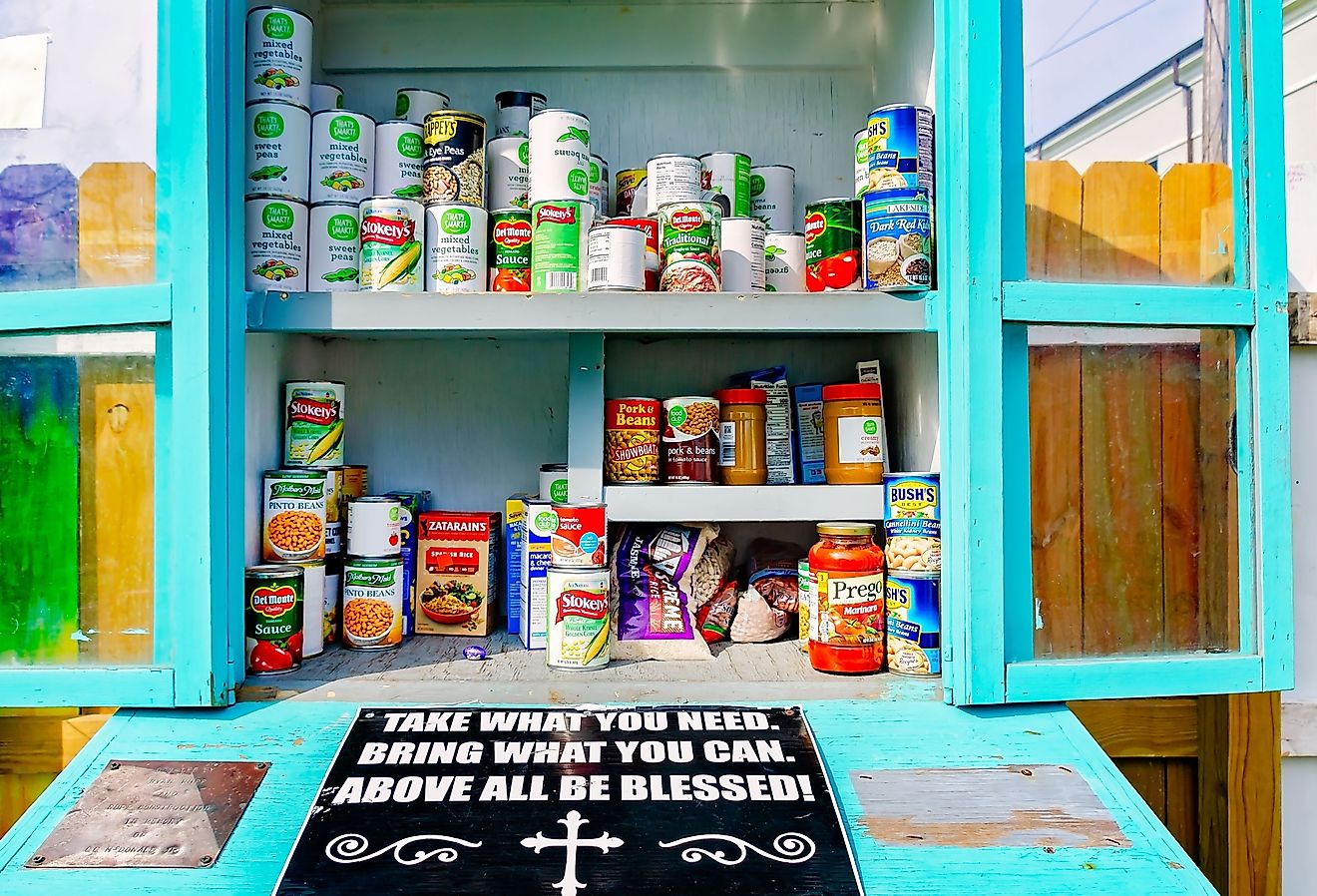
6 Friendliest Towns to Visit in Mississippi in 2024
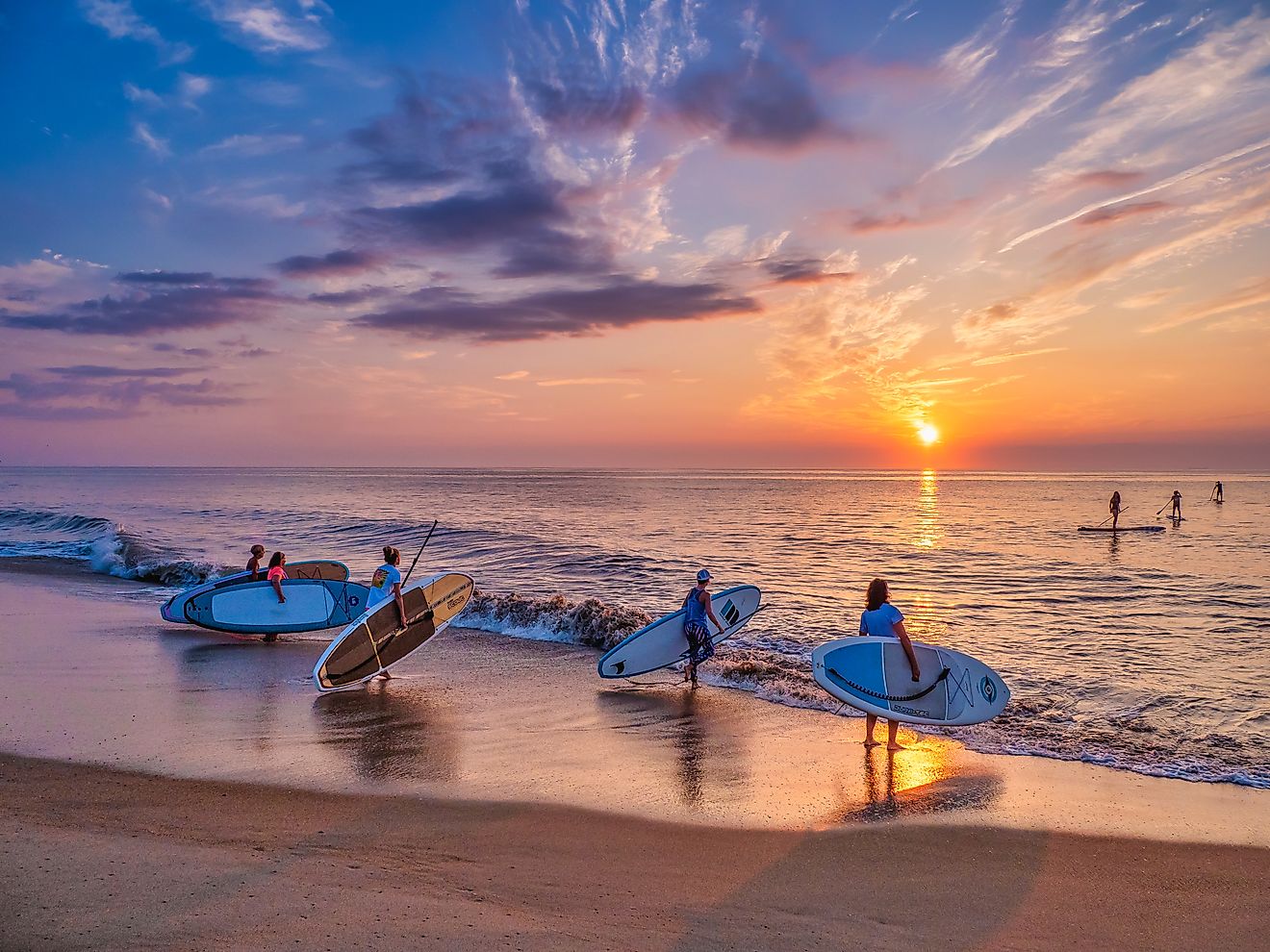
The Most Picturesque Small Towns in Delaware
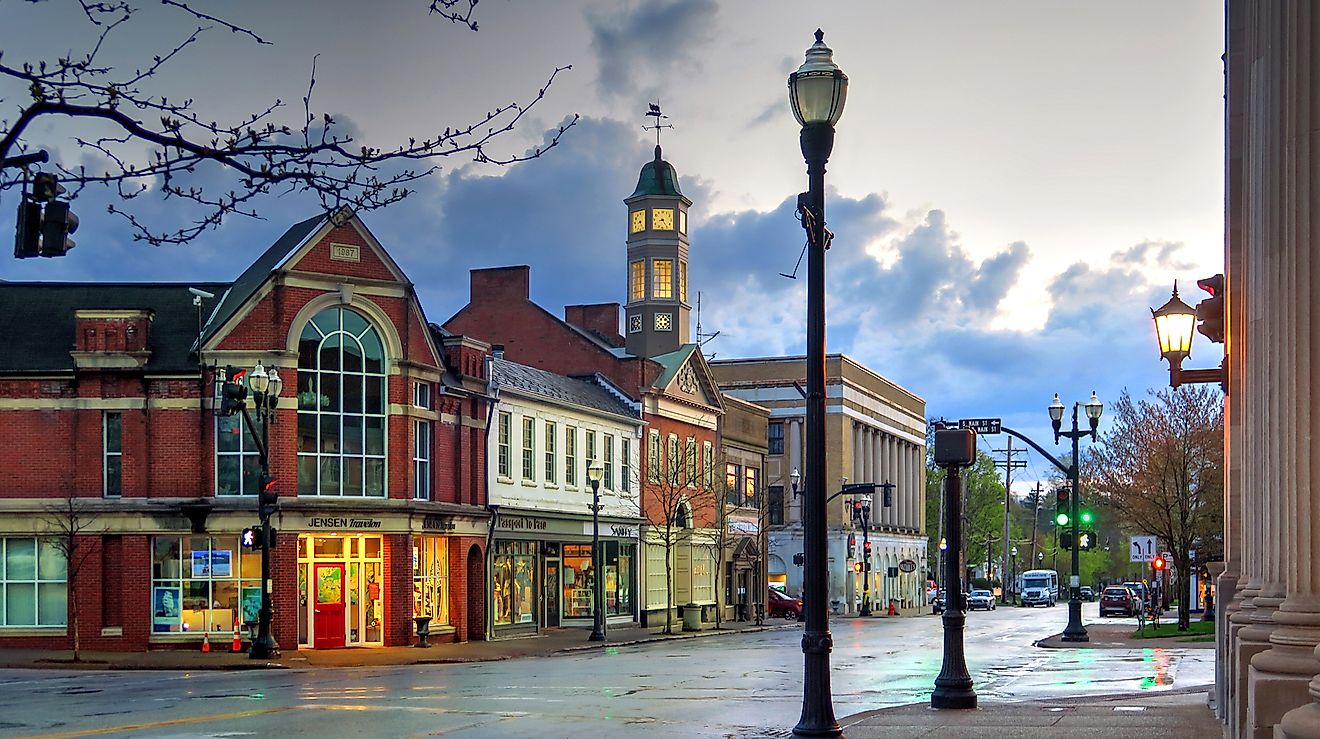
8 Of The Most Walkable Towns In Ohio
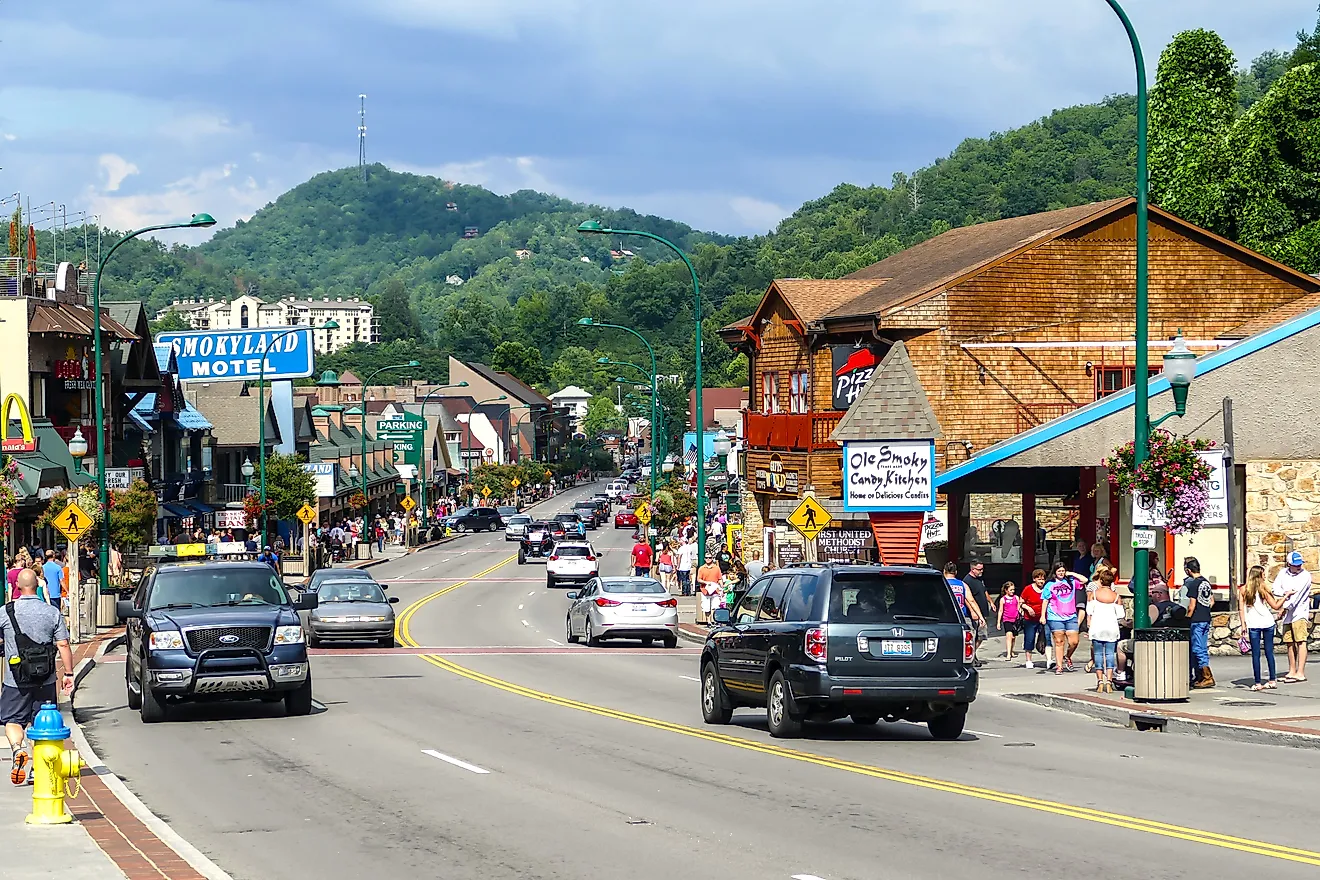
8 Towns In Tennessee With Thriving Local Businesses
The best time to go to Spain
Jul 10, 2023 • 4 min read
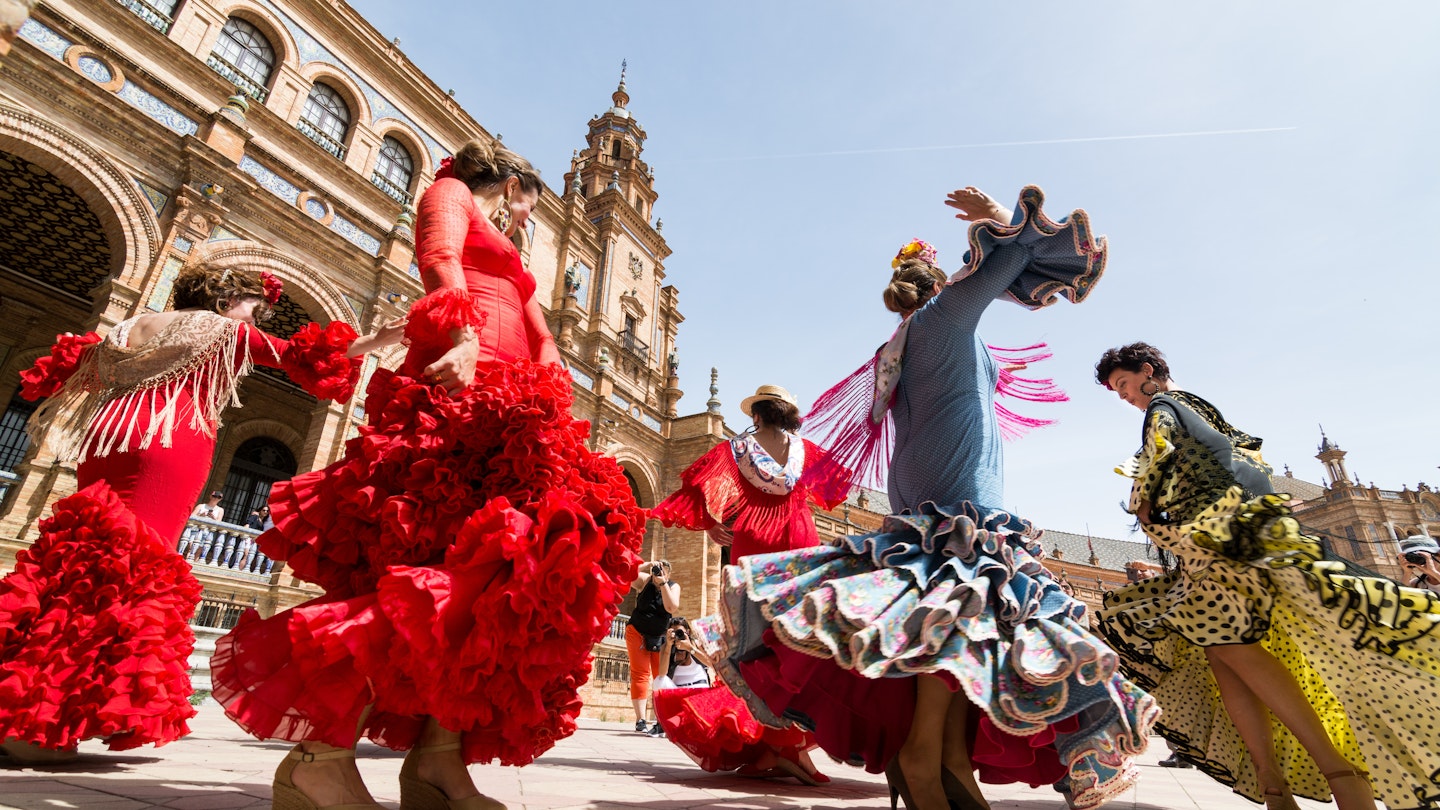
Season after season, Spain offers a rich and diverse range of experiences © leonov.o / Shutterstock
Spain consistently ranks as one of the most-visited destinations in the world for good reason. This vibrant and multifaceted European country has attractions that resonate with every kind of traveler.
Whether you’re a culture enthusiast seeking to immerse yourself in art and architecture , a sun worshipper looking for spectacular beaches and islands , a passionate gourmand embarking on a culinary tour or even a spiritual adventurer wishing to retrace the footsteps of pilgrims , Spain is one of those rare destinations that offers a rich and diverse range of experiences, season after season.
Consider what you’re looking for in a visit to Spain and plan ahead. Are you traveling on a shoestring budget? Looking for the best time to soak up the sun on a sandy coastline, or eager to feast in a harvest festival?
Here are some of the best times to visit this fascinating Iberian destination.
April to May and September to October are the best times for perfect weather
In central Spain and on the Mediterranean coast, the spring and autumn seasons are marked by sunlit days and pleasant weather perfect for strolling and outdoor dining in terrazas , with temperatures cooling down by nightfall.
Conversely, the summer months of July to August are scorching, with temperatures in central and southern Spain reaching the mid-to-high 40s°C. Madrid empties out in August , as locals go on summer holidays and many establishments close to avoid the oppressive heat. These summer months are ideal for visiting the northern regions , such as Asturias , País Vasco (Basque Country), Galicia and Cantabria , which have milder temperatures.

May to September is the best time to hit the beach
Spain is blessed with nearly 5000km (3107 miles) of coastline, stretching from the Atlantic Ocean to the Mediterranean Sea. Archipelagos in the Balearic Sea and off the northwestern African coast cap off the country’s maritime allure.
When the weather starts warming up in the wake of spring, Spanish beach destinations come to life, hitting their peak in August. Ibiza reaches its peak party atmosphere in July and August, when top DJs fly in to play in its world-famous clubs. If you wish to avoid crowded shorelines, opt for going in May and June.
April to May and September to October are the best times to walk the Camino de Santiago
The popular period for walking this thousand-year-old pilgrimage route towards Santiago de Compostela is between May and September, for favorable weather and longer daylight hours. To avoid those busy months, opt for the spring and autumn shoulder seasons when trails are less crowded, offering a more tranquil and introspective experience.
September to October is the best time for enjoying wine-harvest festivals
Oenophiles will particularly enjoy visiting Spain’s most famous wine-making regions, such as La Rioja and Ribera del Duero , during the traditional harvest season that starts in September. Logroño, the capital of La Rioja, kicks off its San Mateo festival, where you can take part in grape-crushing activities, parades and, of course, exquisite wine tasting for astoundingly low prices per copa .
For an off-the-tourist-radar experience, visit Valdepeñas in the Castilla-La Mancha region on the first week of September, when the entire town takes its love of vino to a whole new level with the annual harvest festival, featuring a wine tunnel and wine-tasting events in subterranean bodegas (wineries). There’s even a wine bus to take you home after a whole day of Dionysus worship.
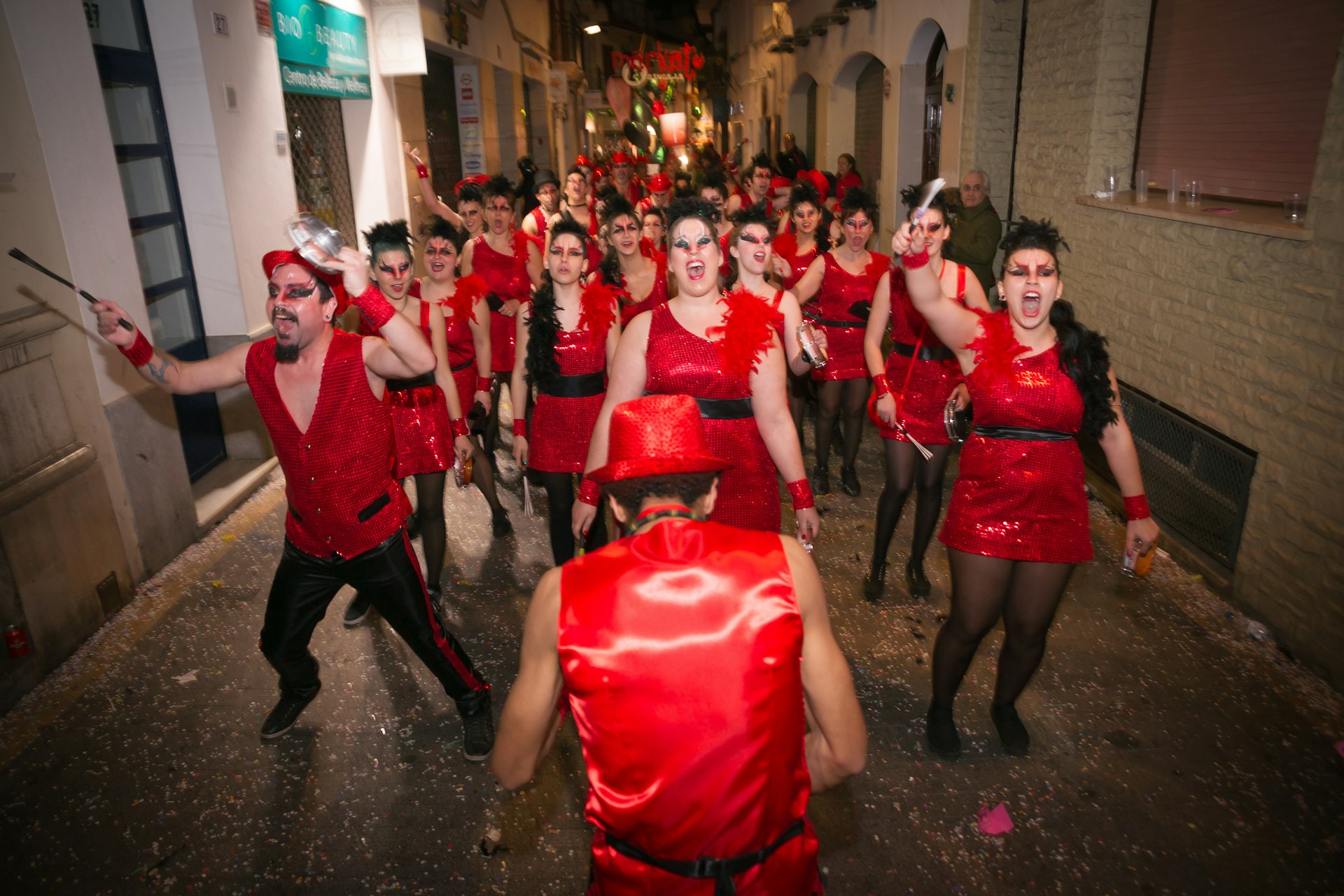
November to February is the best time for budget travelers
Spain’s winter season attracts fewer tourists, so prices are generally lower on accommodations and flights. Winter can actually be a great time to bundle up and visit Madrid and Barcelona , which come alive with Christmas lights, outdoor markets and holiday festivities.
November to January is the best time to indulge in olive-oil festivals
The annual olive harvest season is celebrated with olive-oil festivals all over the country, especially in the regions of Andalucía and Catalonia. Check out the gastronomic agenda for the Martos Olive Festival in the city of Jaen, which takes place annually on December 8, while the Siurana Olive Oil Fair happens every November.
January to February and July to August are the best times for sales shopping
Usually held after Christmas and the during summer holidays, when people have time to shop, the traditional rebajas (sales) periods in Spain is regulated by the Spanish government to protect consumers and local businesses. During these winter and summer sales seasons, bargain hunters can stretch their shopping budget, as stores use this time to clear their inventory and offer significant discounts reaching up to 70% off.
January to April is best time to try calçots
La Calçotada is a yearly gastronomic festival in the Catalonian region , where large groups gather to eat grilled calçots – a type of green onion harvested in the winter – dipped in delectable sauces.
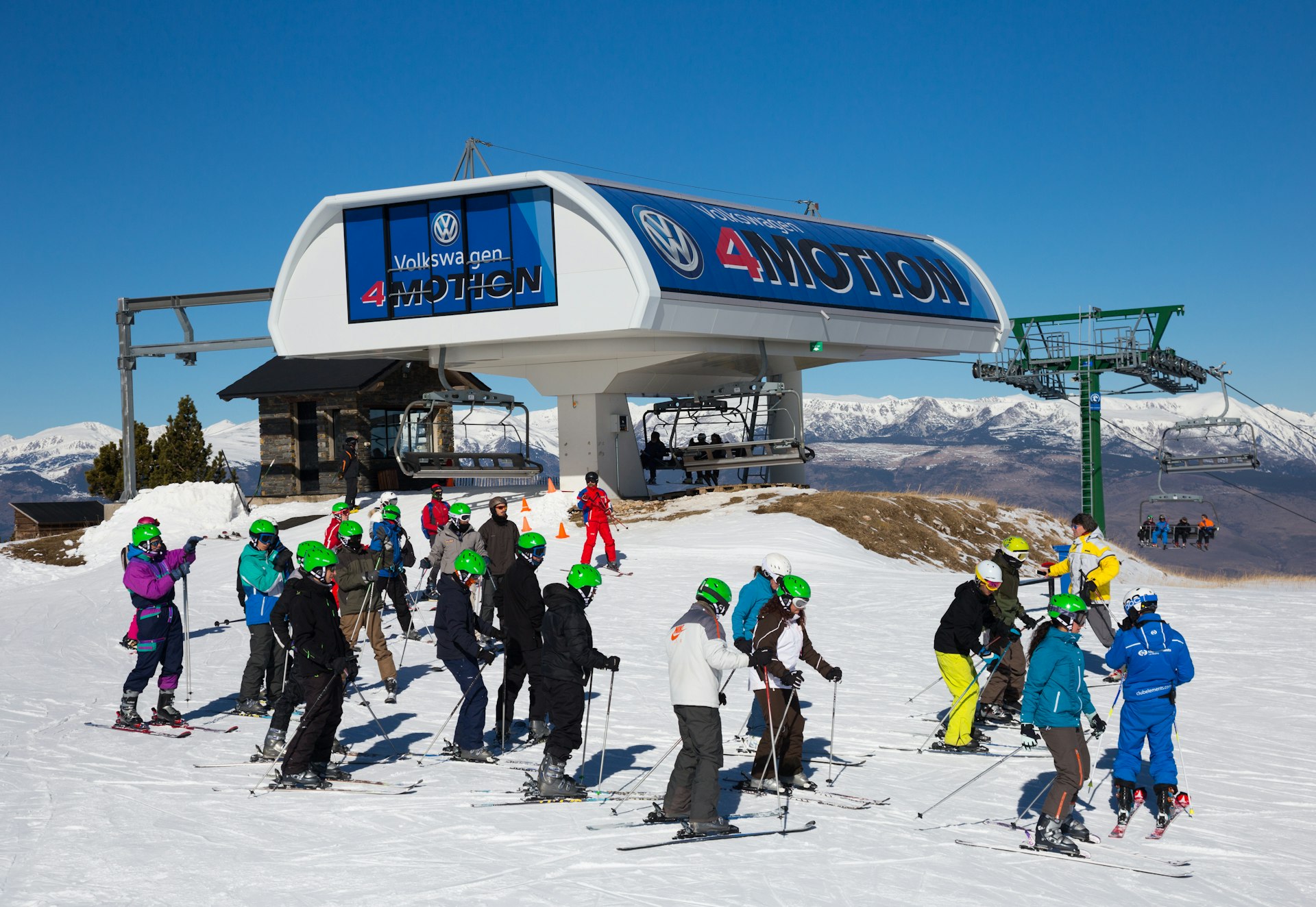
January to March are the best times for skiing
Ski resorts usually open in December and close right after Easter in April. Peak snow conditions run from January to March in the Pyrenees and January to February in Central Spain. In southern Spain near Granada, the Sierra Nevada has a surprisingly longer ski season that can sometimes last until May.
This article was first published Apr 29, 2021 and updated Jul 10, 2023.
Explore related stories

Destination Practicalities
May 30, 2024 • 10 min read
Our first-time guide to Palma de Mallorca gives you a taste of what’s here, but you’re sure to find treasures of your own, too.

May 27, 2024 • 6 min read

May 23, 2024 • 17 min read

May 21, 2024 • 10 min read

May 21, 2024 • 11 min read

May 20, 2024 • 5 min read

May 3, 2024 • 6 min read
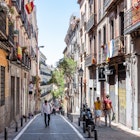
Apr 30, 2024 • 4 min read

Apr 19, 2024 • 10 min read

Mar 31, 2024 • 6 min read

IMAGES
VIDEO
COMMENTS
8. Tui. Situated on the banks of the Miño River, right on the border with Portugal, Tui is a charming Galicia town where history and tradition intertwine. Known for its captivating medieval ambiance, the heart of Tui is its old town.
6. Cíes Islands. If you're compiling a list of must-see places in Galicia, the Cíes Islands are a non-negotiable addition. Often referred to as the "Galician Caribbean," these islands boast some of the finest white-sand beaches and crystal-clear waters in Spain.
Galicia. Its capital, Santiago de Compostela is the final destination on the Way of Saint James, the famous pilgrim route. For this reason alone it is worth visiting this region in Green Spain. You'll love its landscapes full of green wooded valleys, and its amazing beaches. All along the length of its coastline, bathed by the Cantabrian Sea ...
Galicia gives travellers an alternative Spanish experience. With its strong Celtic connections, wild beaches and arguably the best seafood in Europe, this unique region in Spain's northwest remains largely unexplored by the tourists flocking to Barcelona or the Costa del Sol.. While Santiago de Compostela is Galicia's most famous city and one of the world's biggest international ...
13. Visit San Andrés de Teixido. Located in the municipality of Cedeira, San Andrés de Teixido is a small sanctuary and pilgrimage site by the highest cliffs in mainland Europe. Apart from Santiago de Compostela, it is one of the most famous pilgrimage sites in Galicia and is worth the incredible uphill trek.
Some of the most popular ones are As Burgas, in the center of the old town, and Outariz hot spring. Don't forget to visit the Cathedral of Ourense, the medieval bridge of Ourense, Plaza del Hierro, San Lazaro Park and San Francisco Convent. 15. Visiting Souto da Retorta, one of the best things to do in Galicia.
1. Cathedral De Santiago de Compostela. 10,811. Historic Sites. Historic cathedral with Romanesque and Gothic elements, home to the revered St. James. Features elegant interiors, baroque chapels, and a unique rooftop tour with panoramic views. See ways to experience (30) 2023. 2.
Monte de Santa Trega. Galicia. The 341m summit of Monte de Santa Trega is a 4km drive or 2km walk (via the PRG122) from town. On the way up, stop to poke around the partly restored Iron….
A comprehensive guide to the Spanish region of Galicia. When to visit, how long to spend, where to stay, unique things to see and do, and a full 7-day itinerary. ... the train is now by far the easiest and most comfortable way to travel to Galicia if coming from Spain's capital. The connection between Santiago de Compostela and Madrid takes ...
Ouissal Elmrayej Cities galicia, Monuments, nature. Galicia is an autonomous region that lies in the Northwest of Spain, above Portugal. It is an ideal destination for spending your vacation. It has lush green, historic cities, stunning coasts, and beautiful beaches.. Here is our list of the top 10 beautiful places you must see in Galicia.
Galicia. Spain, Europe. Galicia, a unique region with its own language and distinctive culture, is home to Santiago de Compostela, the destination of more than quarter of a million souls who travel each year along the Camino de Santiago pilgrim trails. Santiago is one of Spain's most beautiful and magical cities, an exceptionally good reason ...
Camino de Santiago. A network of paths leading to a church holding the remains of St. James (Santo Iago), the patron saint of Spain... 5. Plaza del Obradoiro. Large, pleasant city plaza containing the church of St. James. 6. MEGA Museo Estrella Galicia. MEGA es un museo único en España.
3 | Walk the Most Galician Camino de Santiago Route. Those who really want to see the best of Galicia will love walking the Camino de Invierno route.The Camino de Invierno is said to be the most Galician Camino de Santiago route since it is the only Camino route that passes through all four provinces of Galicia (Ourense, Lugo, Pontevedra, A Coruña).
Galicia Birding. Official app with birding routes for tourists in Galicia. The Axencia Turismo de Galicia provides this app to assist you on your visit to Galicia as a bird-watching tourism destination. It will help you thoroughly explore the most important bird-watching spots in Galicia through birding routes designed especially for tourists.
3. Cape Finisterre. by demiku.es. My favorite place in Galicia is undoubtedly Finisterre Cape, the "End of the Earth" (Finis Terrae) of the Romans. This corner on the Death Coast is a rather magical one, so much so that now many pilgrims choose not to end the Way in Santiago de Compostela but in Finisterre.
Updated: June 30, 2023 by Matt. Galicia is a beautiful region located in the northwest corner of Spain, bordered by the Atlantic Ocean to the west and Portugal to the south. It is a land of lush green landscapes, rugged coastline, and a rich cultural heritage. Galicia has a long and varied history, shaped by its Celtic, Roman, and medieval past.
Get support from our local experts forstress-free planning & worry-free travels. Plan your visit to Galicia, Spain: find out where to go and what to do in Galicia with Rough Guides. Read about itineraries, activities, places to stay and travel essentials and get inspiration from the blog in the best guide to Galicia.
Ribadeo is a hotspot in summer for Spaniards seeking cooler climates and a cool caña of the local Estrella Galicia beer. High among reasons to visit this blustery township include its striking colonial-style manor houses, its exquisitely preserved, colourful old quarter, and the nearby Isla Pancha - the location of Spain's first lighthouse ...
With its Gothic structure and rich history, the Catedral de Ourense is a must-see if you are traveling to Ourense, Galicia. An important monument and perhaps a throwback to the Catedral de Santiago de Compostela, in the light of the imitative Door of Paradise, this basilica has its own unique story. It was rebuilt in the 13th century, having ...
With its spectacular rugged coastline, rolling green hills and soaring mountains, it's no wonder that Spain 's northwestern region of Galicia is home to some beautiful towns and villages. Here's our pick of some of the most picturesque. 1. Combarro. Share. Add to Plan. ©Guillén Pérez / Flickr. Said by many to the be the most beautiful ...
A UNESCO World Heritage site, Lugo is an ancient city in the interior of the region, one of the most interesting cities of Galicia and arguably one of the best places to visit in Galicia. The city lies about 60 miles east of Santiago de Compostela. Lugo's most outstanding features is that it is completely surrounded by its original Roman wall ...
To get an idea of how Neolithic people lived and made art, we recommend a trip to Galicia. The Campo Lameiro Archaeological Park has Europe's largest collection of petroglyphs (engraved rock art). Here you can see, for example, one of the most beautiful rock engravings of a deer. The dolmens are just as surprising, constructions of great ...
Drive further onto the rocky cliffs as this Galicia road trip itinerary returns to the sea. Built in 1984 and standing 80 metres tall, the Faro de Punta Roncadoira Lighthouse brushes away any cobwebs from the night before. Lighthouses. Big business in Galicia - and also in Sargadelos ceramics.
Pontevedra, a city with a long maritime and trading tradition, boasts one of the largest and most elegant historic quarters in the whole of Galicia. Situated on the edge of the estuary of the same name, the old town extends in a network of streets and squares and contains major civic and religious buildings. Called Ad Duos Pontes by the Romans ...
It produces some excellent wines. Galicia is actually one of Spain's best wine-producing regions, making some top quality white wines. The best areas to visit for wine here include the Rías Baixas, Ribeira Sacra, D.O. Monterrei and O Ribeiro. Read our article on ' The Ultimate Tour of Galicia's Best Wine Routes ' to learn more.
Spain Tourism: Tripadvisor has 32,113,087 reviews of Spain Hotels, Attractions, and Restaurants making it your best Spain resource. ... Los Montes de Galicia. 12,117 $$ - $$$ • Spanish, International, Mediterranean. Madrid, Spain. 2023. ... 6 must-visit cities in Spain. From . Tripadvisor. 5 best tapas restaurants in Barcelona for your next ...
With an area of 505,990 sq. km, Spain is the largest country in Southern Europe and the 4 th largest country in the continent of Europe. It is also the 2 nd largest country in Western Europe and EU. Spain has a population of over 47 million, making it the 6 th most populous country in Europe and the 4 th most populous country in EU. Located in ...
Galicia's humidity makes it ideal for mildew and other grape-harming fungi to flourish. Increased fungal outbreaks have been correlated with effects of climate change, like higher temperatures and more concentrated rainfall, so future wine-growing conditions may favor more fungi-resistant varieties, Morales says.
November to February is the best time for budget travelers. Spain's winter season attracts fewer tourists, so prices are generally lower on accommodations and flights. Winter can actually be a great time to bundle up and visit Madrid and Barcelona, which come alive with Christmas lights, outdoor markets and holiday festivities.
Temperatures are rising. Hotel prices are exploding. And travelers are already behaving badly. Welcome to another summer in Europe. From the headlines, things already look chaotic. Famous sites ...